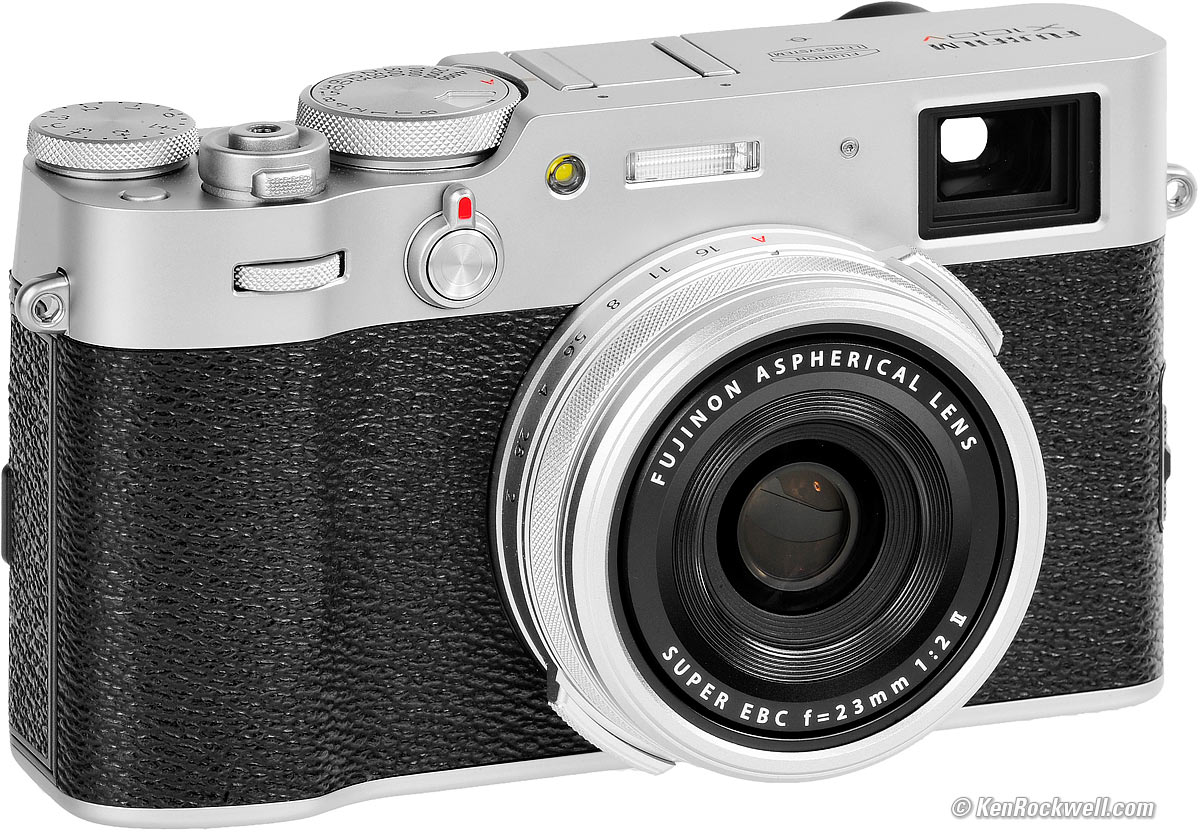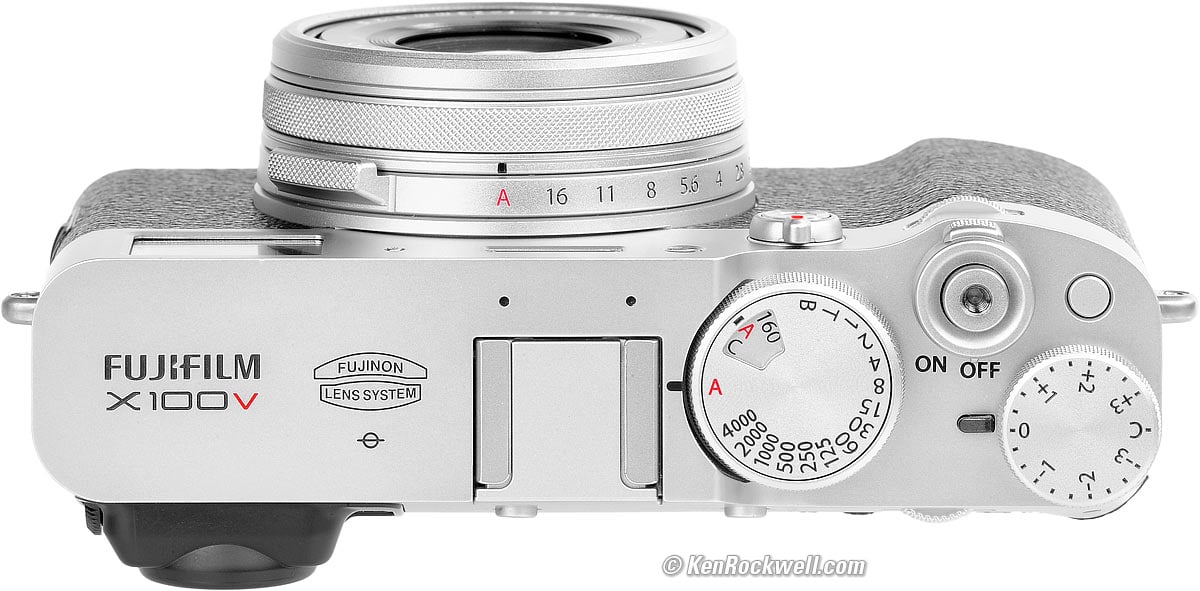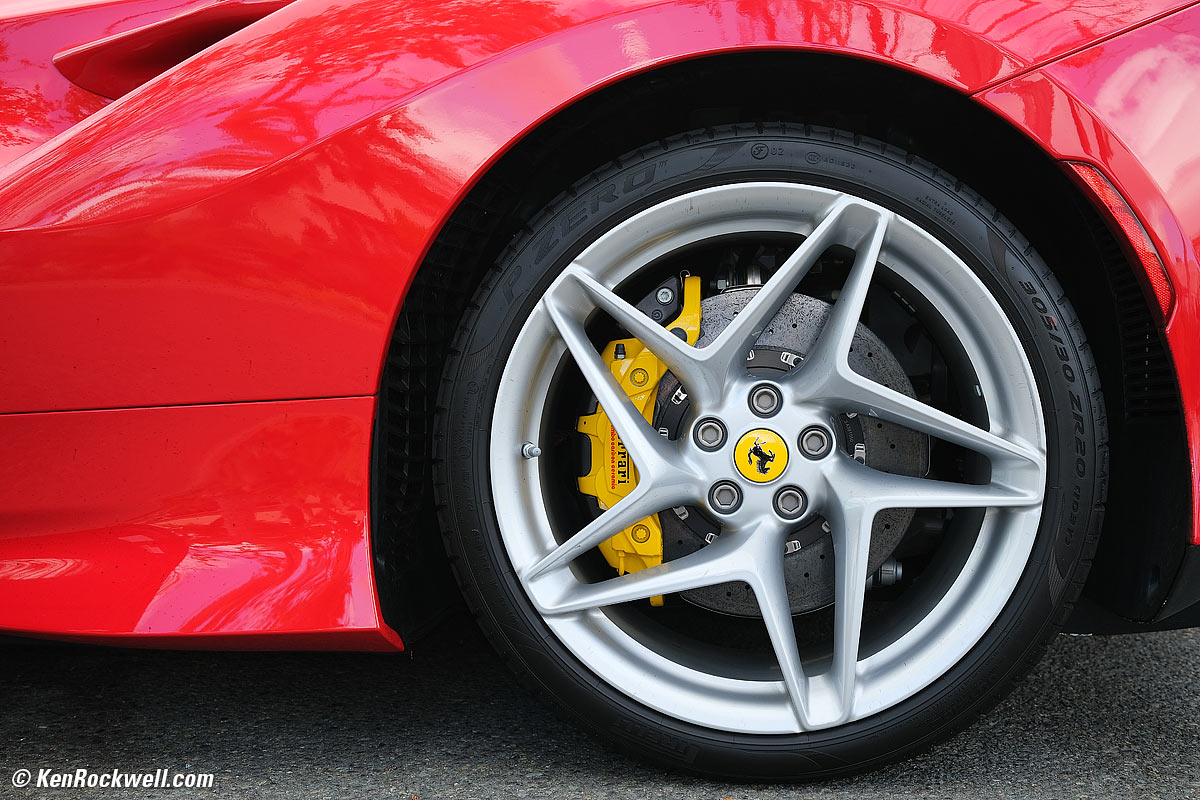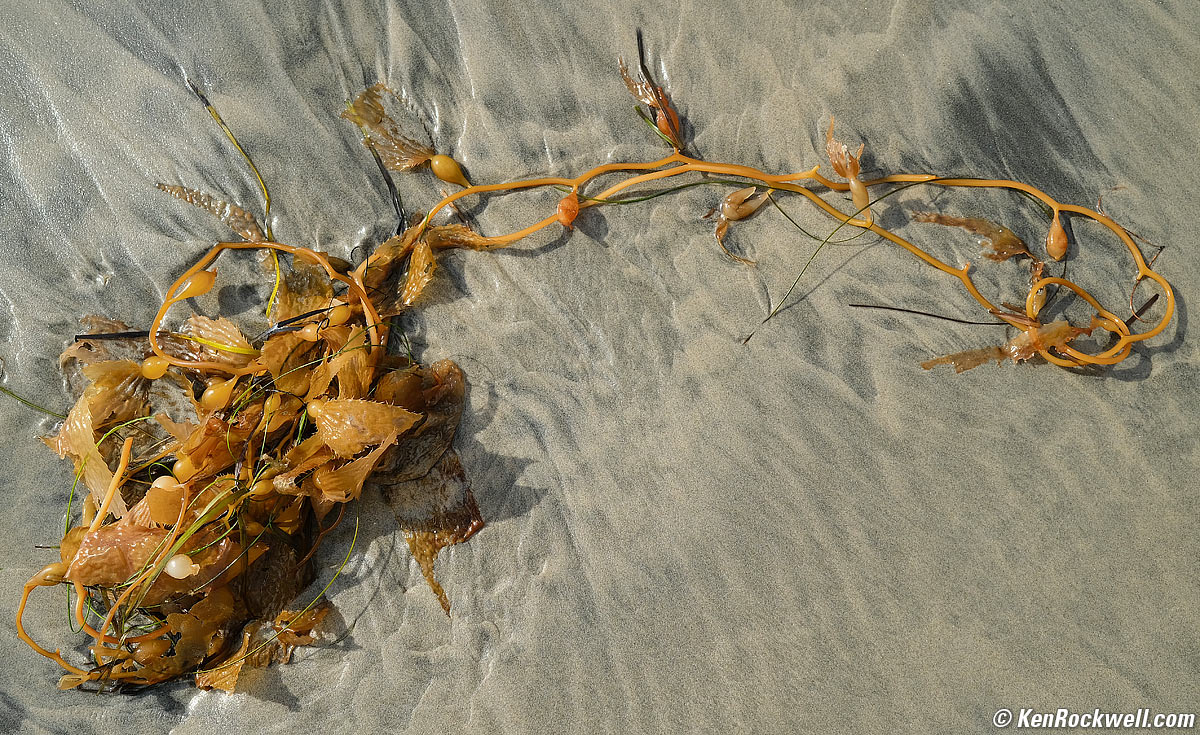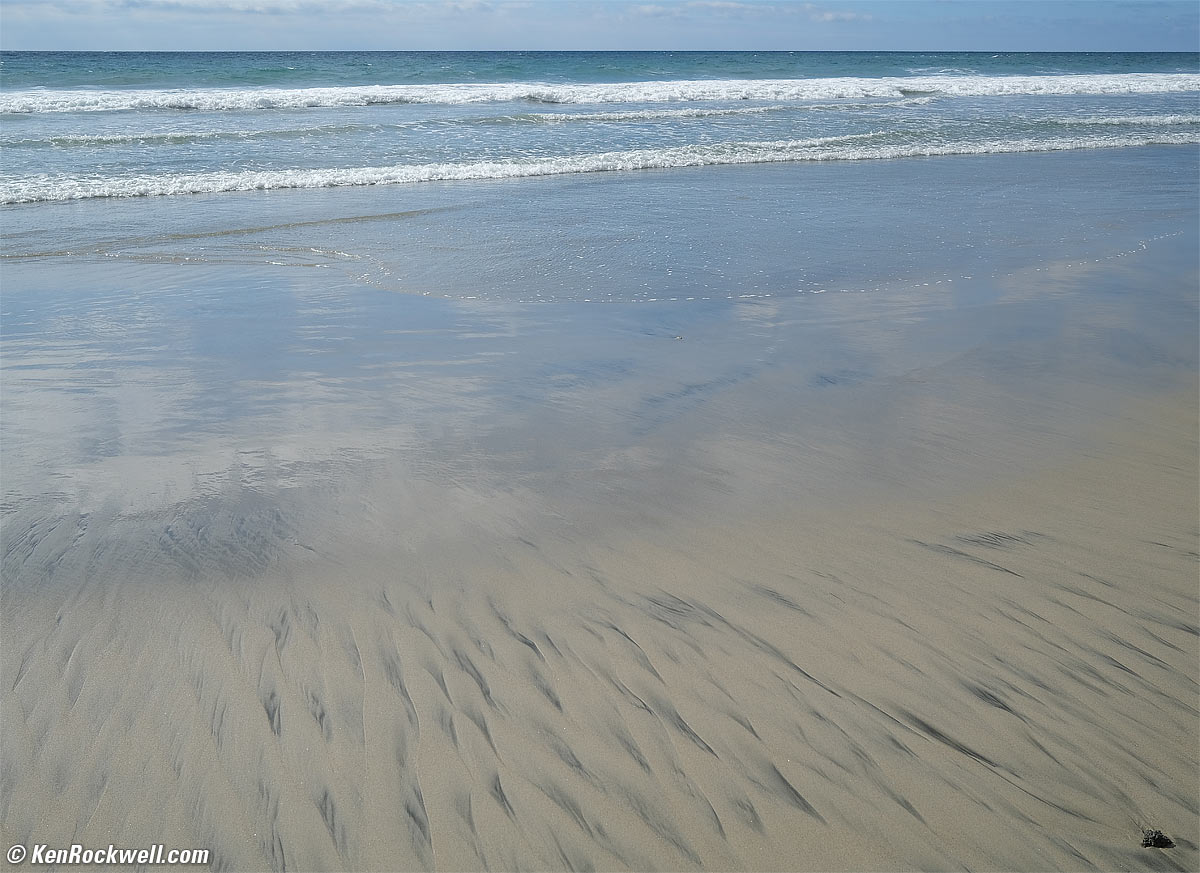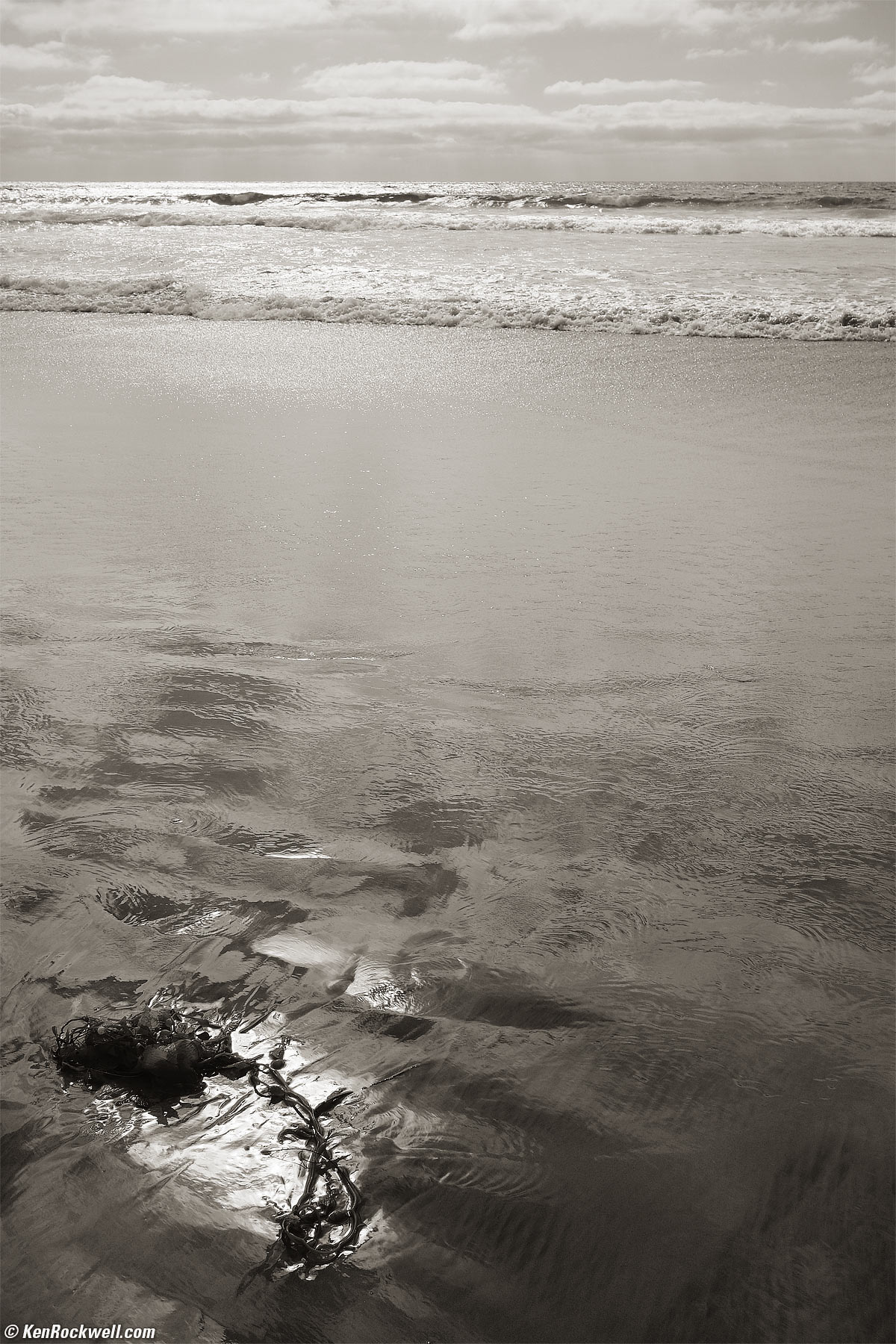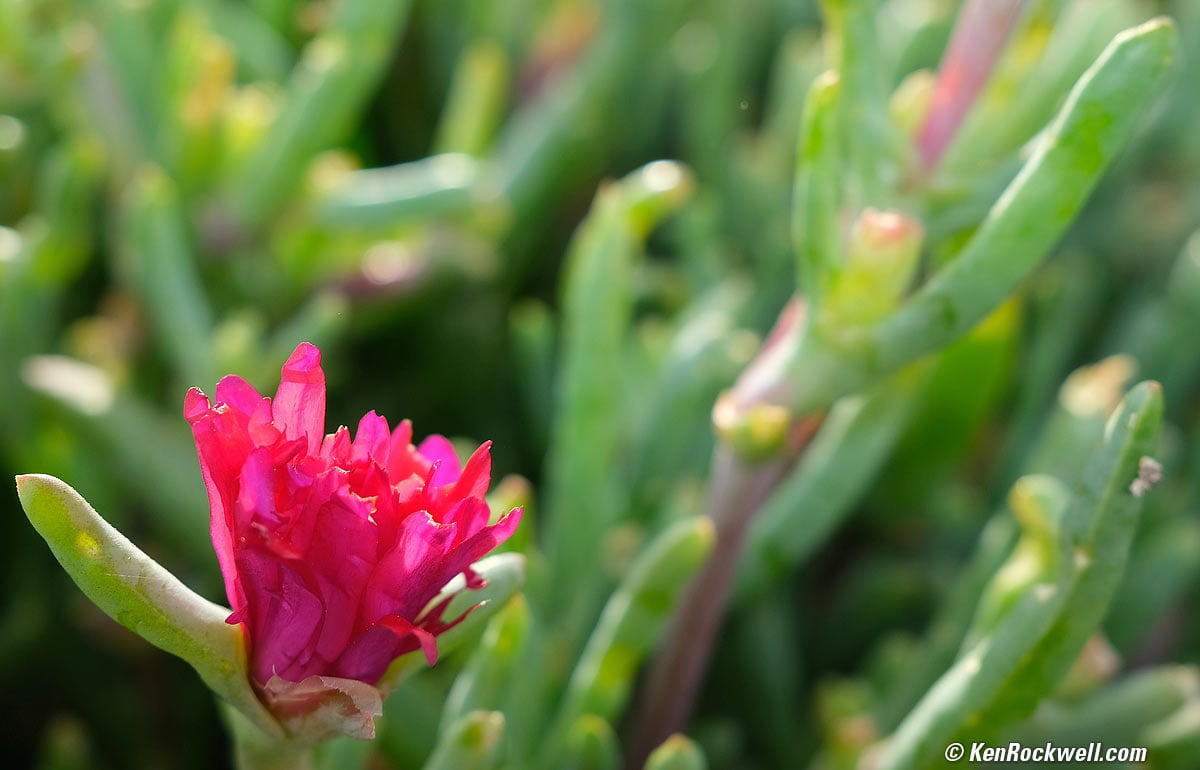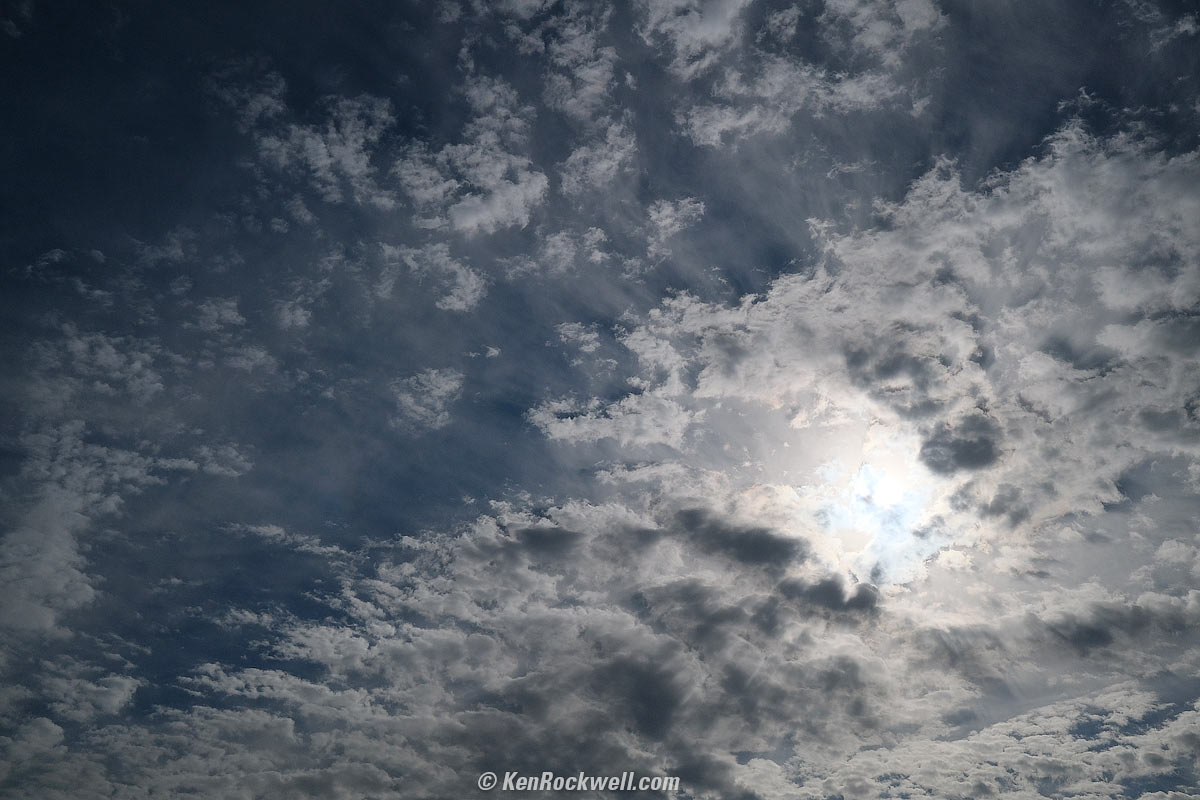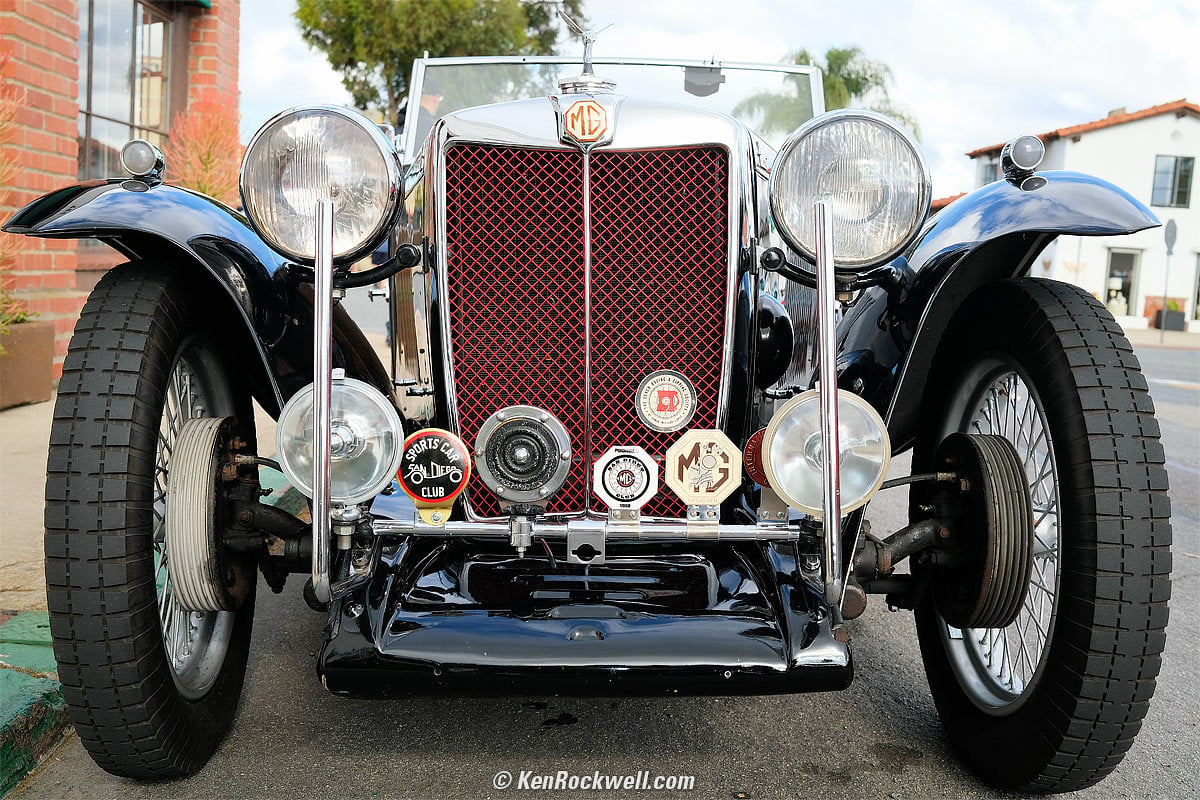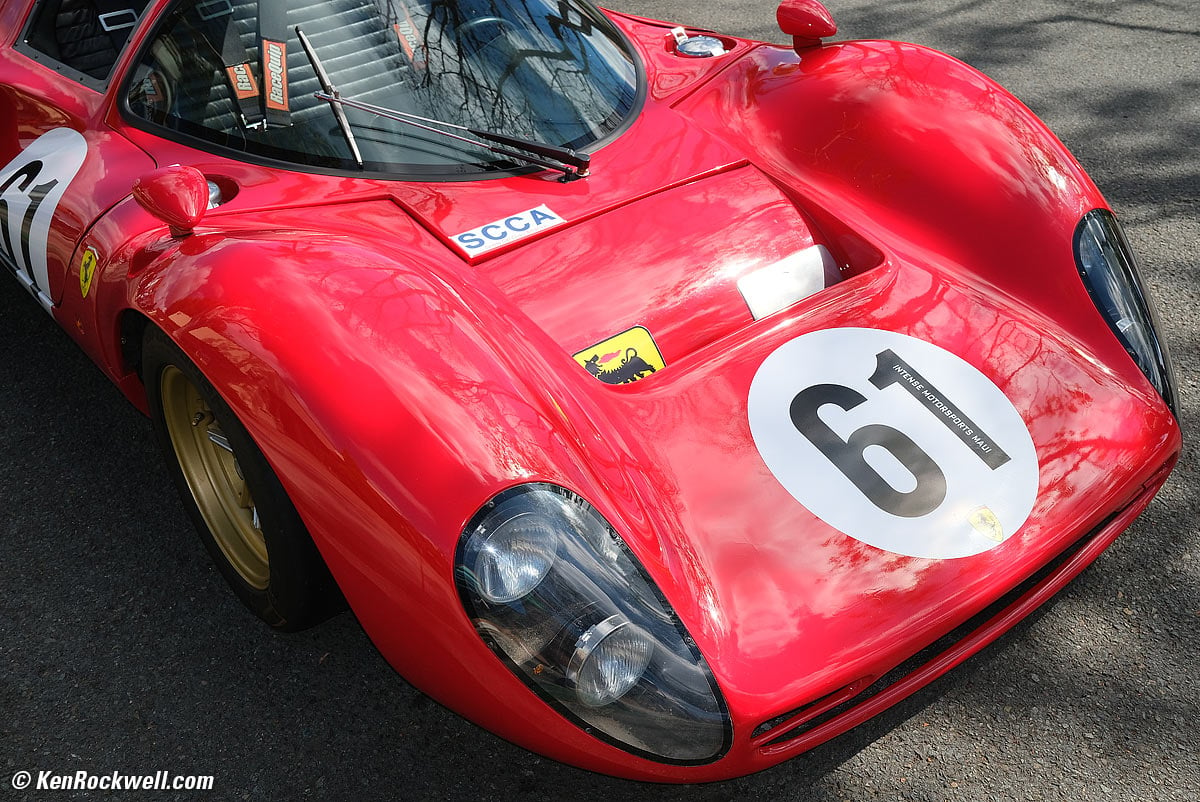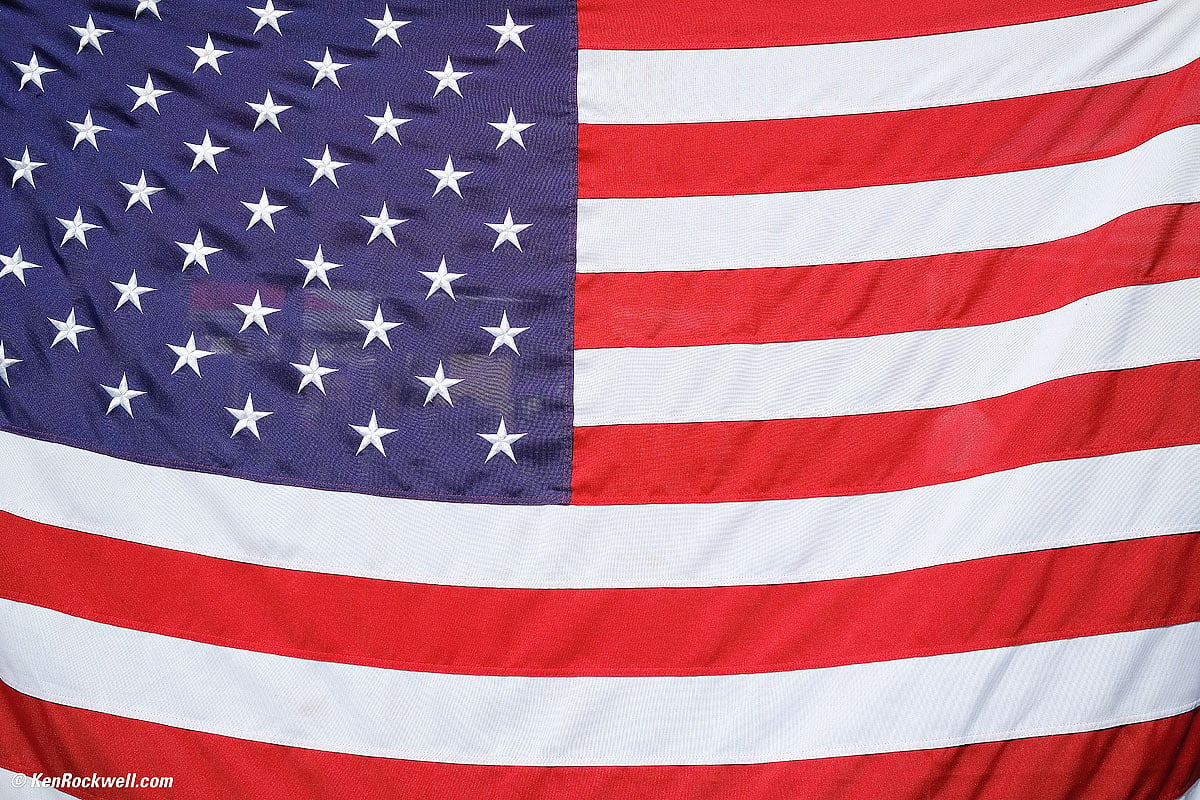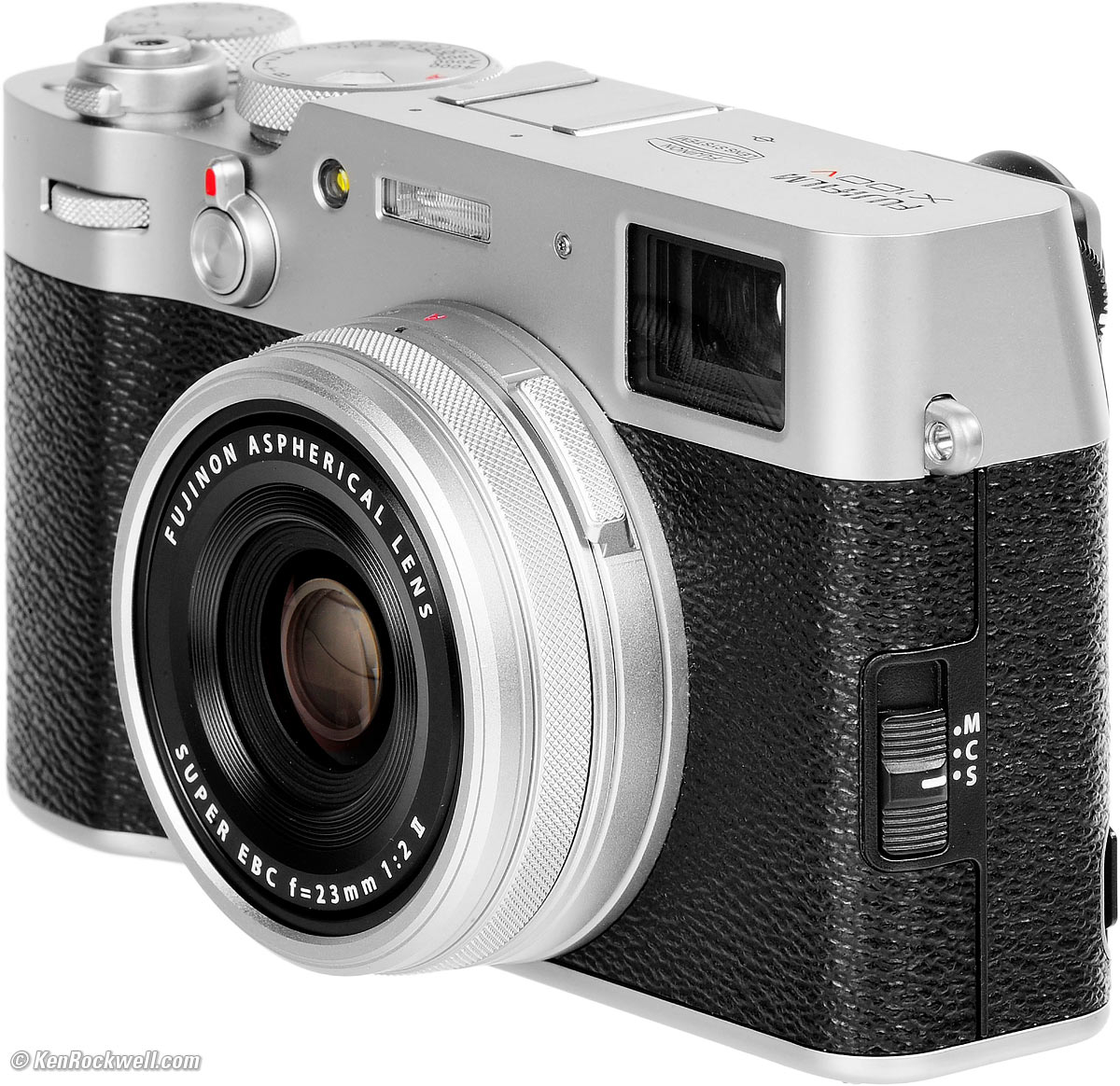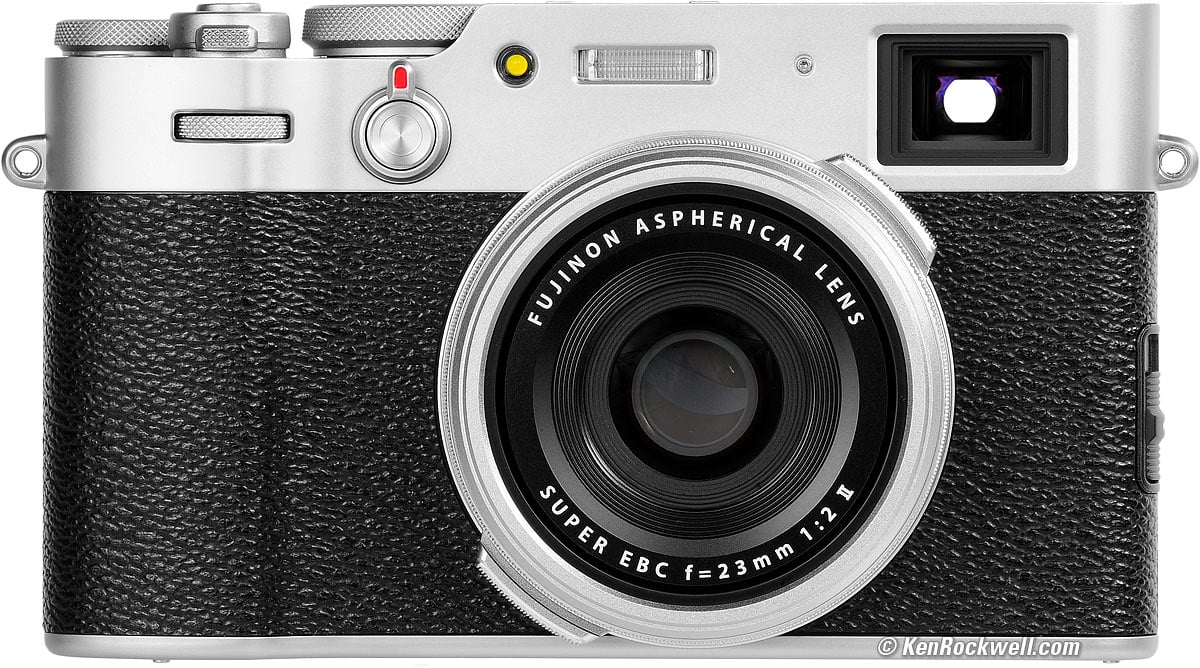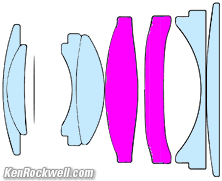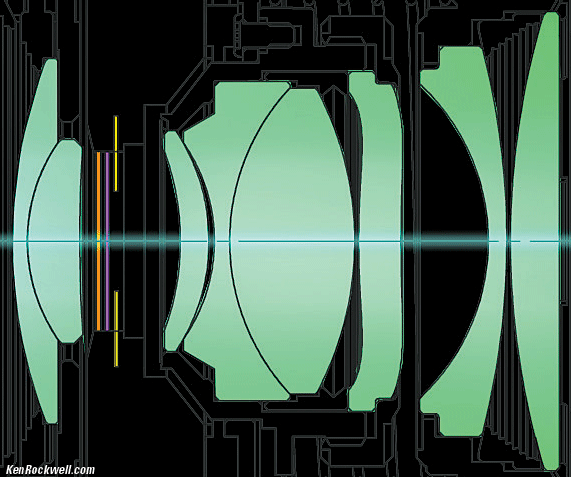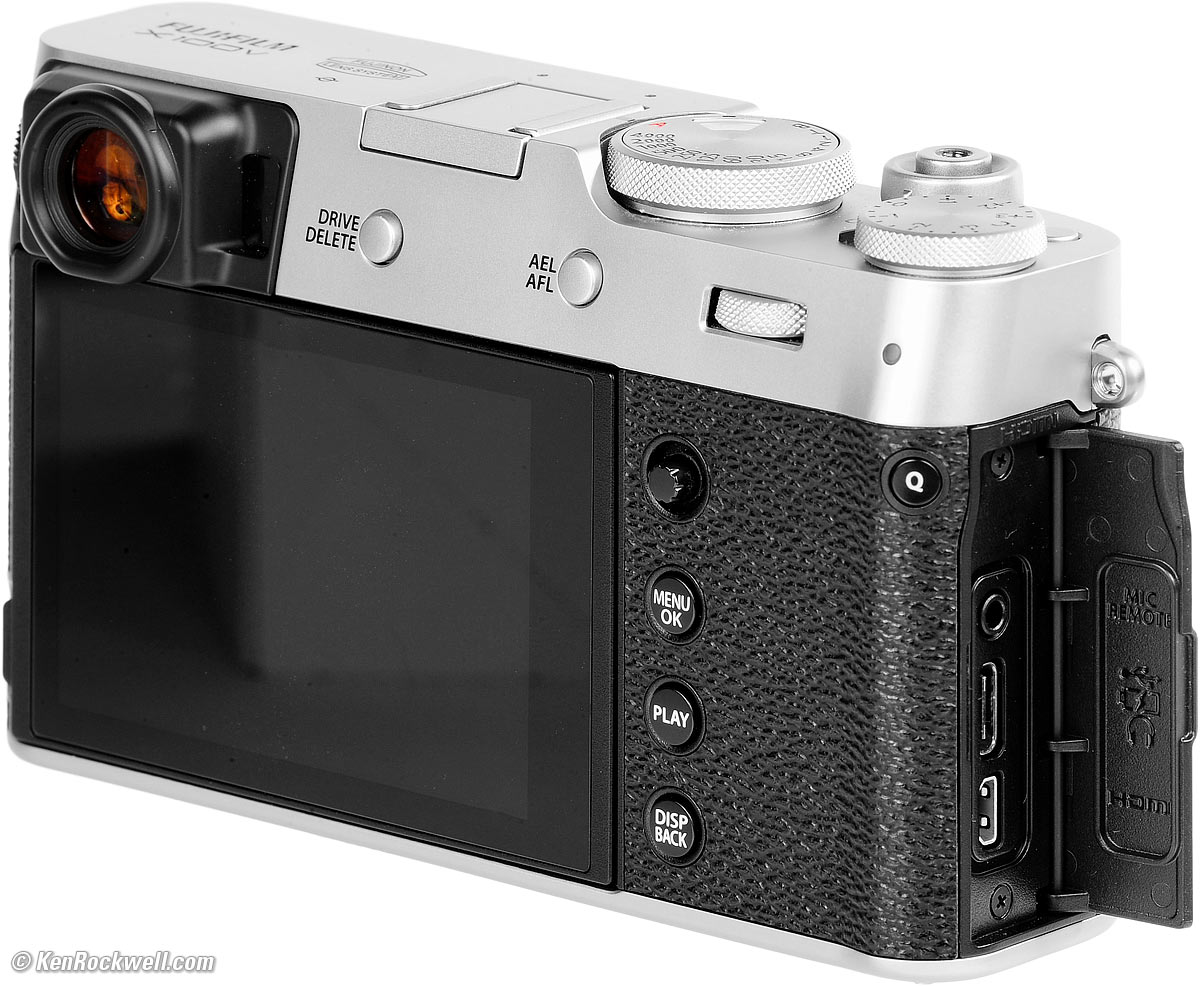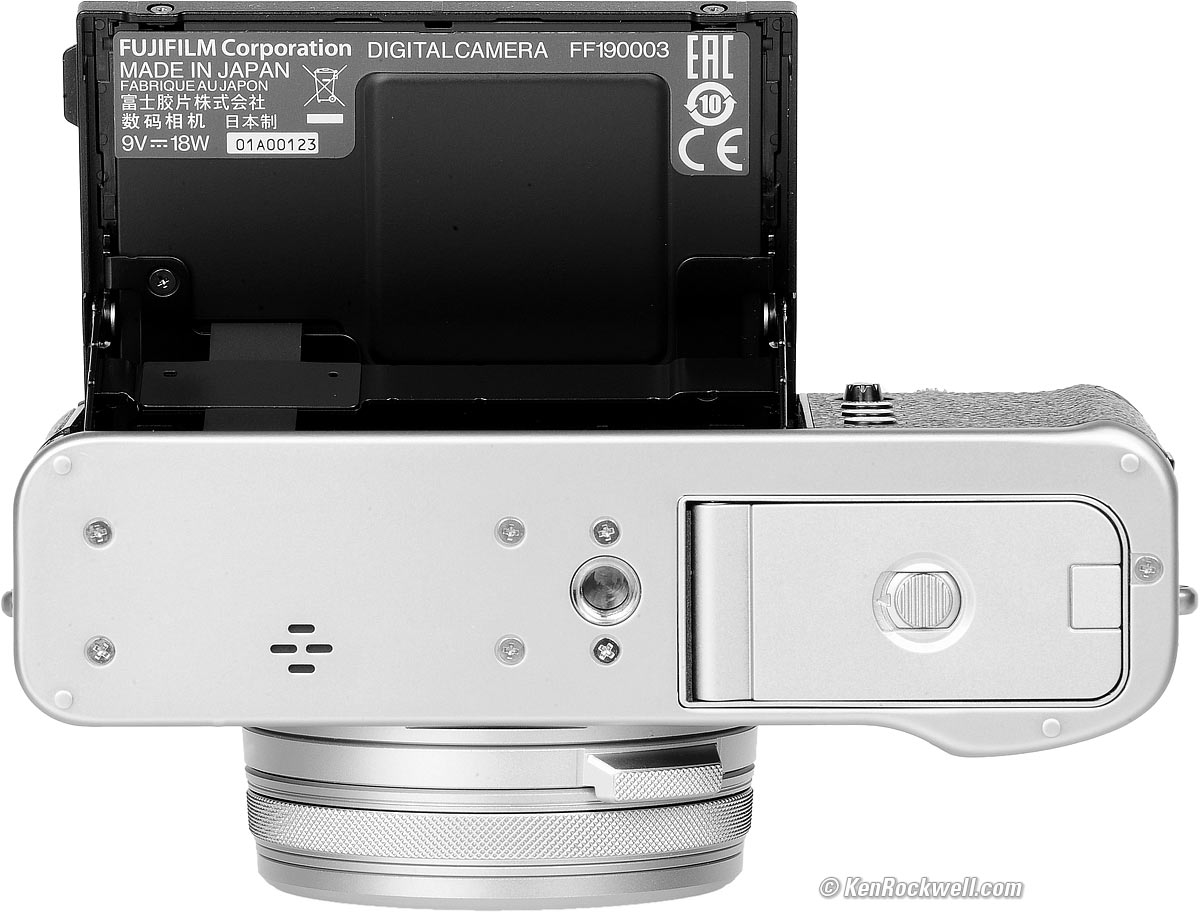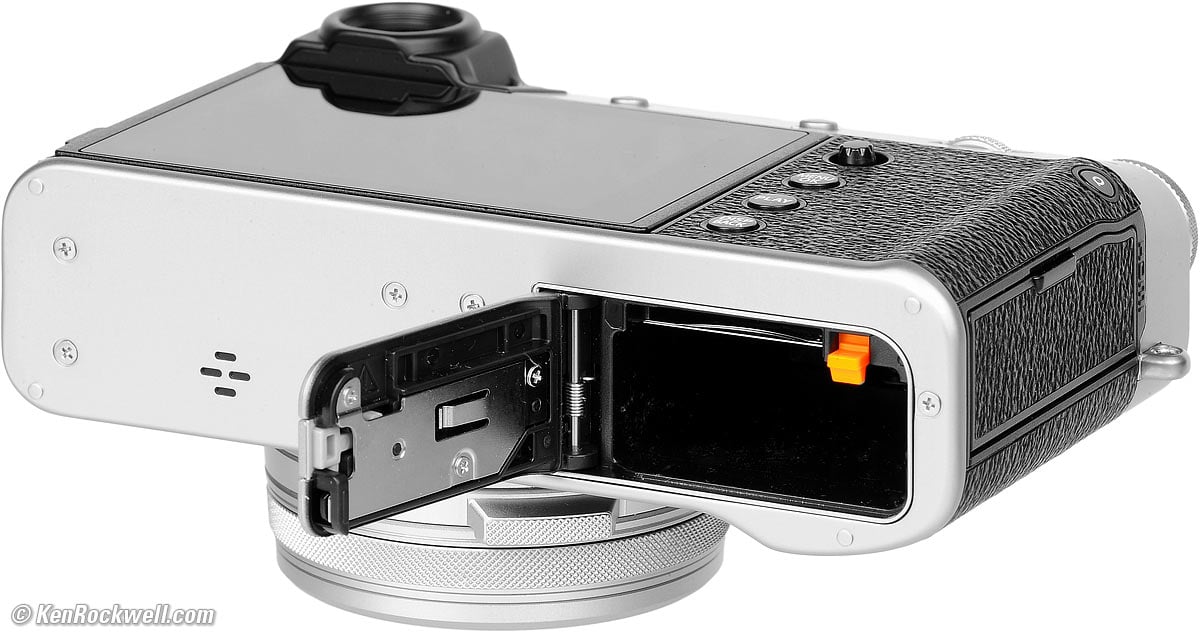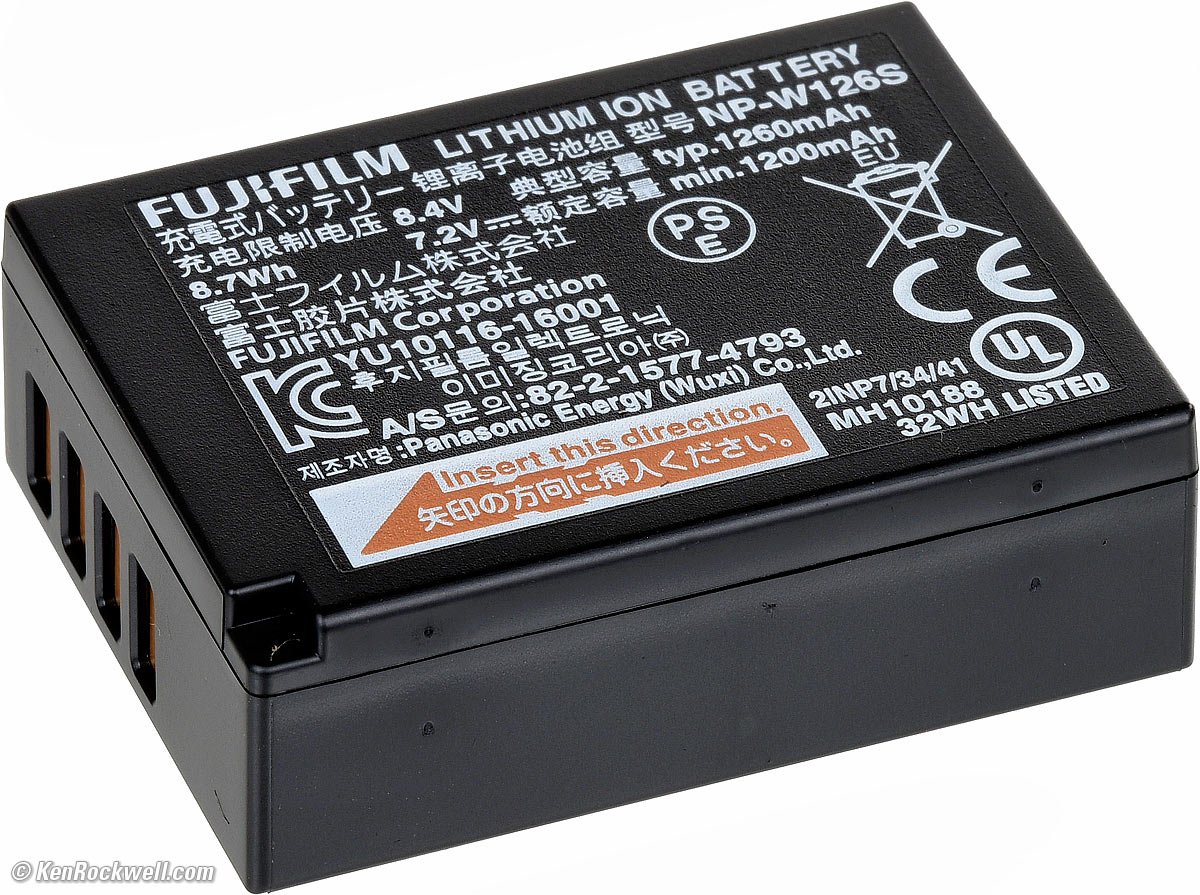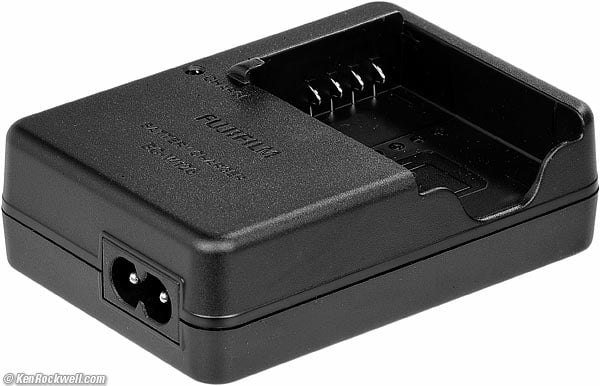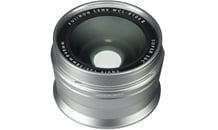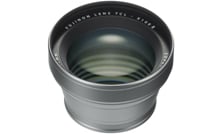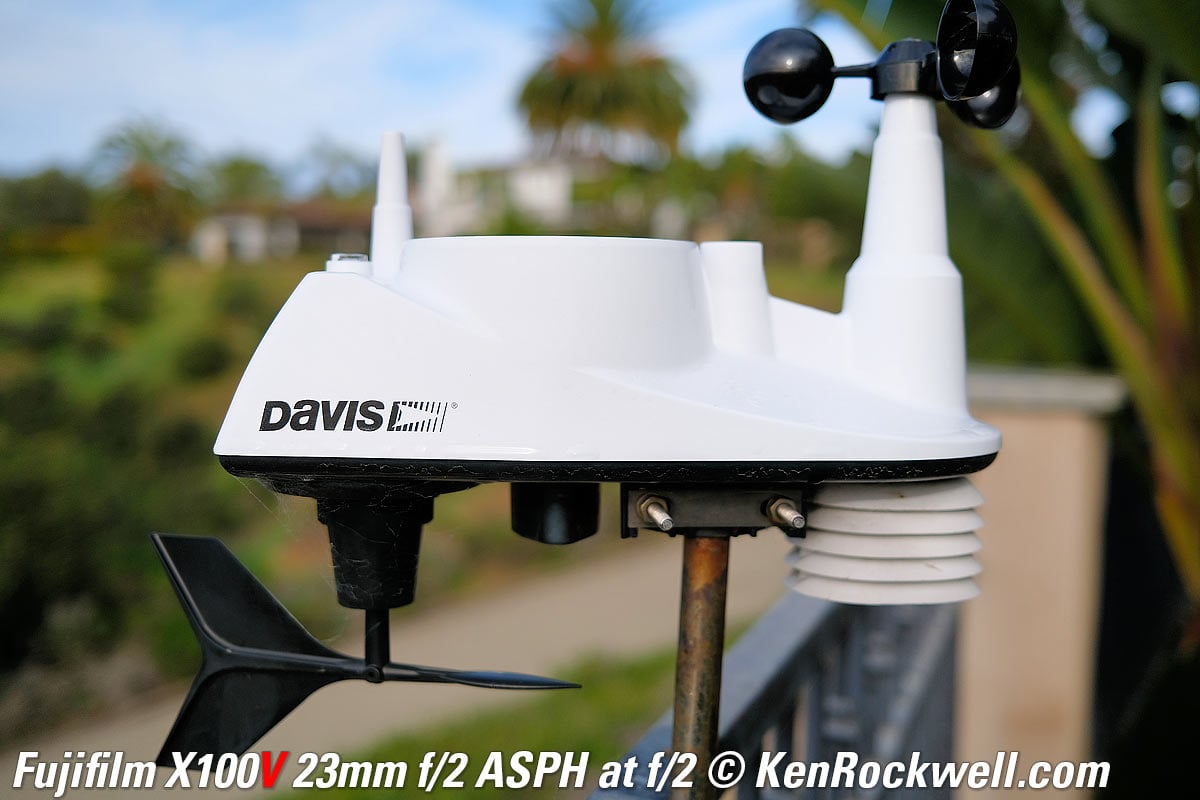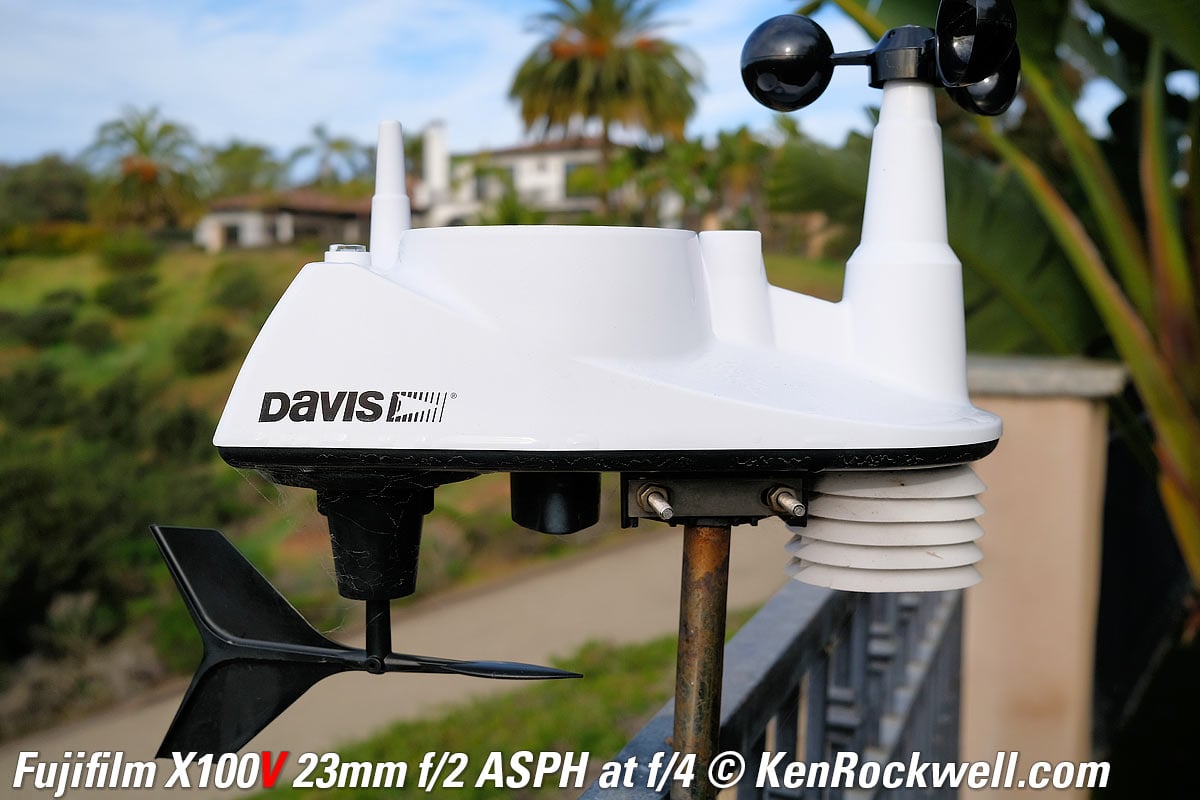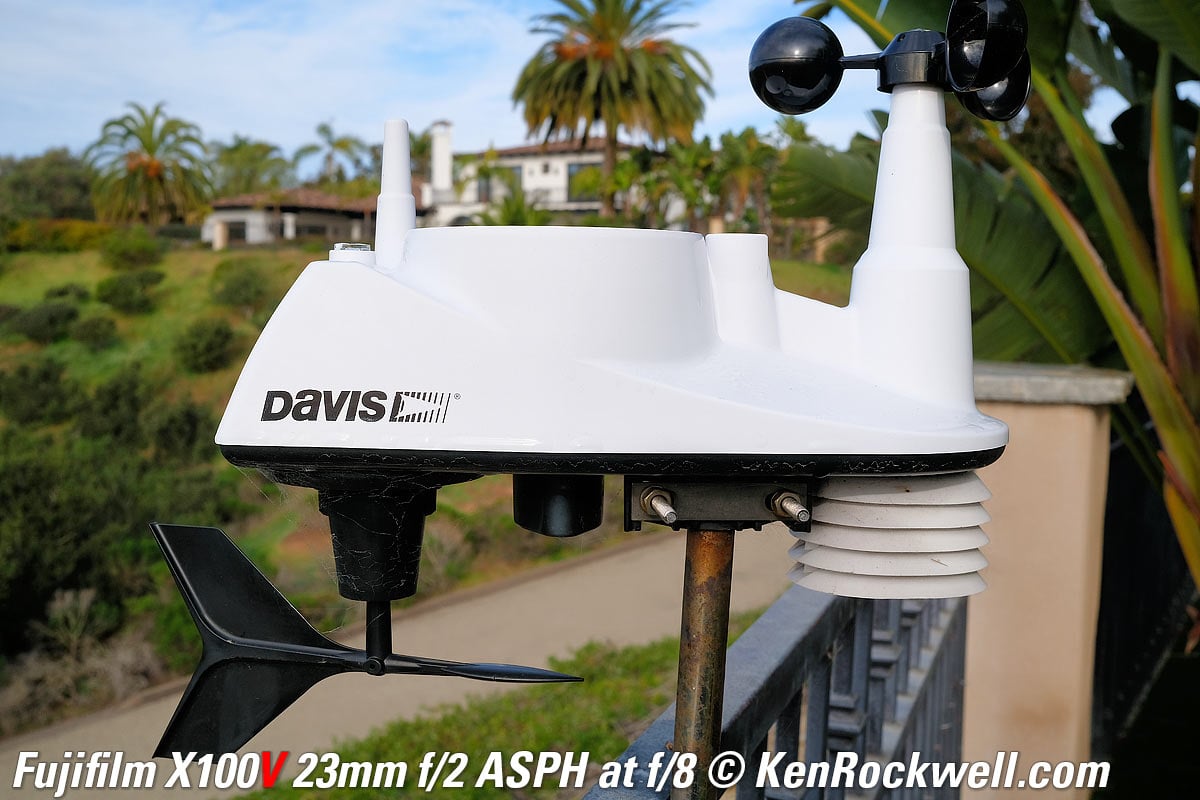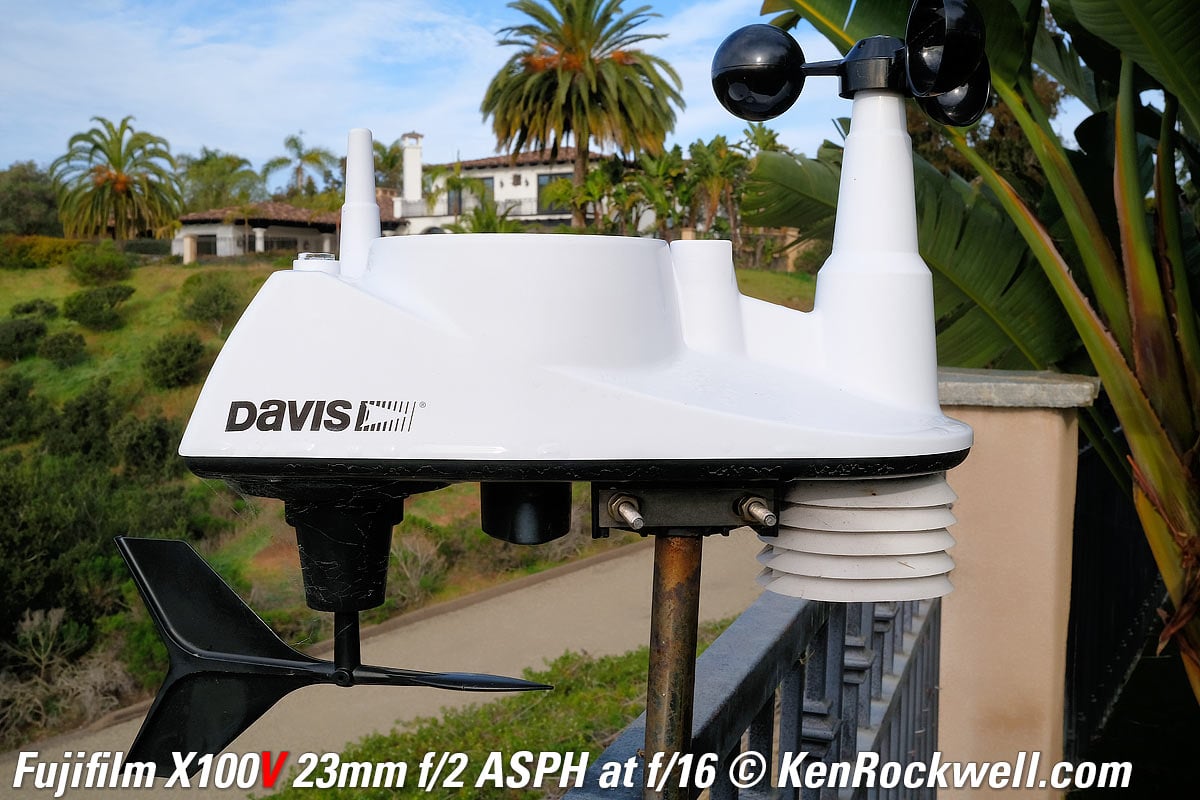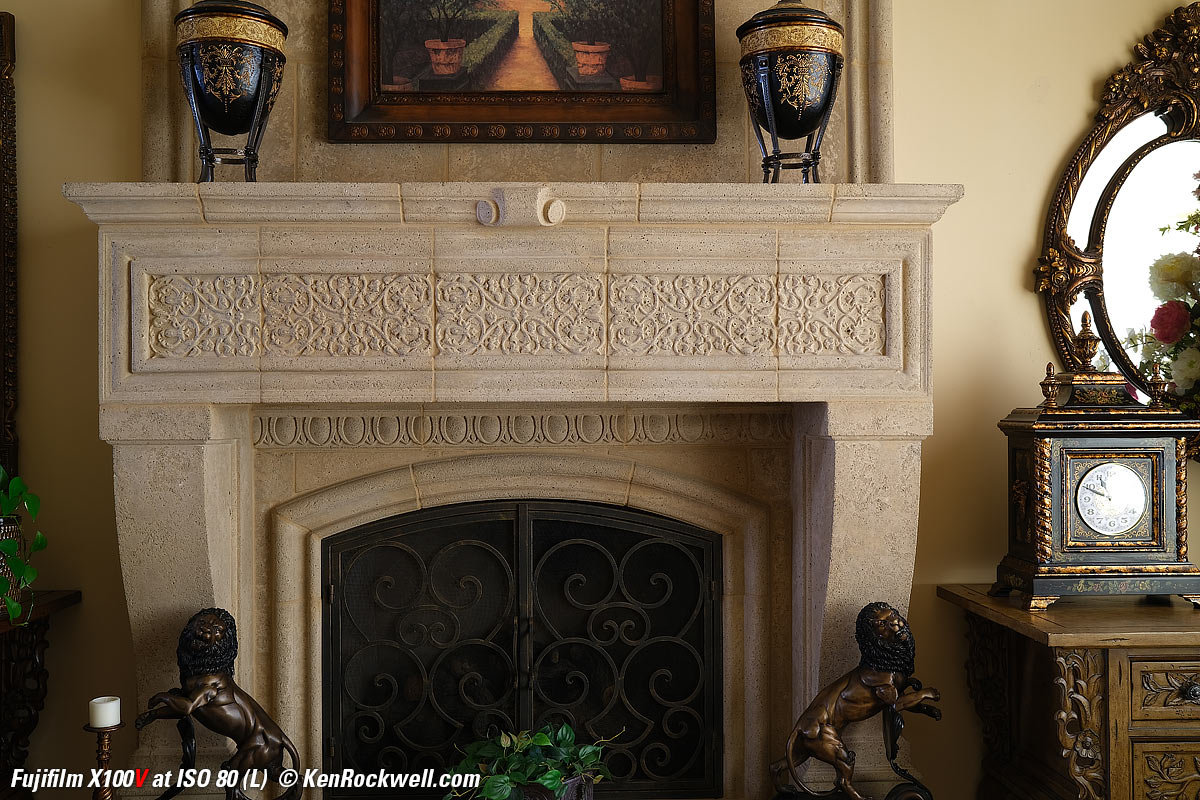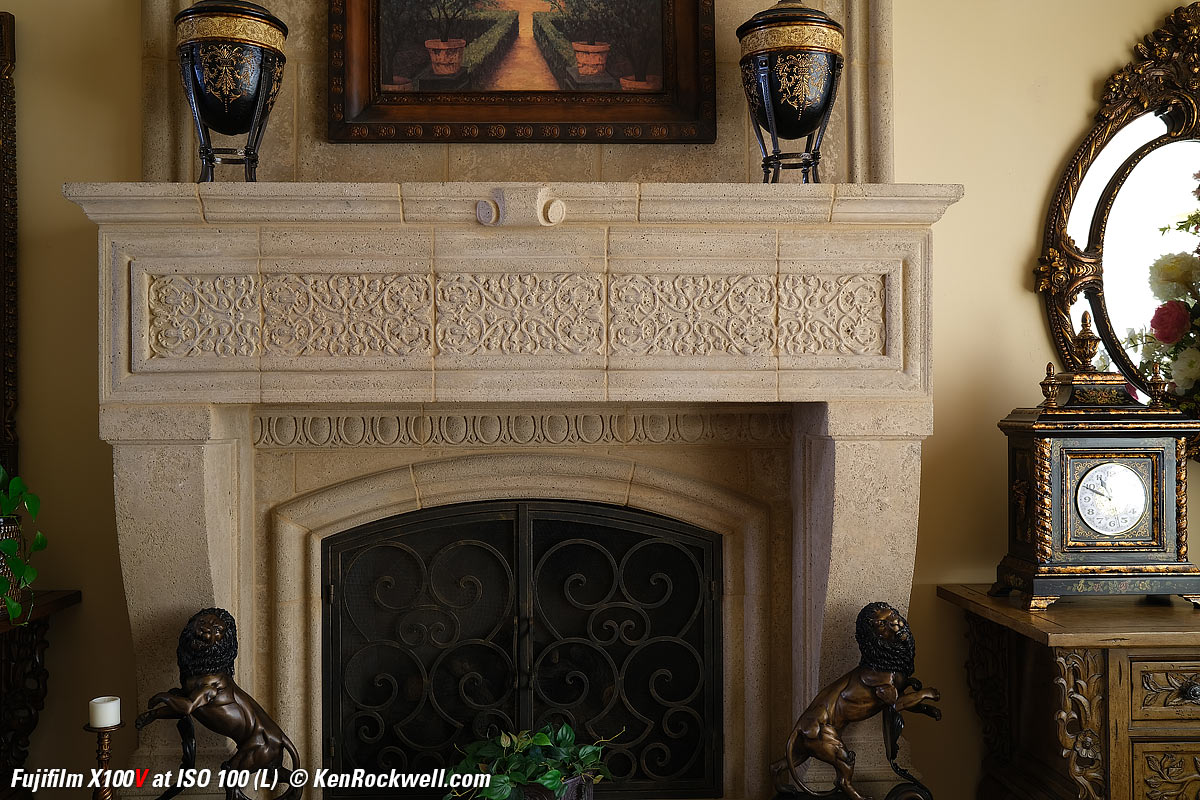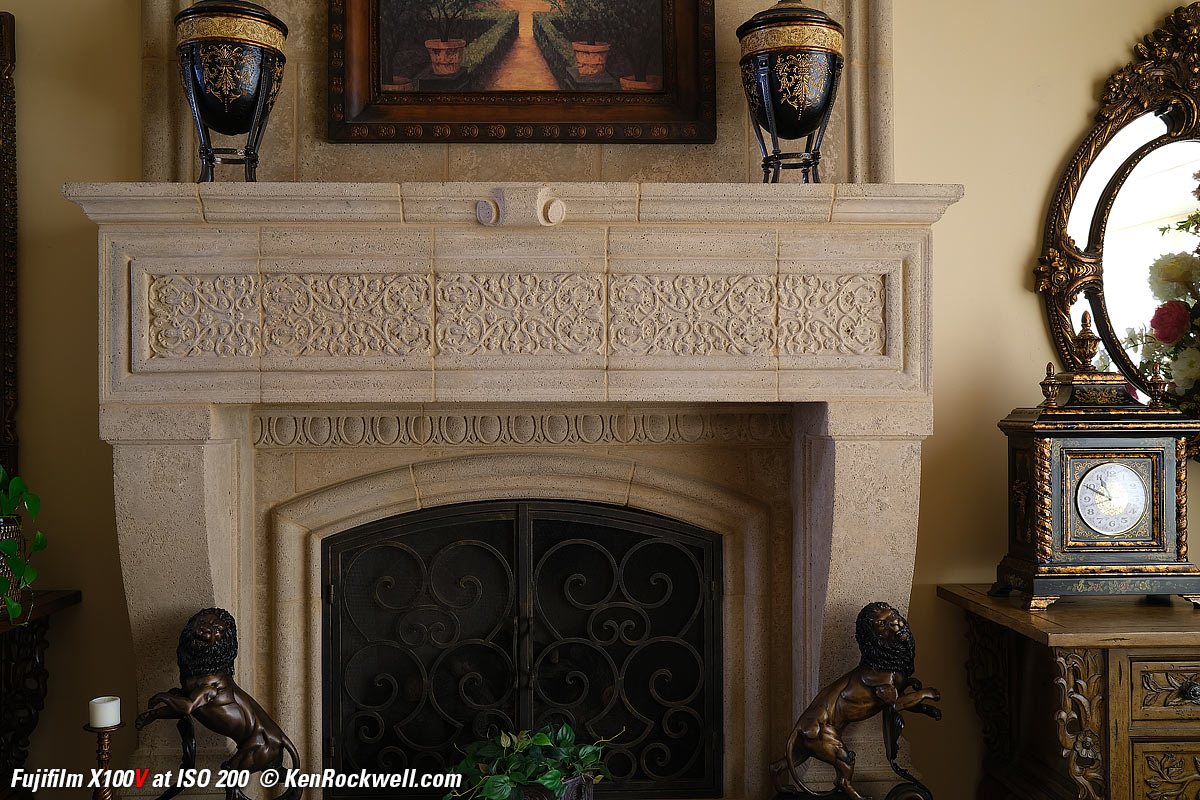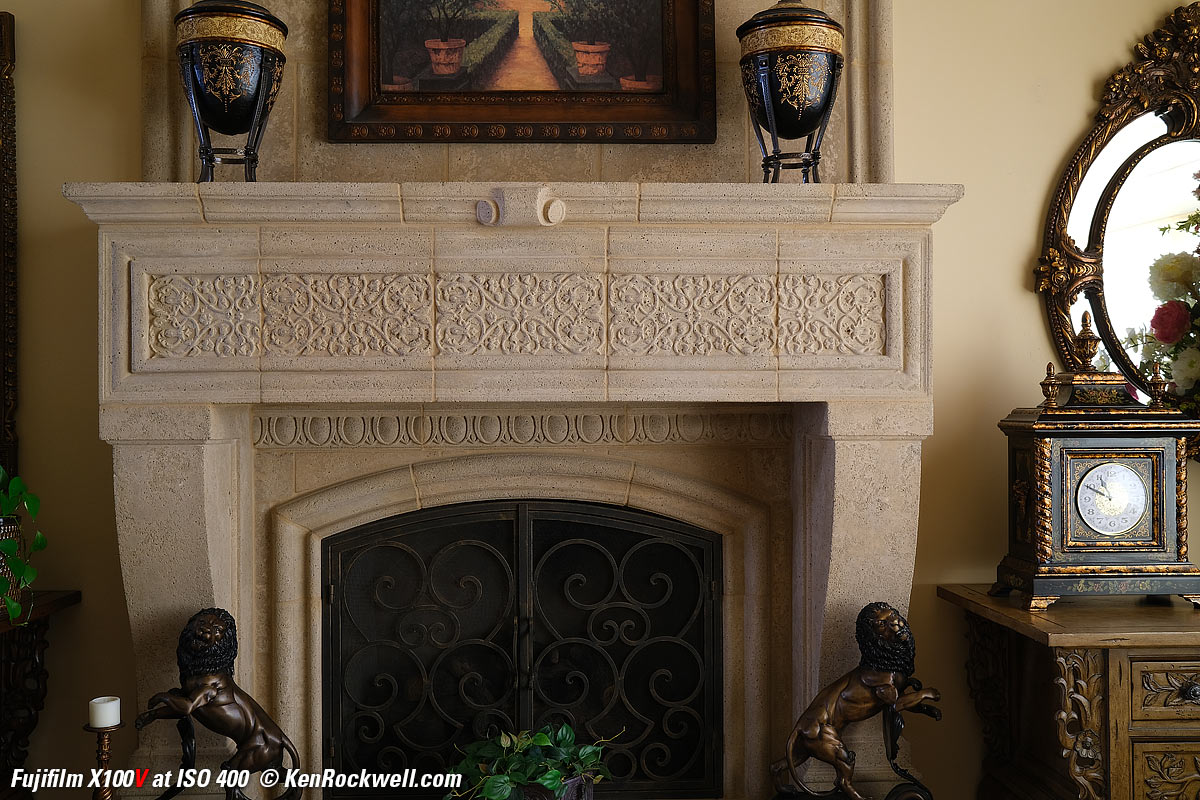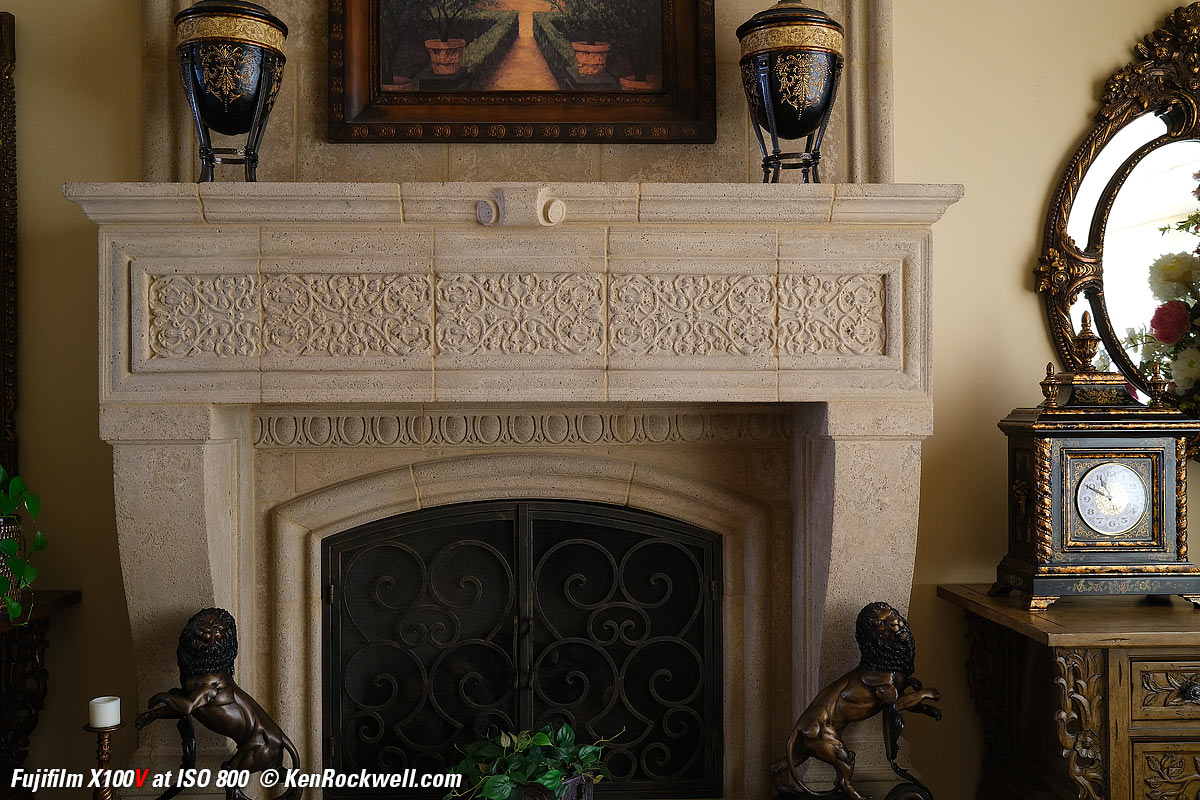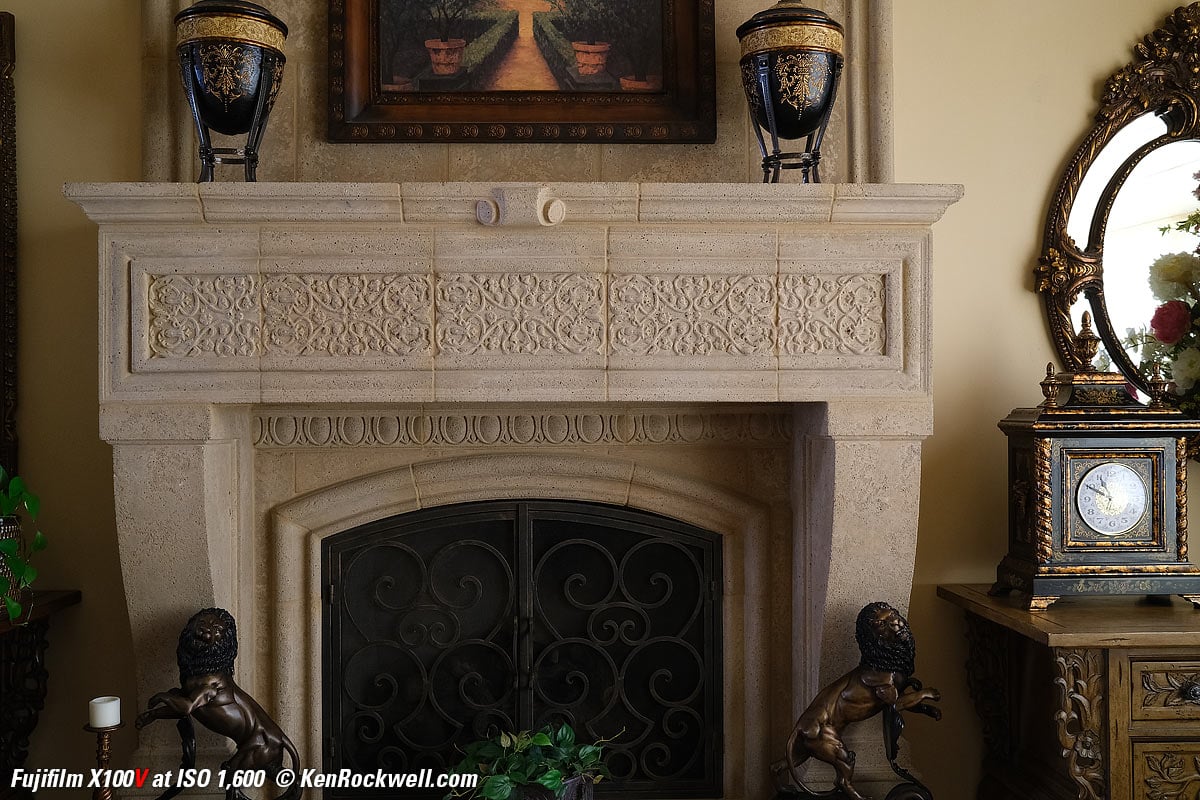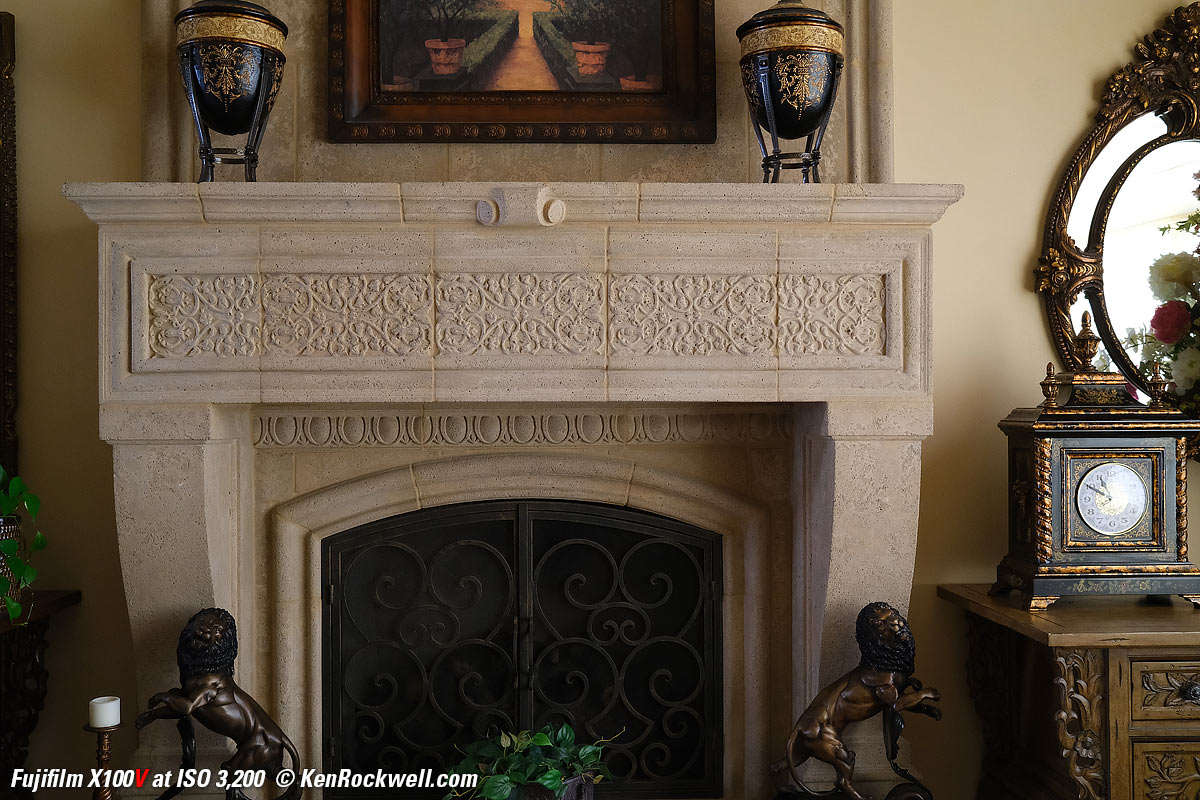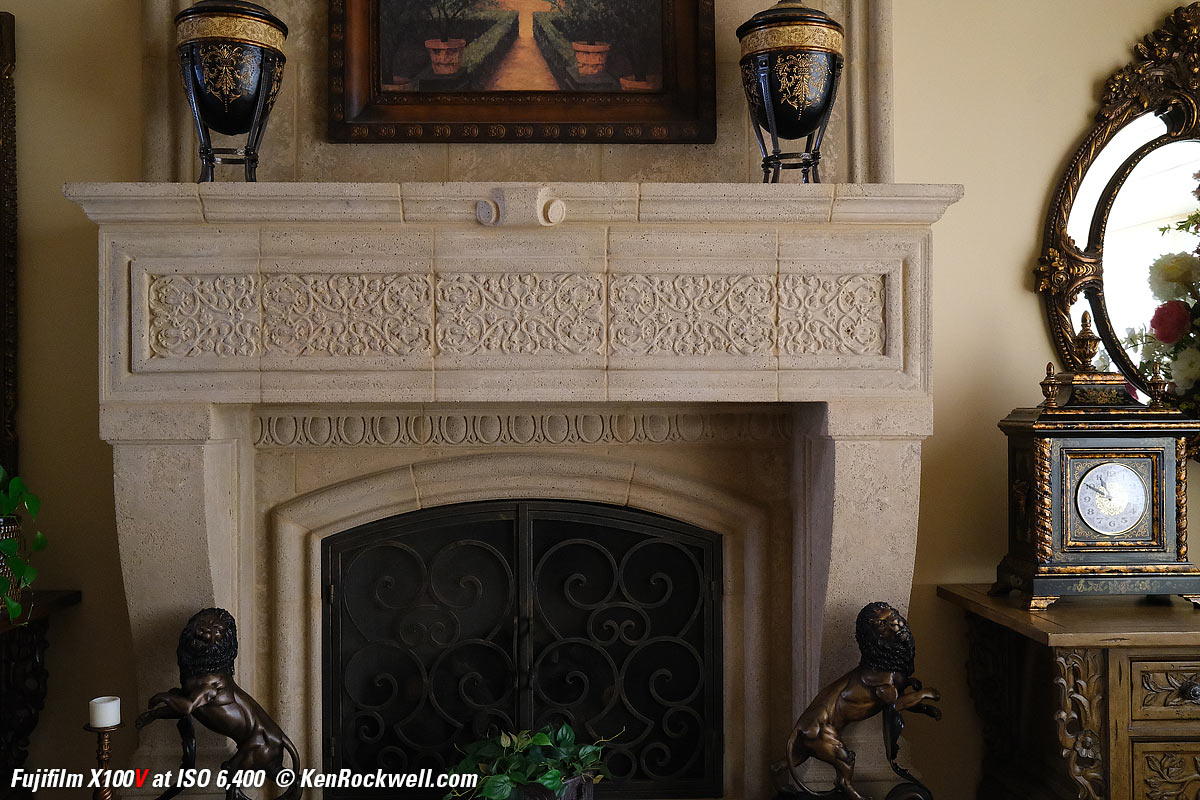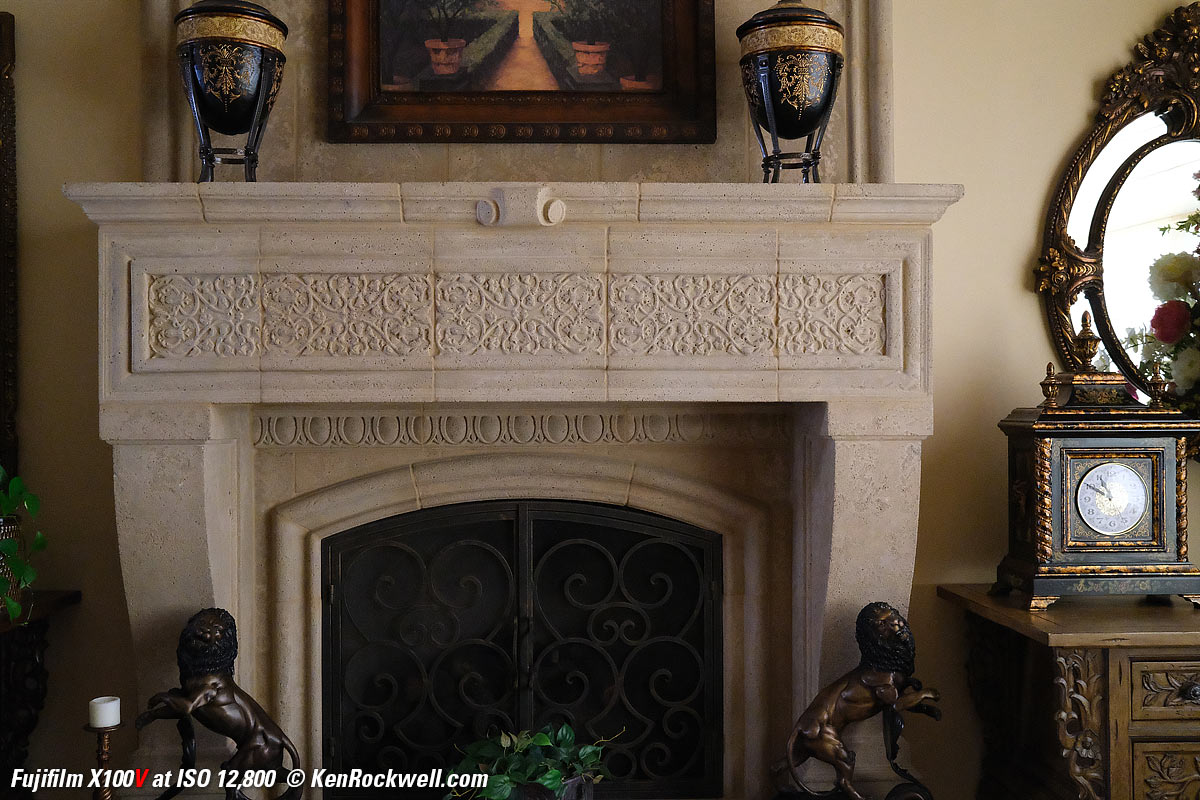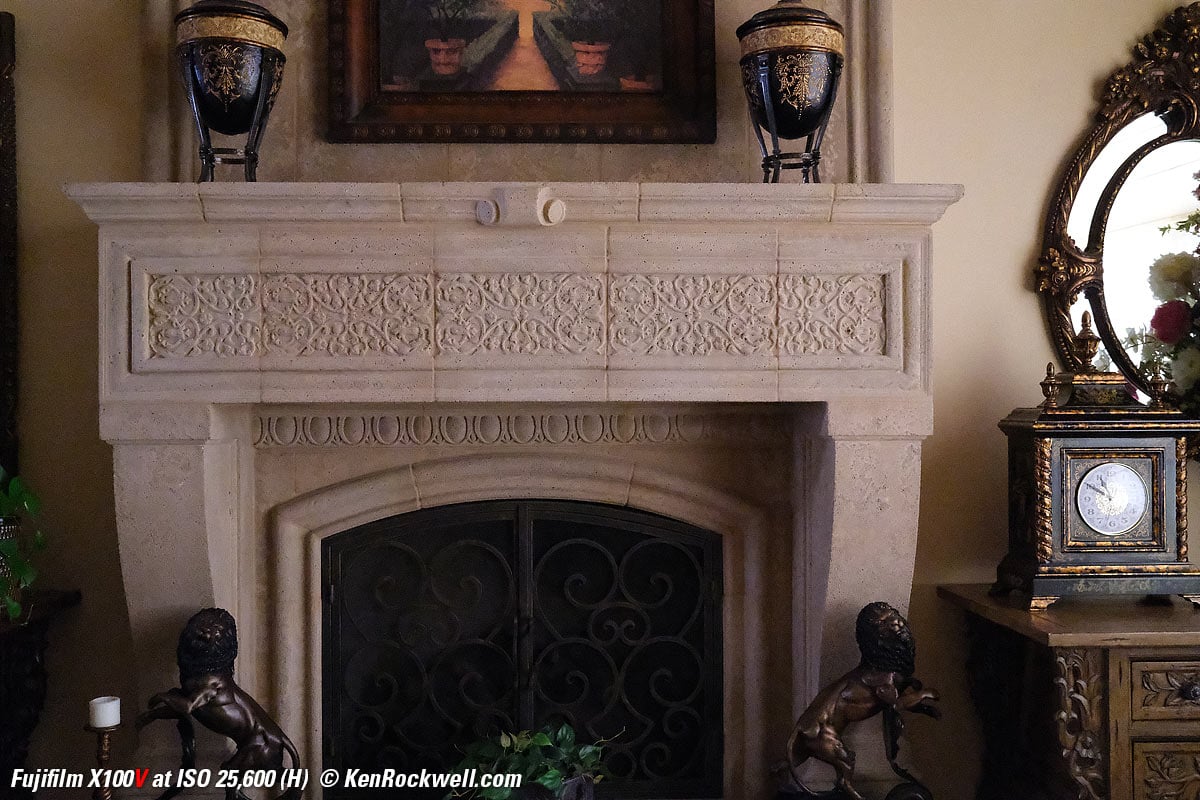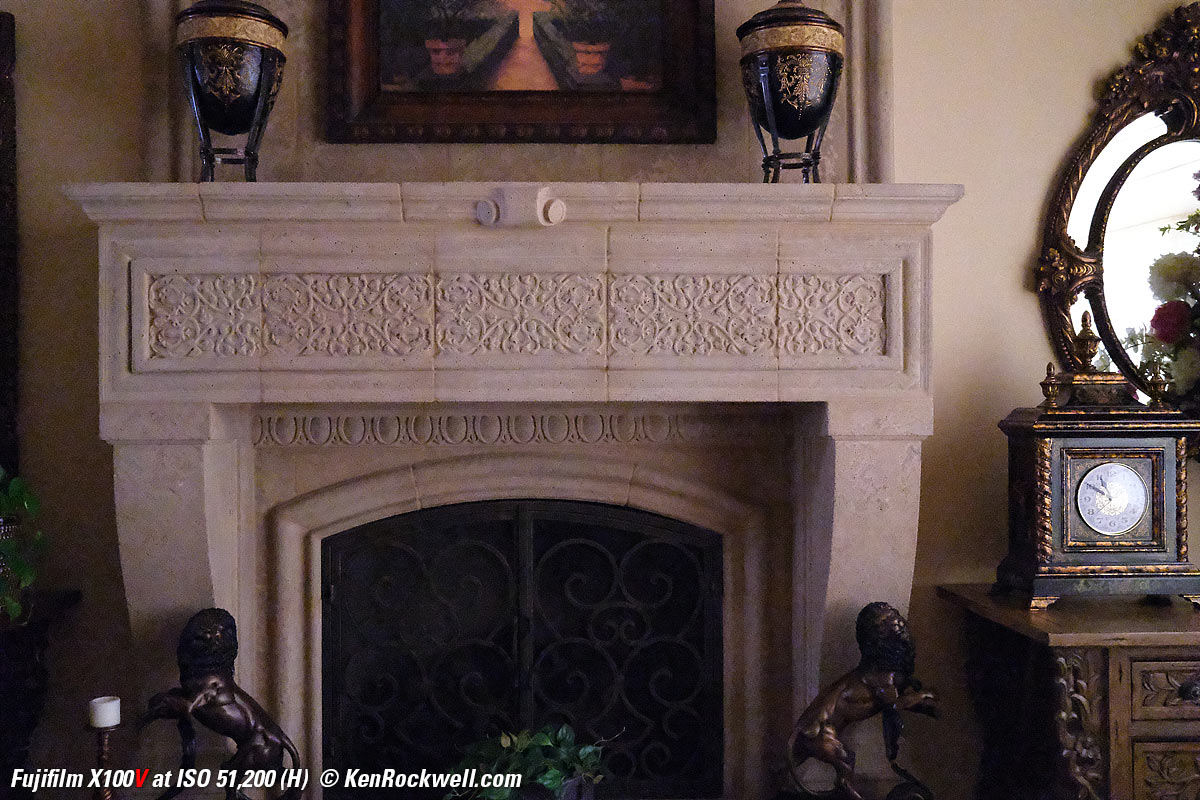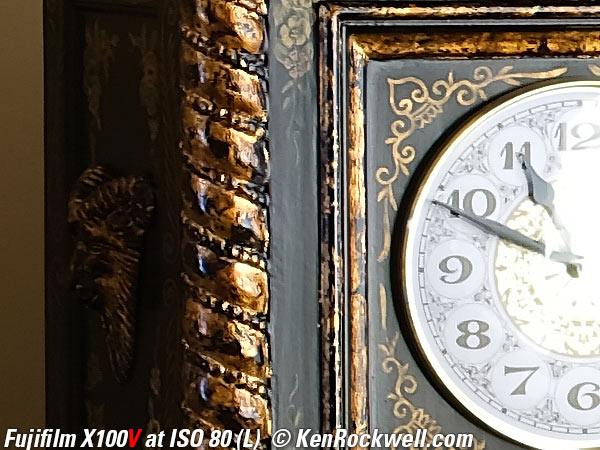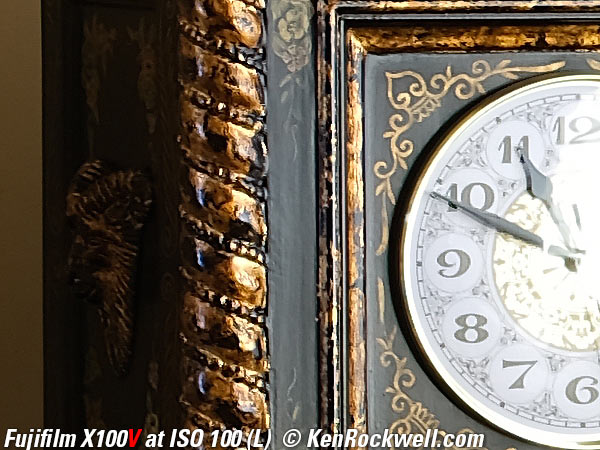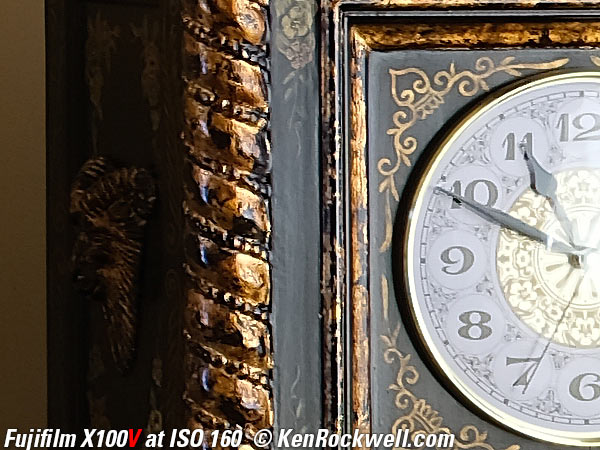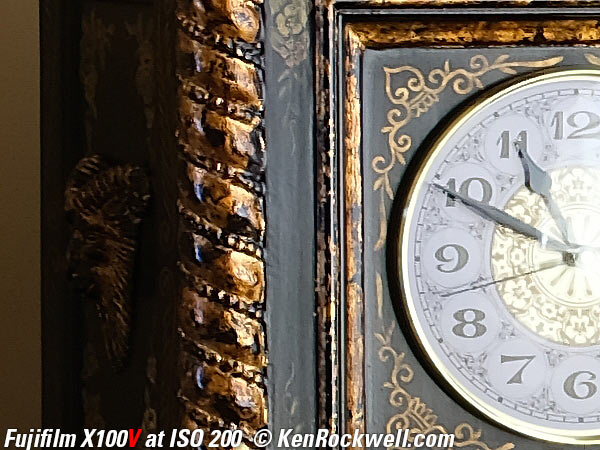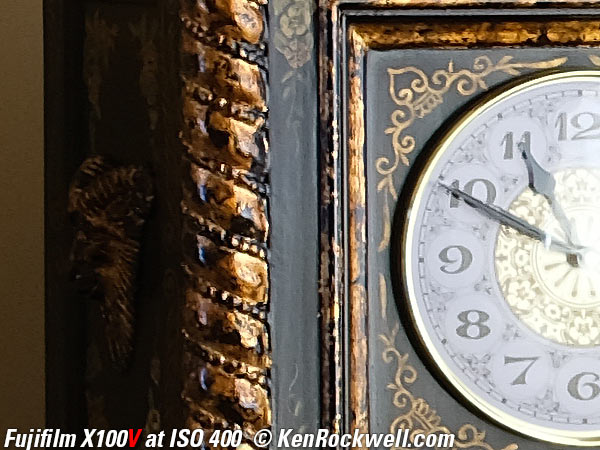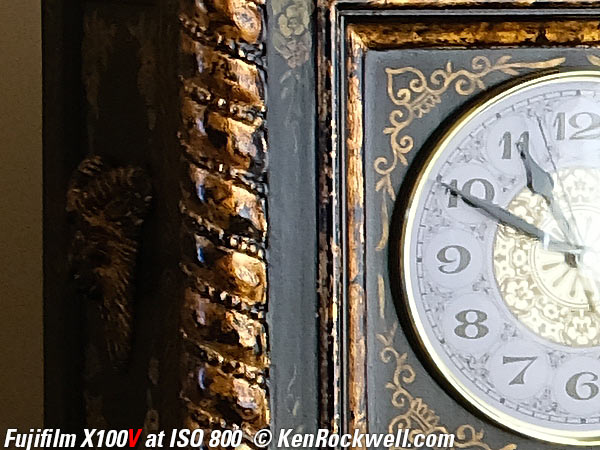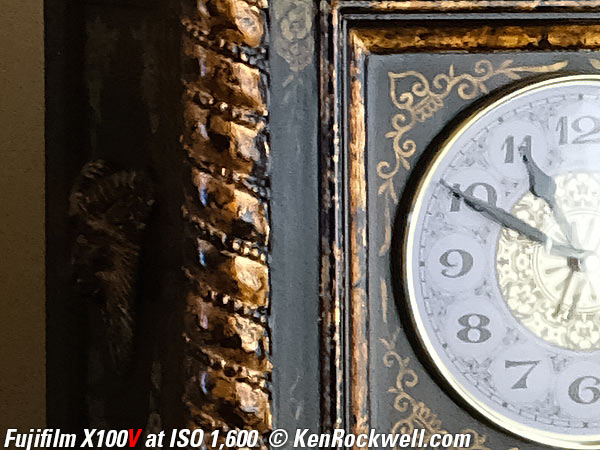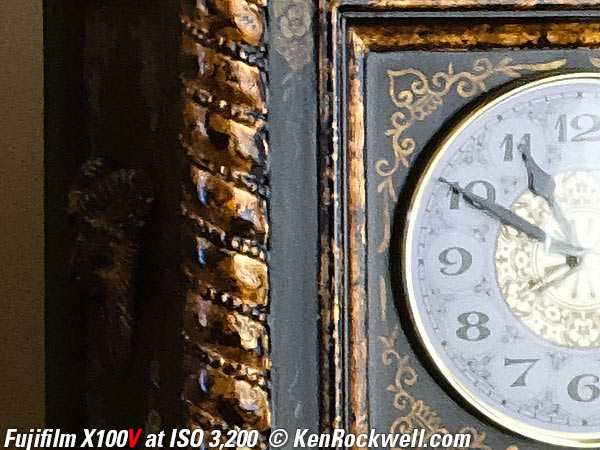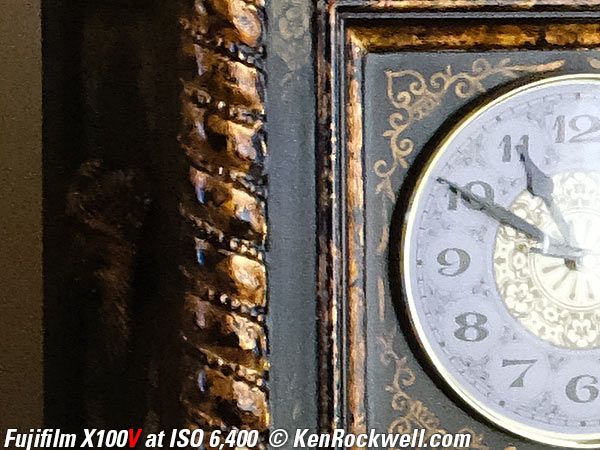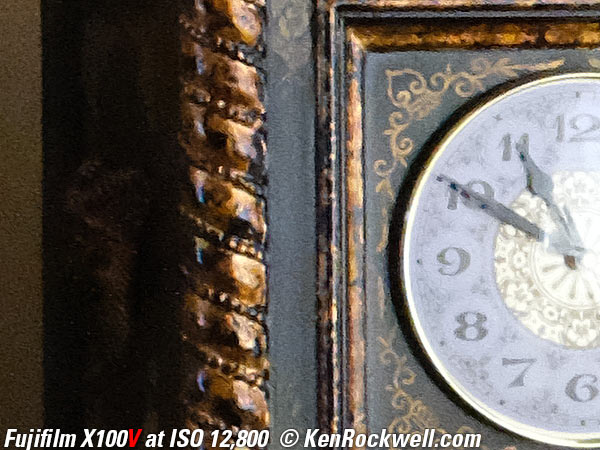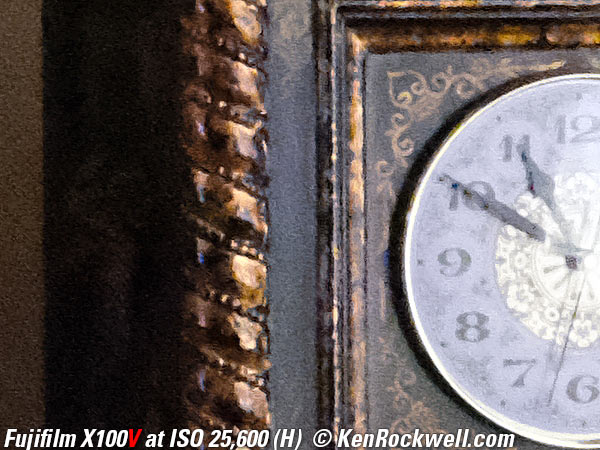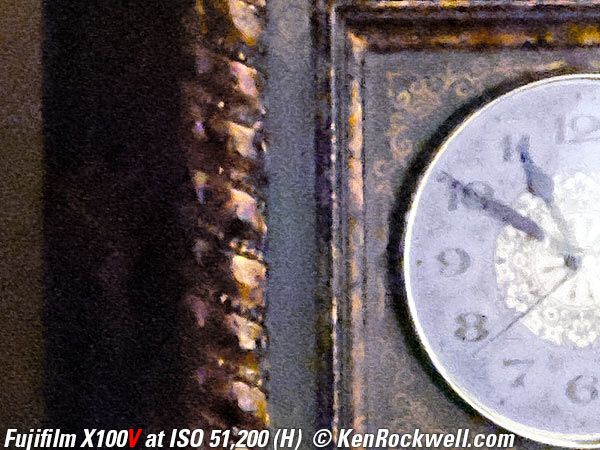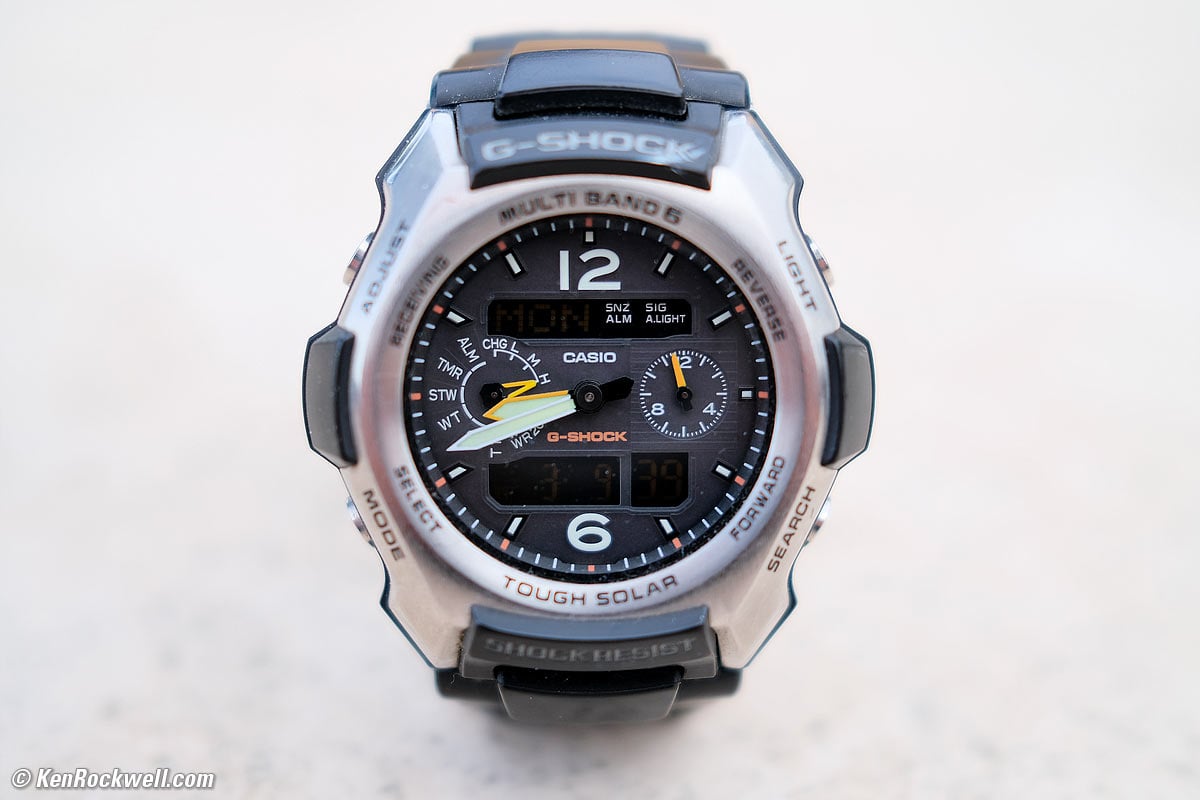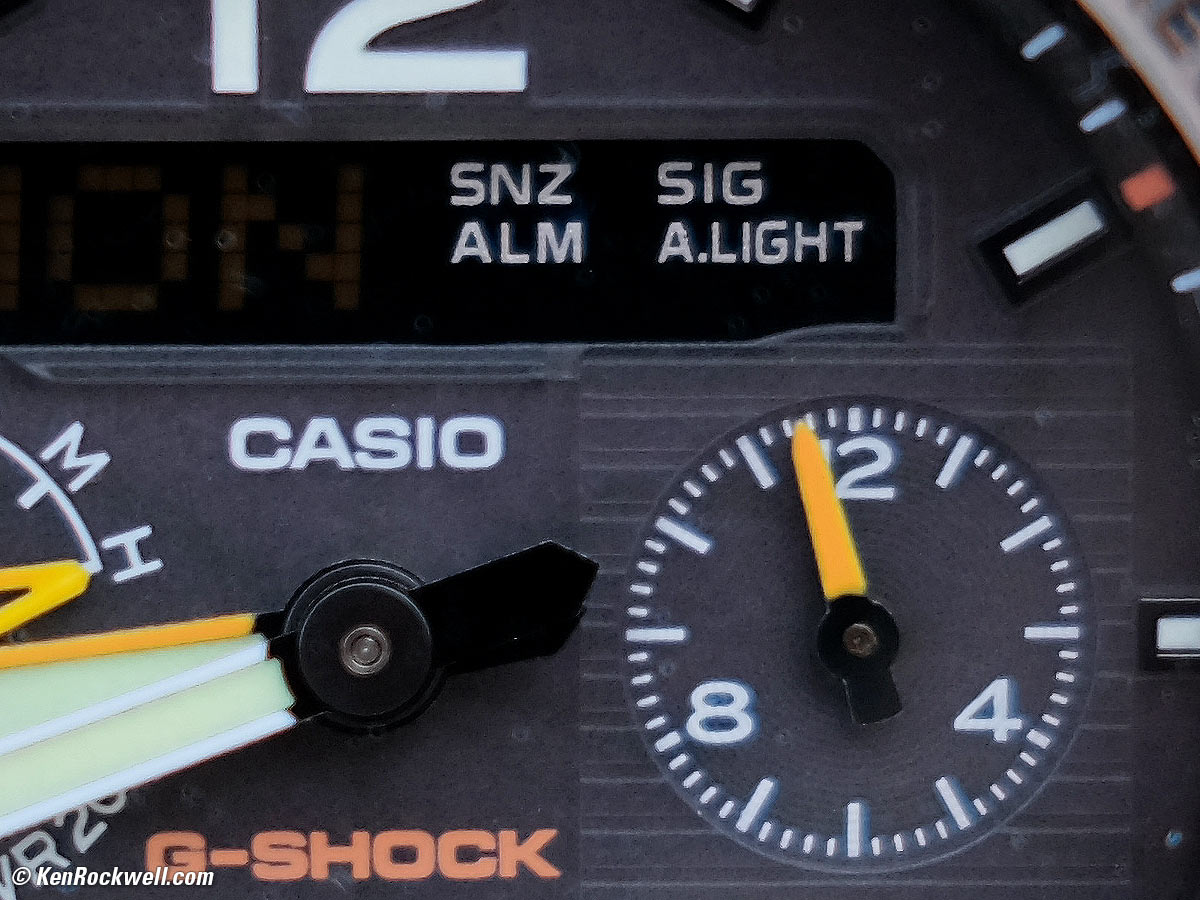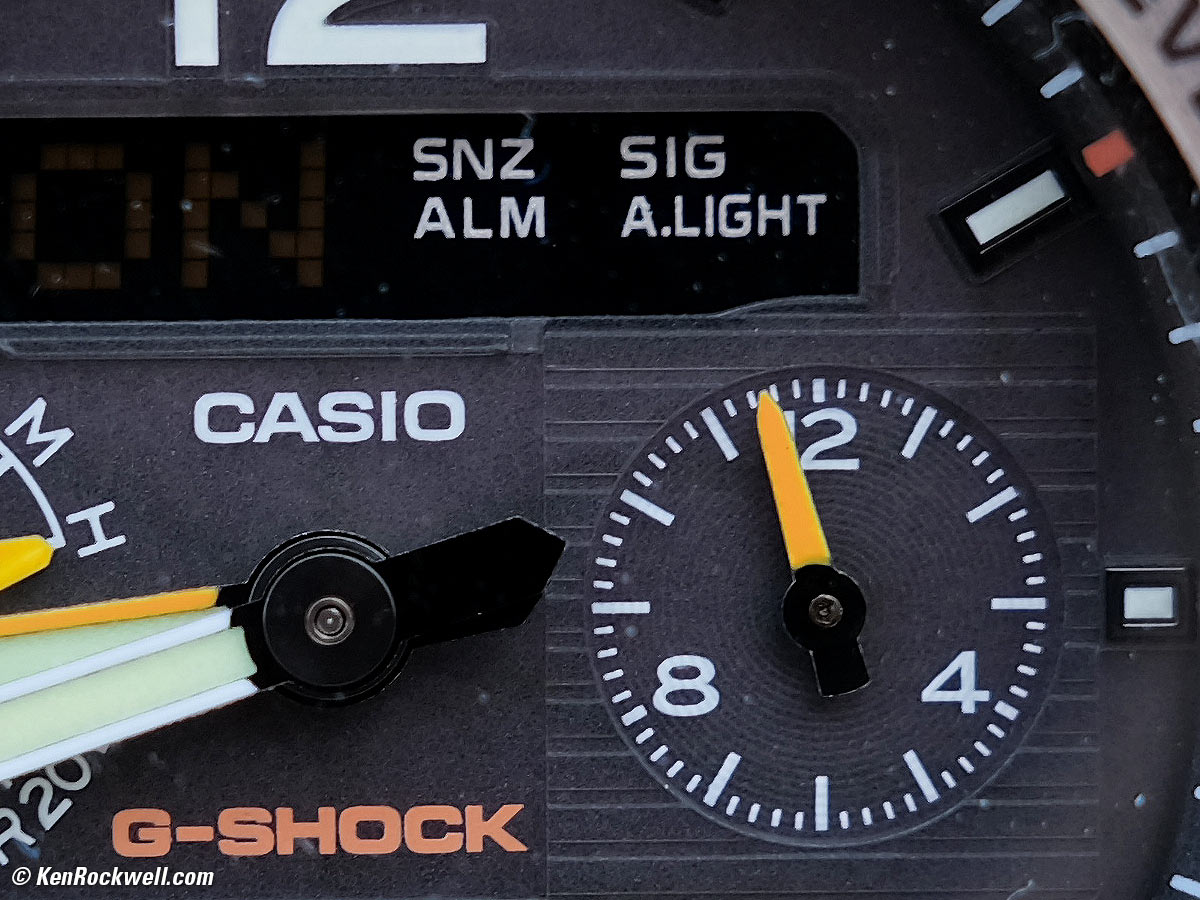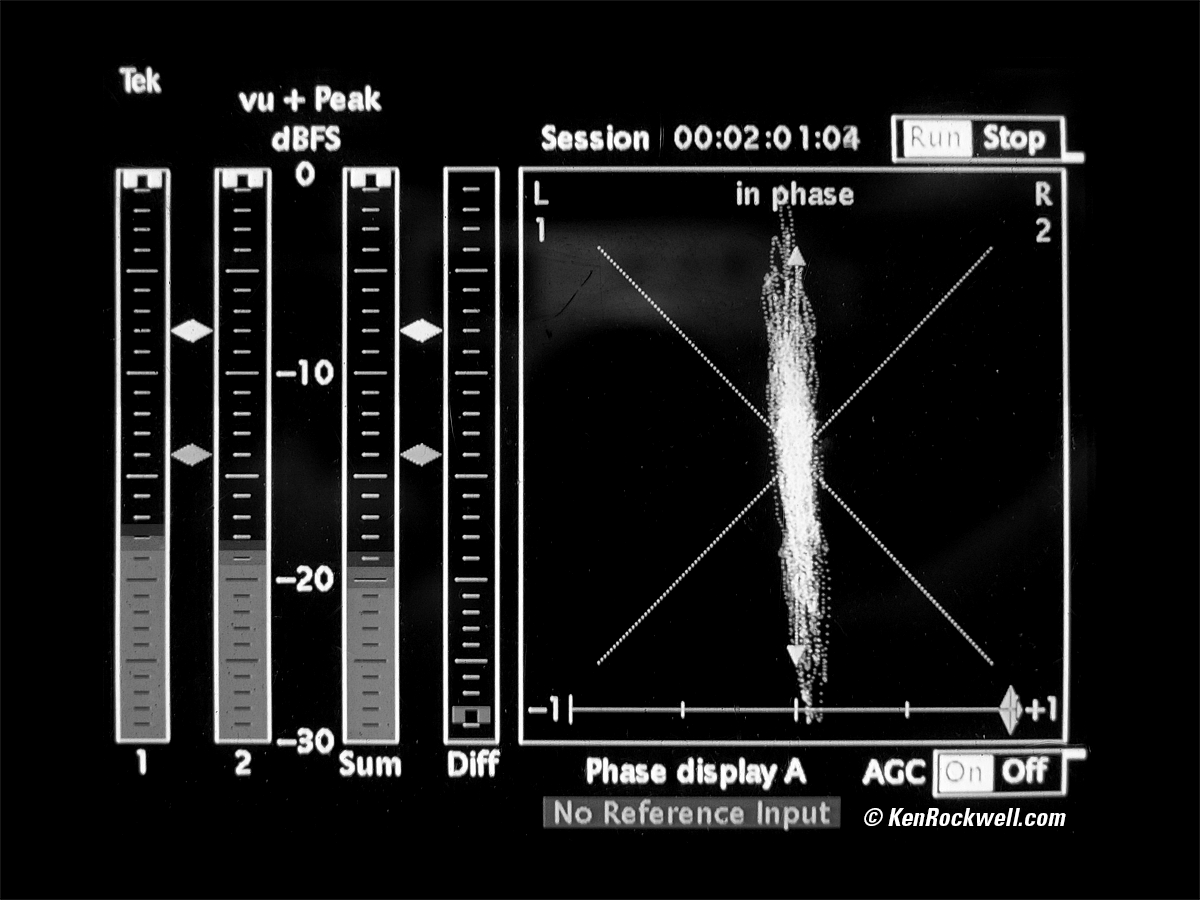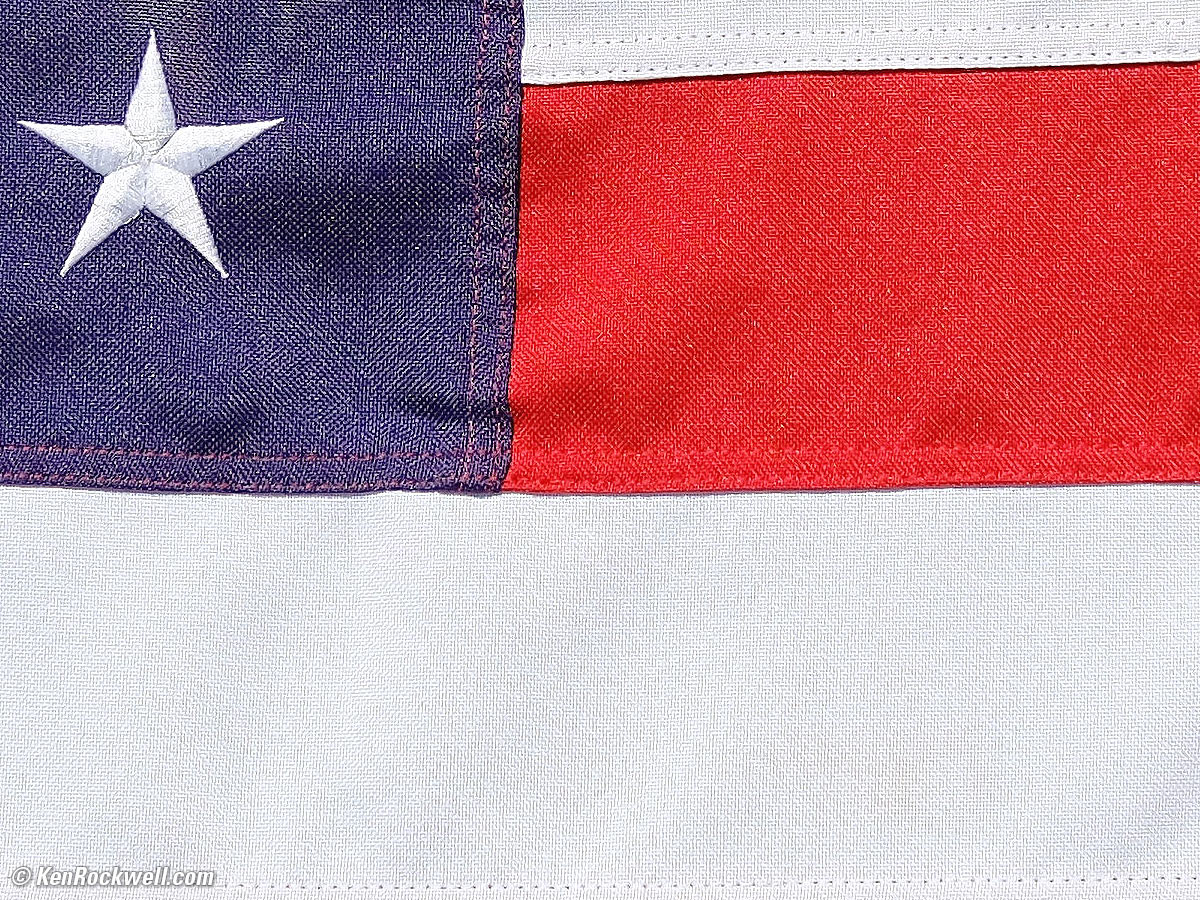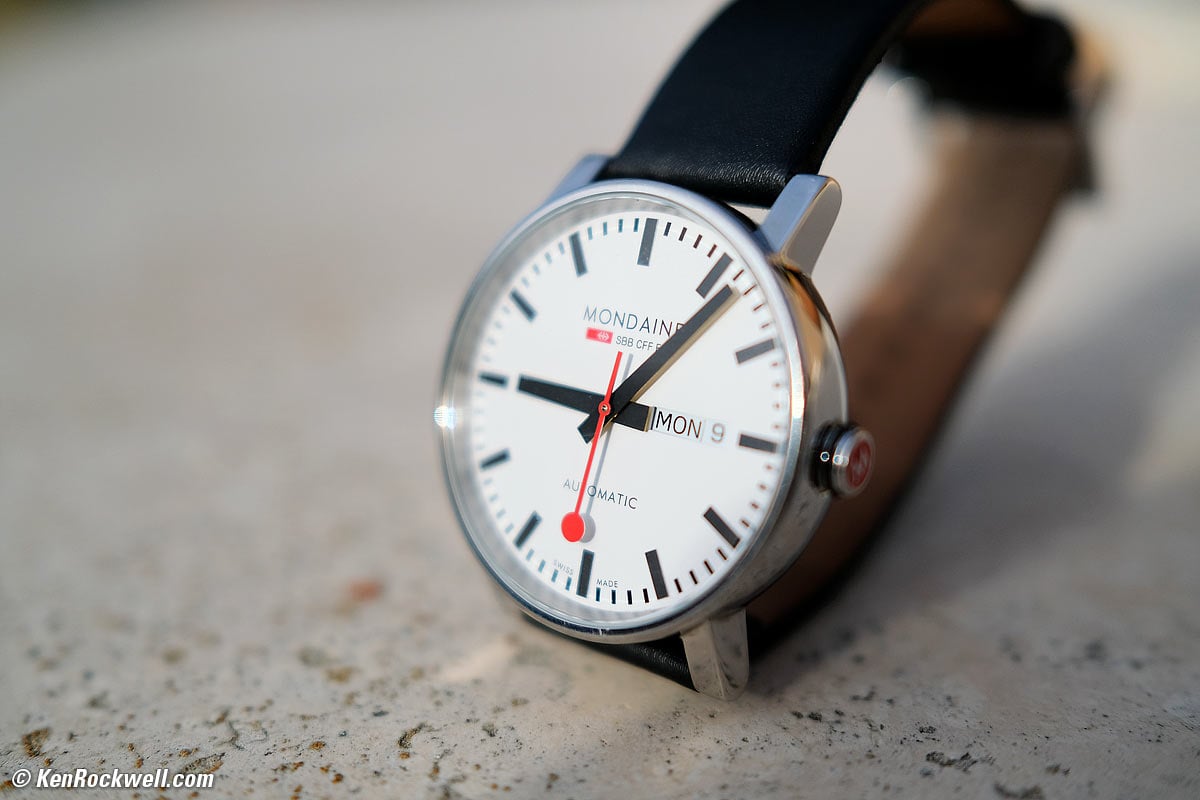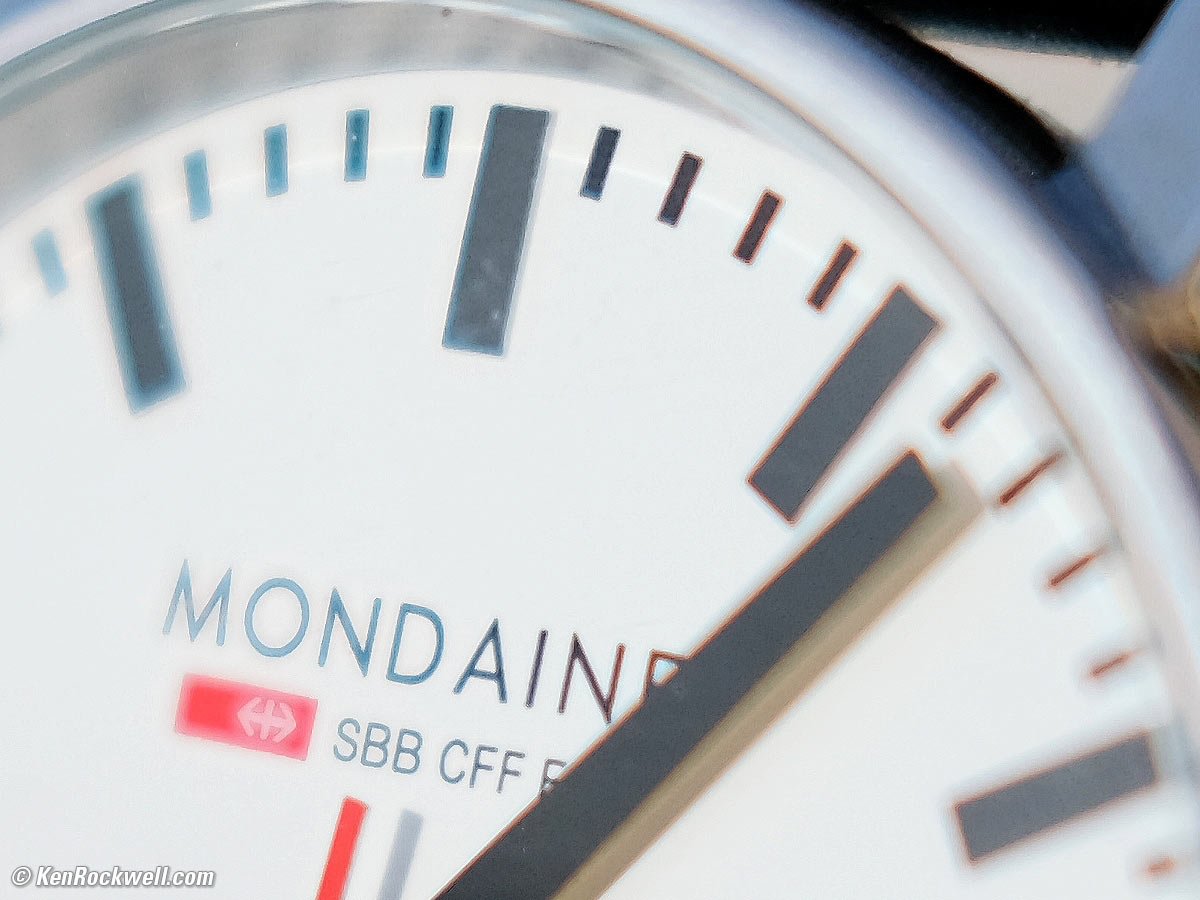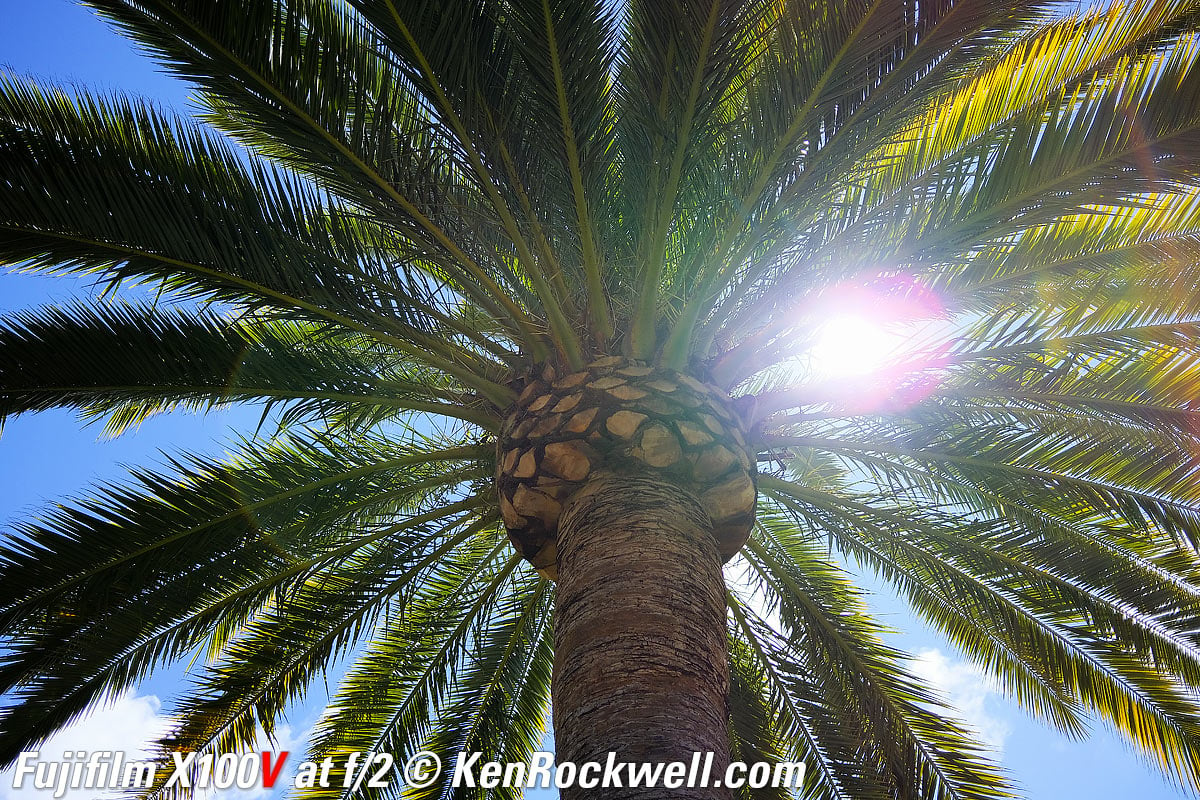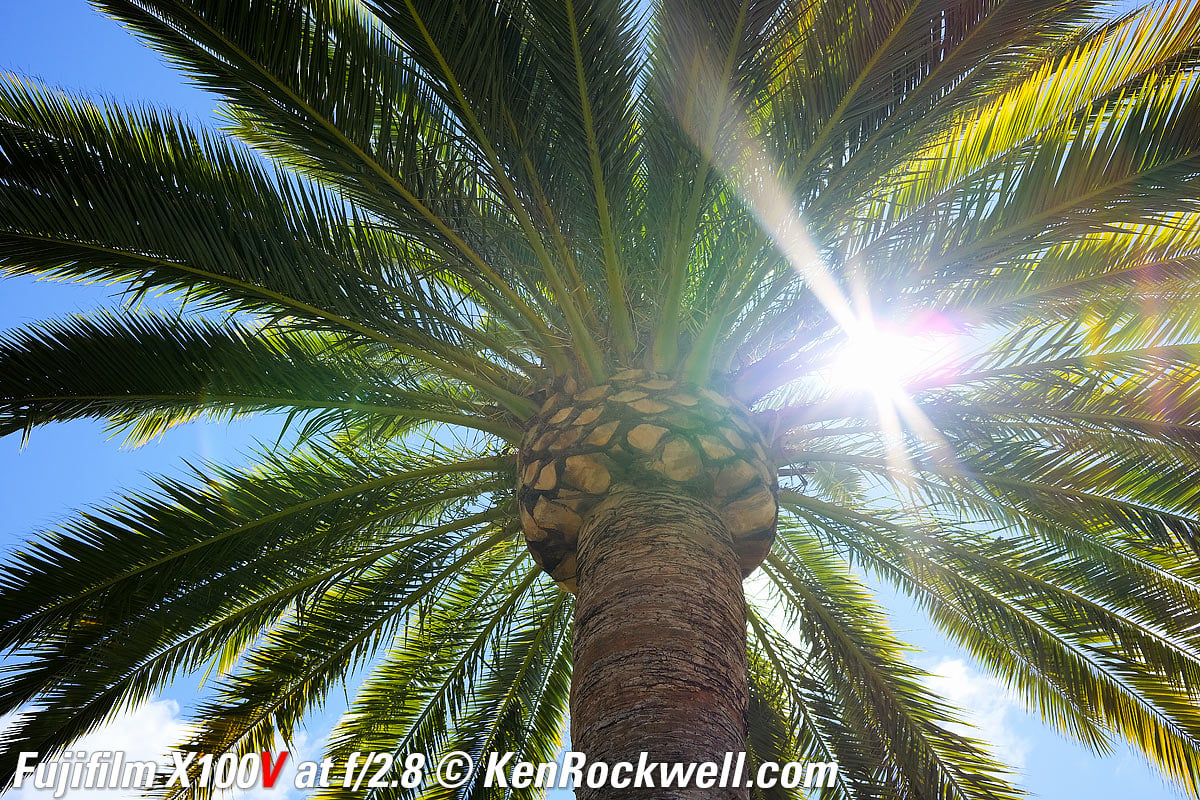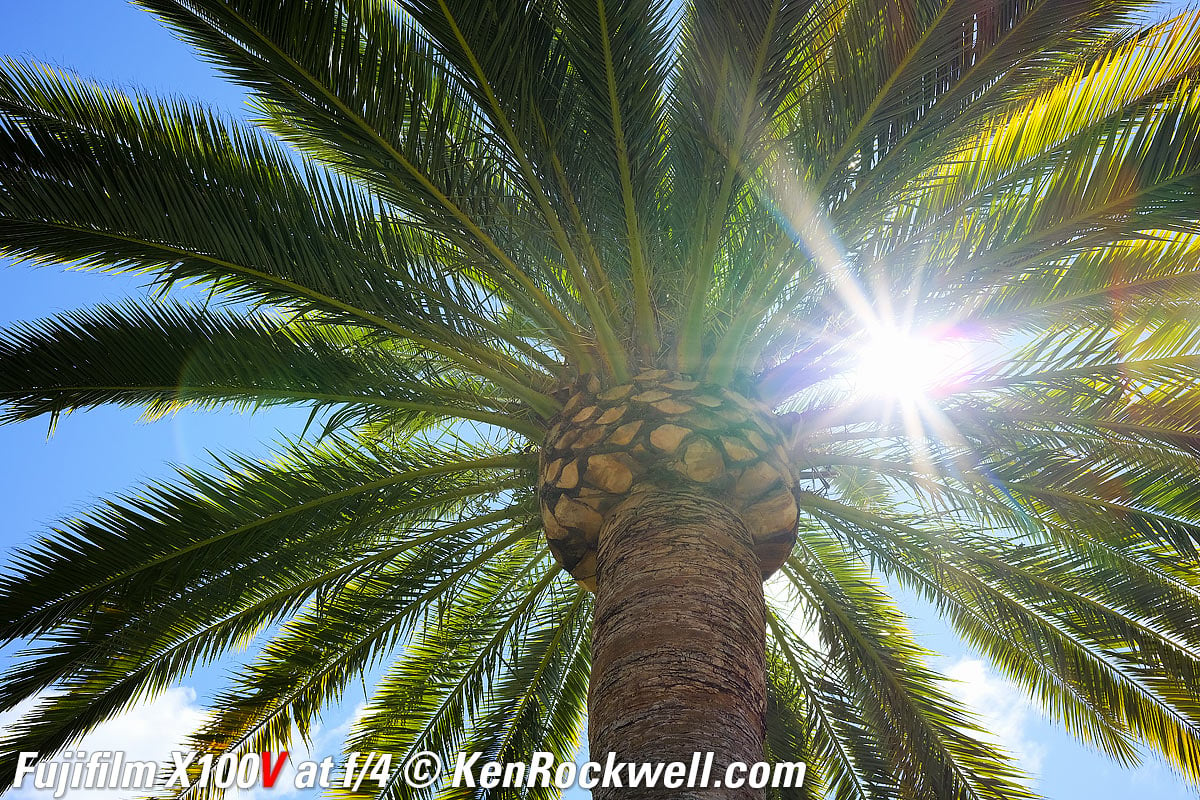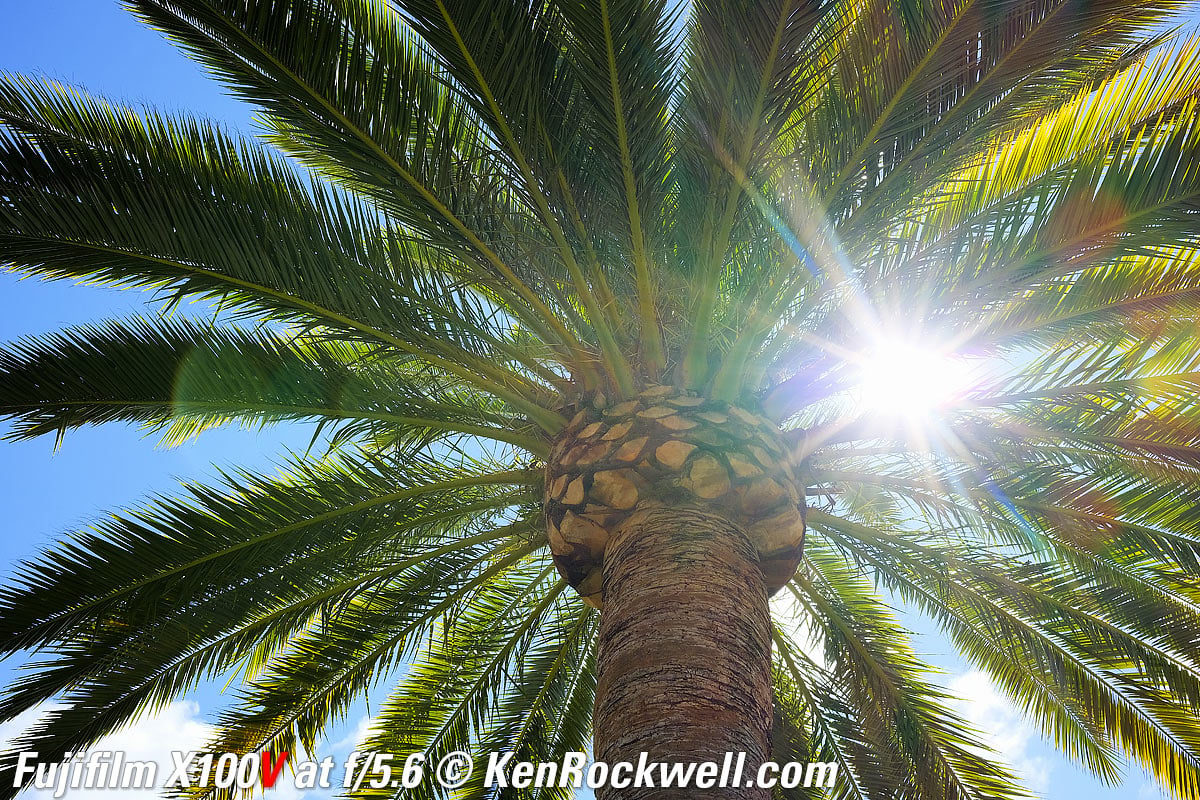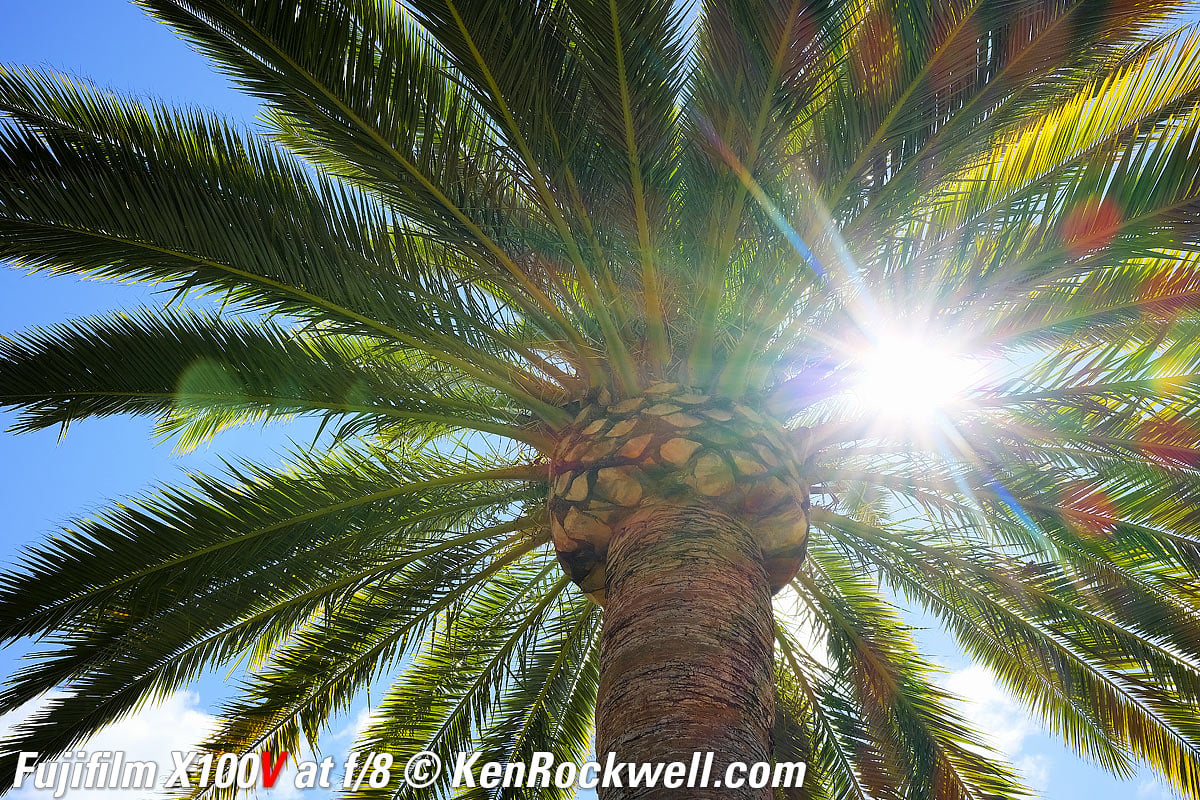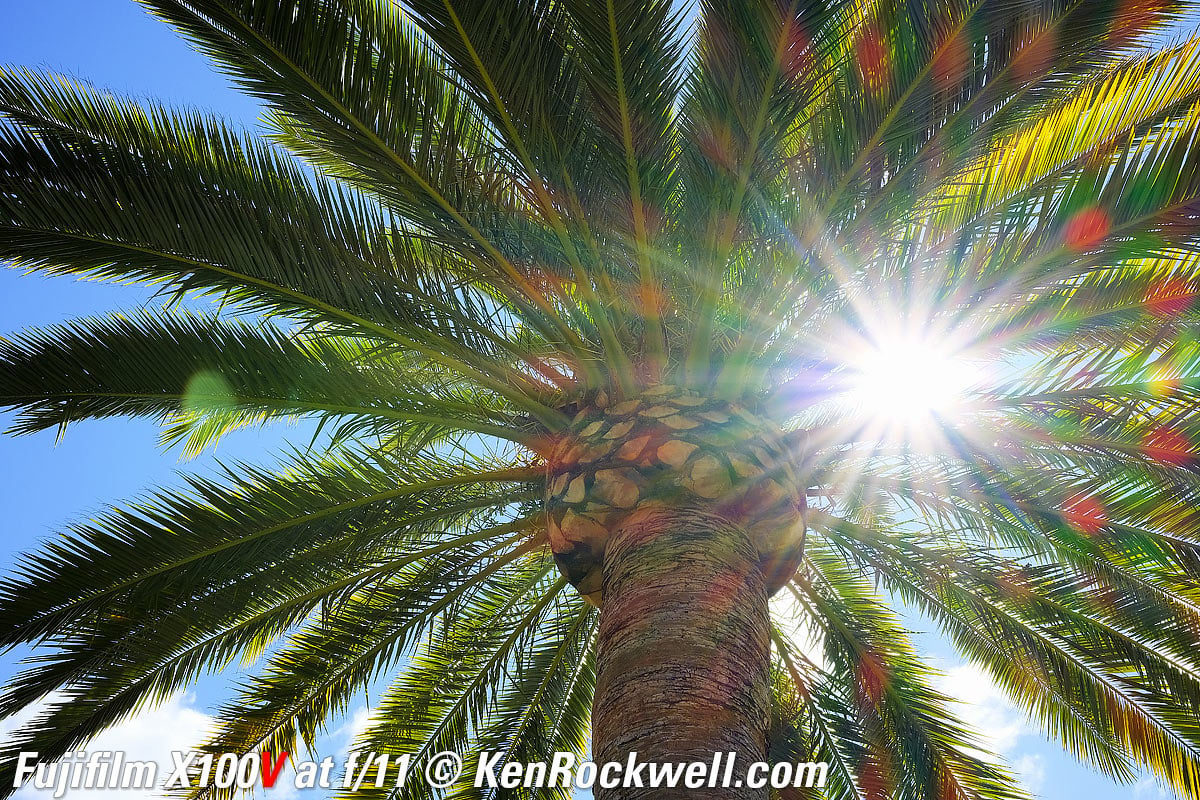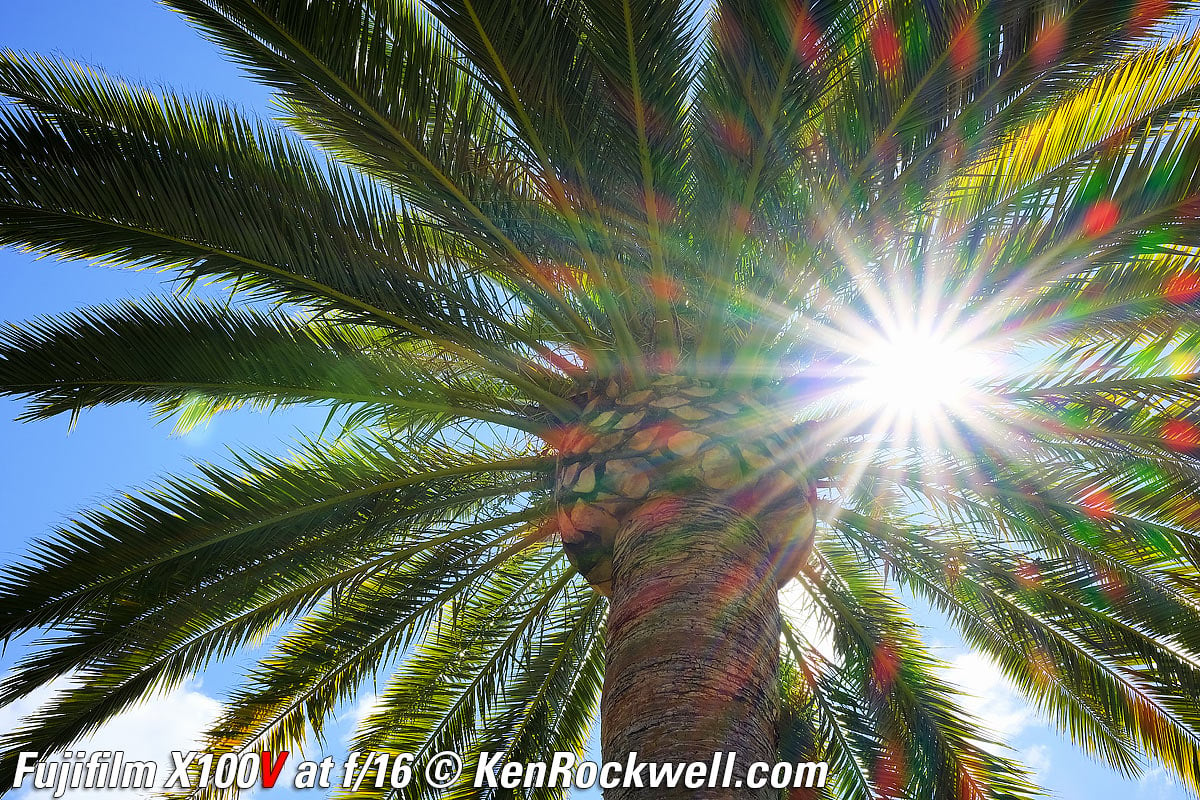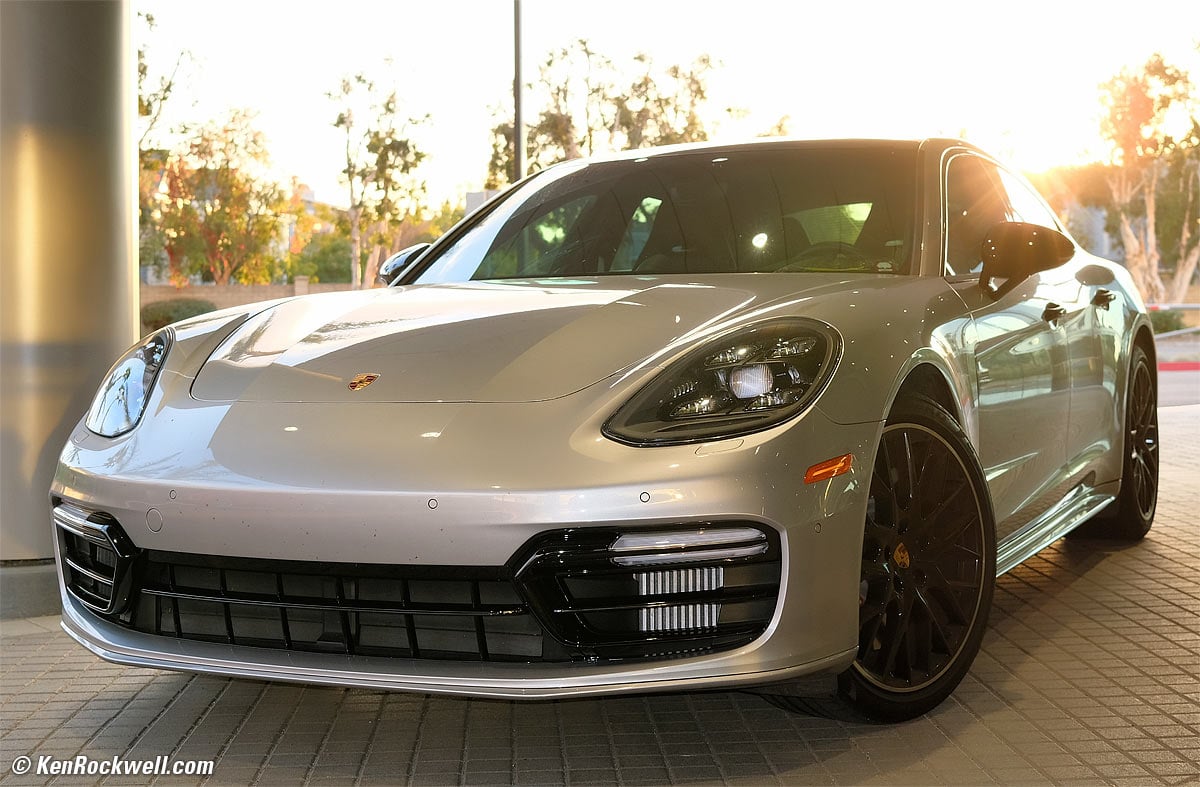Fujifilm X100V
Fixed 23mm f/2 ASPH (35mm eq.)
26MP APS-C, ISO 51,200, DCI 4K/30
The Pro's Fun Camera (2020-2024)
NEW: Fuji X100VI.
Sample Images Introduction Specifications
Accessories Performance Compared
User's Guide Recommendations More
Fujifilm X100V (reversed metal 49mm filter thread, 16.7 oz./474g with battery and card, 4 inch/10 cm close focus, $1,399.95 new or about $1,380 used). bigger.
I'd get mine at Adorama in silver, at Adorama in black, at Amazon in silver, at Amazon in black, at B&H in silver or at B&H in black, or get it used at eBay if you know How to Win at eBay.
The X100V is so wildly popular that you won't find it "in stock," but it's easy to get your X100V. Order it at Adorama in silver, at Adorama in black, at B&H in silver or at B&H in black and be patient for it to arrive. Most people don't realize that these come in and go out the same day to people like me who have them on order all the time, without ever showing as "in stock" because they never make it to "stock" before they get shipped to us. Order yours and be patient, or be prepared to pay about $2,000 for a used one. The X100V is this good! How to get yours.
If you lack patience, they're $2,200 used at Amazon in silver and $1,800 used at Amazon in black, or about $2,000 used if you know How to Win at eBay.
Here's a better idea: I prefer my older X100F because it has a rear 4-way controller rather than the foolish "touch functions" of the X100V, and today the X100F sells for much less than the X100V and is easy to get used if you know How to Win at eBay.
This all-content, junk-free website's biggest source of support is when you use those or any of these links to approved sources when you get anything, regardless of the country in which you live. Thanks for helping me help you! Ken.
March 2024 Fuji Sony LEICA Zeiss Nikon Canon All Reviews
New: SmallRig Grips for X100V & X100VI.
Ken Rockwell's Fuji X100V User's Guide
Why Fixed Lenses Take Better Pictures
NEW: Fuji X100VI (2024-)
Fuji X100F (2017-2020)
Fuji X100T (2014-2017)
Fuji X100S (2013-2014)
Fuji X100 (2011-2013)
Fuji X100V. bigger.
Fuji X100V (note lack of rear four-way controller). bigger.
Also comes in black. blacker.
Sample Images top
Sample Images Introduction Specifications
Accessories Performance Compared
User's Guide Recommendations More
All snapped at +4 COLOR, +4 SHARPENING, LARGE NORMAL JPG. No raw files, fine JPGs or tripods were used or needed.
Ferrari F8 Tributo, March 2020. Fuji X100V, flash ON, f/4 at 1/280 at Auto ISO 320, -0.3 stops exposure compensation, (LV 10.5), 200% Auto Dynamic Range, exactly as shot. bigger or camera-original © 8 MB LARGE NORMAL JPG file.
Sofie, 12:27 PM, 29 February 2020. Fuji X100V, flash ON, f/5.6 at 1/550 at Auto ISO 320 (LV 12.4), 200% Auto Dynamic Range, Perfectly Clear. bigger or camera-original © 10 MB LARGE NORMAL JPG file.
YES! My Fujifilm X100V has fantastic fill-flash performance with its built-in flash. In this case the light looks perfect (without flash Sofie's face would have been in compete shadow with no catchlight in her eye), and the ultrafast sync speed of the X100V's leaf shutter let the camera shoot at 1/550 with ease — something no interchangeable lens digital camera can do.
Like all Fujifilm digital cameras, the X100V's as-shot JPG color palette and contrasts are quite sedate; optimized strongly for outstanding people photos. (The VELVIA film simulation modes don't look any better; certainly not like real VELVIA). Even with COLOR turned up all the way as for all these images, the X100V's rendering is much quieter than I prefer for most of my images. To get wild colors, you really need to go out of your way to find colorful subjects; the X100V won't amp-up colors if they aren't strong to begin with. Of course if you shoot raw, then the colors and look you get depends just as much on your choice of software used to decode the raw files.
Kelp on Wet Sand, 2:39 PM, 29 February 2020. Fuji X100V, flash off, f/5.6 at 1/600 at Auto ISO 160 (LV 13.5), 100% Auto Dynamic Range, Perfectly Clear. bigger or camera-original © 10.7 MB LARGE NORMAL JPG file.
Stone Against the Sea, 2:45 PM, 29 February 2020. Fuji X100V, flash off, f/5.6 at 1/1,000 at Auto ISO 160 (LV 14.4), 100% Auto Dynamic Range, as shot. bigger.
Kelp and the Sea, 2:38 PM, 29 February 2020. Fuji X100V, flash off, f/7.1 at 1/1,900 at Auto ISO 320 (LV 15.0), 200% Auto Dynamic Range, Split-Toned print. Perfectly Clear. bigger or camera-original © 9 MB LARGE NORMAL JPG file.
Magenta Flower Backlit Against Green, 27 February 2020. Fuji X100V, flash ON, f/4.5 at 1/300 at Auto ISO 200 (LV 11.6), 100% Auto Dynamic Range, Perfectly Clear. bigger or camera-original © 5.5 MB LARGE NORMAL JPG file.
Puppy, 26 February 2020. Fuji X100V, no flash, f/2 at 1/125 at Auto ISO 2,000 (LV 4.7), LED home lighting, Perfectly Clear. bigger or camera-original © 4.4 MB MEDIUM NORMAL JPG file.
These two puppy pix would have looked better with flash, but I used none as I didn't want to pester the puppies.
Sun and Clouds, 8:52 AM, 28 February 2020. Fuji X100V, no flash, f/14 at 1/5,800 at Auto ISO 640 with -1⅓ stops exposure compensation (LV 17.5), 400% Dynamic Range, Perfectly Clear. bigger or camera-original © 7 MB LARGE NORMAL JPG file.
I used -1⅓ stops exposure compensation and 400% dynamic range to hold detail in everything from the sun to the clouds and God beams.
MG-T, 07 March 2020. Fuji X100V, flash ON, f/4.5 at 1/350 at Auto ISO 320 (LV 14.1), 200% Auto Dynamic Range, Perfectly Clear. bigger or camera-original © 10 MB LARGE NORMAL JPG file.
Red Number 61, 07 March 2020. Fuji X100V, flash ON, f/5.6 at 1/850 at Auto ISO 320 (LV 13.1), 200% Auto Dynamic Range, as shot. bigger or camera-original © 9 MB LARGE NORMAL JPG file.
Zoey and Sock, 07 March 2020. Fuji X100V, flash ON, wide-open at f/2 at 1/60 at Auto ISO 250 (LV 6.7), 100% Auto Dynamic Range. bigger or camera-original © 7 MB LARGE NORMAL JPG file.
Super-sharp close-up at f/2, and fill flash works brilliantly indoors!
American Flag in Sunlight, 10:04 AM, 08 March 2020. Fuji X100V, no flash, f/7.1 at 1/1,600 at Auto ISO 320 (LV 14.7), 200% Auto Dynamic Range, Perfectly Clear. bigger, full-resolution or camera-original © 12 MB LARGE NORMAL JPG file.
Introduction top
Sample Images Introduction Specifications
Accessories Performance Compared
User's Guide Recommendations More
|
I buy only from these approved sources. I can't vouch for ads below. |
I've owned all of the X100 series since each came out starting in 2011, and have always chosen them as my favorite family and people camera because of their unbeaten image quality for people photos in every light. The X100 series has an uncanny ability to nail the perfect exposure, fill-flash, auto white balance and skin tone on the very first shot every time. I can get similar results with other cameras, but too often they may need a second adjusted shot to get it right, and with people, there is often no second chance.
My X100V is what I grab first when I need a people shot, need it right, and need it right the first time.
The Fuji X100V is a handsome all-metal camera with real knobs and dials which makes it very easy to set and control from shot to shot.
The X100V is an excellent compact camera for people, group, animal and family photos because of its superior skin tones and because it uses a nearly silent leaf shutter which synchronizes all speeds up to 1/4,000, allowing the built-in flash to have far more range than with the 20-times-slower sync speeds of focal plane shutters of interchangeable-lens cameras. This special leaf-shutter system allows its tiny built-in flash to balance with any harsh light, day or night. Its fill-flash performance is superior to any interchangeable-lens camera also because its firmware and tiny flash are so well designed that it always seems to give great results.
The X100V also has a selectable, completely silent electronic shutter. The completely silent electronic shutter goes to 1/32,768 — but flash only works with the leaf shutter. The X100V has a Mechanical + Electronic Shutter Mode which swaps seamlessly between them as needed for speeds above 1/4,000.
The X100V is crafted of all metal to the same or better standards as a LEICA. The X100V is a jewel of precision, not a plastic Chinese turd like most cameras today. It looks like an old 35mm camera; people are always asking me "Is that a film camera?" which is good because camera-shy people aren't afraid of it.
The X100V's fixed 23mm f/2 ASPH II lens and APS-C sensor do the same thing as a LEICA 35mm f/2 SUMMICRON-M ASPH does on the LEICA M10, and shot in the X100V's square crop mode, the 23mm lens has the same picture shape and angle as a 6 × 6cm Hasselblad with its classic 80mm f/2.8 Zeiss Planar!
The X100V is smaller than an interchangeable-lens camera, and most importantly already comes with the one superior, fast, all-purpose lens you need: the extraordinary FUJINON 23mm f/2 ASPH with the same sharpness and better bokeh than the LEICA SUMMICRON-M 35mm f/2 ASPH!
The X100V has a dual optical and electronic finder (EVF). The front lever lets you swap between these, and even crazier, you have the option of putting a small, live, electronic focus-assist window in the corner when using the optical finder! This innovation leaves LEICA back in the 1950s.
The X100V's fast face recognition lets it select autofocus points magically as you shoot from any position, so even though it sports a new AF point selection nubbin, you don't need it: just point and shoot!
Fuji's image sensors are unique in using a special pixel arrangement that eliminates sharpness-robbing anti-alias filters, and genuinely leads to sharper pixel-to-pixel images than Sony, Nikon, LEICA and other camera sensors using a traditional pixel layout. The disadvantage is that not many software programs can decode the raw files from Fuji cameras.
Fuji's cameras, and this X100V, have color palettes strongly optimized for skin tones and portraits. People look great in any light with the X100V, but I dislike the Fuji's rendition for places and things, for which I prefer bolder colors not available in the X100V. This is as I shoot JPGs straight out of the camera; if you shoot raw then you most likely can create any look you like in your software.
I'd get my X100V at Adorama in silver, at Adorama in black, at Amazon in silver, at Amazon in black, at B&H in silver or at B&H in black, or get it used at eBay if you know How to Win at eBay.
The X100V is so wildly popular as of July 2022 that you won't find it "in stock," but it's easy to get your X100V. Order it at Adorama in silver, at Adorama in black, at B&H in silver or at B&H in black and be patient for it to arrive. Most people don't realize that these come in and go out to people like me who have them on order all the time, without ever showing as "in stock" because they never make it to "stock." Order yours and be patient, or be prepared to pay about $1,700 for a used one. The X100V is this good!
You can't wait to find one in stock; order yours now and it will ship as soon as it comes in, long before you'll ever see them marked as IN-STOCK sitting on a shelf.
If you lack patience, they're $2,199.99 at Amazon in silver and $2,199.99 at Amazon in black, or about $1,700 used if you know How to Win at eBay.
New since 2017's X100F intro top
This X100V is the 2020 version of 2017's superb X100F. It's the same great camera with many tweaks. It looks, feels and shoots just like the X100F with the exception of no longer having a four-way rear controller; otherwise it's just many small details that have changed:
 Weather resistant, but if and only if you use a filter on the front.
Weather resistant, but if and only if you use a filter on the front.
 New 23mm f/2 II lens. The old lens set standards for performance and close-focus, and both have the same rated close-focus distance (4"/0.1m). This new lens doesn't have quite as large a maximum macro ratio, but this new lens is much contrastier at f/2 at the close focus distance, otherwise they are the same and just as sharp stopped down and at normal distances.
New 23mm f/2 II lens. The old lens set standards for performance and close-focus, and both have the same rated close-focus distance (4"/0.1m). This new lens doesn't have quite as large a maximum macro ratio, but this new lens is much contrastier at f/2 at the close focus distance, otherwise they are the same and just as sharp stopped down and at normal distances.
 Top and bottom covers machined from solid billet aluminum, like a MacBook Pro (X100F uses die-cast magnesium).
Top and bottom covers machined from solid billet aluminum, like a MacBook Pro (X100F uses die-cast magnesium).
 The top cover has sharper edges like a MacBook Pro, rather than like the X100F's top cover.
The top cover has sharper edges like a MacBook Pro, rather than like the X100F's top cover.
 26 MP "X-Trans CMOS IV" sensor, up from 24 MP.
26 MP "X-Trans CMOS IV" sensor, up from 24 MP.
 Base ISO 160 rather than the base ISO 200 of the X100F.
Base ISO 160 rather than the base ISO 200 of the X100F.
 Rear LCD now is a touch screen:
Rear LCD now is a touch screen:
 The rear touch screen can select AF areas while shooting with the viewfinder.
The rear touch screen can select AF areas while shooting with the viewfinder.
 New rear 3" LCD now has 1,620,000 dots (X100F screen had 1,040,000 dots).
New rear 3" LCD now has 1,620,000 dots (X100F screen had 1,040,000 dots).
 Rear LCD now pivots up and down, but not 180º or left or right..
Rear LCD now pivots up and down, but not 180º or left or right..
 Mechanical leaf shutter now runs to 1/2,000 at all apertures and to 1/4,000 from f/4.5 ~ f/16. Old X100F shutter only ran to 1/1,000 at all apertures and only shot at 1/4,000 from f/8 to f/16. The flash synchronizes at all these speeds.
Mechanical leaf shutter now runs to 1/2,000 at all apertures and to 1/4,000 from f/4.5 ~ f/16. Old X100F shutter only ran to 1/1,000 at all apertures and only shot at 1/4,000 from f/8 to f/16. The flash synchronizes at all these speeds.
 Phase Detection autofocus now rated down to LV -5, with face and eye detection. (Contrast detection rated to LV -2; X100F phase detection rated to LV -3 with face and eye detection.)
Phase Detection autofocus now rated down to LV -5, with face and eye detection. (Contrast detection rated to LV -2; X100F phase detection rated to LV -3 with face and eye detection.)
 Electronic finder now has 3,690,000 OLED dots rather then the 2,360,000 LCD dots of the X100F.
Electronic finder now has 3,690,000 OLED dots rather then the 2,360,000 LCD dots of the X100F.
 The new OLED finder saves power over the LCD finder of the X100F: now rated 350/420 shots EVF/OVF versus the 270/390 shots of the X100F.
The new OLED finder saves power over the LCD finder of the X100F: now rated 350/420 shots EVF/OVF versus the 270/390 shots of the X100F.
 Optical finder now has 0.52× magnification and 95% coverage rather than the 0.50× magnification and 92% coverage of the X100F.
Optical finder now has 0.52× magnification and 95% coverage rather than the 0.50× magnification and 92% coverage of the X100F.
 Set exposure times now go 15 minutes in both Shutter-priority and Manual modes (X100F only went to 30 seconds in those modes). Maximum time in Bulb is still one hour. More good news is that set time exposures are counted-up, and Bulb exposures are counted-up, on the rear LCD or in the finder.
Set exposure times now go 15 minutes in both Shutter-priority and Manual modes (X100F only went to 30 seconds in those modes). Maximum time in Bulb is still one hour. More good news is that set time exposures are counted-up, and Bulb exposures are counted-up, on the rear LCD or in the finder.
 Built-in neutral density filter, present in all X100-series cameras, is now four stops rather than three.
Built-in neutral density filter, present in all X100-series cameras, is now four stops rather than three.
 New HDR mode; goes to 800%.
New HDR mode; goes to 800%.
 No more rear 4-way controller, instead, use "Touch Function" swipes on the rear LCD. (Still has the same thumb nubbin as the X100F, called a "focus lever" by Fuji.)
No more rear 4-way controller, instead, use "Touch Function" swipes on the rear LCD. (Still has the same thumb nubbin as the X100F, called a "focus lever" by Fuji.)
 The ISO dial's collar stays up when pulled to make setting easier than having to keep pulling-up while turning it, as on older models.
The ISO dial's collar stays up when pulled to make setting easier than having to keep pulling-up while turning it, as on older models.
 Front finder control lever can now be programmed for other functions.
Front finder control lever can now be programmed for other functions.
 Slight changes in the shapes of levers and dials, for instance, moving your thumb to the left to rotate the shutter dial clockwise is curiously more blocked by the camera's top cover than it was on the X100F.
Slight changes in the shapes of levers and dials, for instance, moving your thumb to the left to rotate the shutter dial clockwise is curiously more blocked by the camera's top cover than it was on the X100F.
 The four rear black buttons are now so flush to the surface that they're difficult to find by feel; the X100F's buttons poked out enough to feel them.
The four rear black buttons are now so flush to the surface that they're difficult to find by feel; the X100F's buttons poked out enough to feel them.
 Top Fn button no longer labeled "Fn;" simply left blank.
Top Fn button no longer labeled "Fn;" simply left blank.
 Play button moves down a spot.
Play button moves down a spot.
 No more rear VIEW MODE button, just as well because I usually hit the old one by accident.
No more rear VIEW MODE button, just as well because I usually hit the old one by accident.
 Formerly dedicated DRIVE and TRASH buttons now combined and move to where the VIEW MODE button used to be.
Formerly dedicated DRIVE and TRASH buttons now combined and move to where the VIEW MODE button used to be.
 4K/30 and 1,080/120 slo-mo video, up from 1,080/59.94p.
4K/30 and 1,080/120 slo-mo video, up from 1,080/59.94p.
 10-bit 4:2:2 video at the HDMI port.
10-bit 4:2:2 video at the HDMI port.
 No more 720p video options.
No more 720p video options.
 New bottom battery & card door design.
New bottom battery & card door design.
 USB-C rather than the micro USB connector of the X100F.
USB-C rather than the micro USB connector of the X100F.
 0.1 oz./4g heavier than the X100F.
0.1 oz./4g heavier than the X100F.
 A couple of percent wider and deeper than the X100F.
A couple of percent wider and deeper than the X100F.
 The Fuji BC-W126 charger, included with the X100F, is no longer included and now must be bought separately if you want one. Both cameras charge via USB.
The Fuji BC-W126 charger, included with the X100F, is no longer included and now must be bought separately if you want one. Both cameras charge via USB.
 No more "Lens Modulation Optimizer" settings in the menu system; the Lens Modulation Optimizer is always active. Welcome to 2020.
No more "Lens Modulation Optimizer" settings in the menu system; the Lens Modulation Optimizer is always active. Welcome to 2020.
 Bluetooth version 4.2.
Bluetooth version 4.2.
Good intro top
 Quality made in Japan.
Quality made in Japan.
 Dedicated Aperture ring.
Dedicated Aperture ring.
 Dedicated Shutter Speed dial.
Dedicated Shutter Speed dial.
 Dedicated ISO dial.
Dedicated ISO dial.
 Dedicated Exposure Compensation dial.
Dedicated Exposure Compensation dial.
 Dedicated AF-S / AF-C / MF slide switch.
Dedicated AF-S / AF-C / MF slide switch.
 Rear LCD can select AF areas while shooting with the viewfinder.
Rear LCD can select AF areas while shooting with the viewfinder.
 Incredibly beautiful skin tones under any lighting; Fujifilm's skin tones are the best in the business.
Incredibly beautiful skin tones under any lighting; Fujifilm's skin tones are the best in the business.
 Fill-flash performance is superior to any interchangeable-lens camera because it uses a special leaf shutter which synchronizes with flash at all speeds up to 1/4,000, allowing the built-in flash to have far more range than with the much slower sync speeds of focal plane shutters of interchangeable-lens cameras.
Fill-flash performance is superior to any interchangeable-lens camera because it uses a special leaf shutter which synchronizes with flash at all speeds up to 1/4,000, allowing the built-in flash to have far more range than with the much slower sync speeds of focal plane shutters of interchangeable-lens cameras.
 Excellent power management; I leave mine leave turned on all the time and it turns off by itself when unused, exactly like a DSLR.
Excellent power management; I leave mine leave turned on all the time and it turns off by itself when unused, exactly like a DSLR.
 "Digital Teleconverter" gives 50mm and 70mm-equivalent images with the turn of the lens' ring.
"Digital Teleconverter" gives 50mm and 70mm-equivalent images with the turn of the lens' ring.
 Square and 16:9 crop modes.
Square and 16:9 crop modes.
 In-camera B&W images can both simulate using a Yellow, Green or Red contrast filter, and can save them as warm/cool and magenta/green-toned images. Sorry, no in-camera split-toning yet.
In-camera B&W images can both simulate using a Yellow, Green or Red contrast filter, and can save them as warm/cool and magenta/green-toned images. Sorry, no in-camera split-toning yet.
 Takes same filters, hoods and lens adapters as all X100-series cameras.
Takes same filters, hoods and lens adapters as all X100-series cameras.
 Accept a standard threaded cable release, as well as the RR-90 electrical remote.
Accept a standard threaded cable release, as well as the RR-90 electrical remote.
 Silver-painted hot shoe cover may seem trivial, but adds a nice look and feel to this aluminum X100V.
Silver-painted hot shoe cover may seem trivial, but adds a nice look and feel to this aluminum X100V.
Bad intro top
 No more rear 4-way controller. Touch functions are slower than clicking a button.
No more rear 4-way controller. Touch functions are slower than clicking a button.
 No FLASH ON/OFF switch; you have to set that in a menu.
No FLASH ON/OFF switch; you have to set that in a menu.
 Longest video take length only 10 minutes at 4K or 15 minutes at 1,080.
Longest video take length only 10 minutes at 4K or 15 minutes at 1,080.
 No video stabilization ensures jerky video unless tripod- or stabilizer-mounted.
No video stabilization ensures jerky video unless tripod- or stabilizer-mounted.
 The four rear black buttons are flush to the surface so they're nearly impossible to find by feel.
The four rear black buttons are flush to the surface so they're nearly impossible to find by feel.
Missing intro top
 No more rear 4-way controller; use the "touch functions" instead.
No more rear 4-way controller; use the "touch functions" instead.
 No FLASH ON/OFF switch; you have to set that in a menu.
No FLASH ON/OFF switch; you have to set that in a menu.
 No more rear VIEW MODE button.
No more rear VIEW MODE button.
 No ISO 80, ISO 100, ISO 125, ISO 25,600 or ISO 51,200 settings on the top ISO dial.
No ISO 80, ISO 100, ISO 125, ISO 25,600 or ISO 51,200 settings on the top ISO dial.
 No way to select among the three different Auto ISO settings using the ISO dial; the dial has but one "A" setting and you have to go back into menus to select which of the three Auto ISO settings you want.
No way to select among the three different Auto ISO settings using the ISO dial; the dial has but one "A" setting and you have to go back into menus to select which of the three Auto ISO settings you want.
 No way to select among the three different Auto ISO settings when using the camera's rear dial to set ISO when the ISO dial is set to "C."
No way to select among the three different Auto ISO settings when using the camera's rear dial to set ISO when the ISO dial is set to "C."
 No ISO dial detents; it turns freely without clicks when lifted to set ISO.
No ISO dial detents; it turns freely without clicks when lifted to set ISO.
 No second card slot.
No second card slot.
 No image stabilization, exactly like a LEICA. This is a camera for people who know how to hold their cameras, and better than LEICA, there is no vibration, so no problem.
No image stabilization, exactly like a LEICA. This is a camera for people who know how to hold their cameras, and better than LEICA, there is no vibration, so no problem.
 No ability to save and recall camera settings to and from a card.
No ability to save and recall camera settings to and from a card.
 No 720p, 640 × 480, 525 NTSC or 625 PAL video options (4K and 1,080 only).
No 720p, 640 × 480, 525 NTSC or 625 PAL video options (4K and 1,080 only).
 No GPS.
No GPS.
 Zoomed images don't fill the 4:3 aspect-ratio electronic finder; they only fill the top 3:2 aspect-ratio section while leaving the bottom black.
Zoomed images don't fill the 4:3 aspect-ratio electronic finder; they only fill the top 3:2 aspect-ratio section while leaving the bottom black.
 Auto Dynamic Range function only selects between 100% and 200%; to get 400% you have to set that manually in a menu.
Auto Dynamic Range function only selects between 100% and 200%; to get 400% you have to set that manually in a menu.
 No headphone jack, but does have a 2.5mm Mic In jack and you can use a USB-C to headphone adapter.
No headphone jack, but does have a 2.5mm Mic In jack and you can use a USB-C to headphone adapter.
 No flash ON/OFF buttons or slide switch like the Nikon 35Ti; instead you have to fiddle with flash modes with a control button and dial that takes too many clicks just to turn the flash ON or OFF.
No flash ON/OFF buttons or slide switch like the Nikon 35Ti; instead you have to fiddle with flash modes with a control button and dial that takes too many clicks just to turn the flash ON or OFF.
 BC-W126 charger no longer included; charge via USB.
BC-W126 charger no longer included; charge via USB.
 The lens and compensation dials have the same clicks at all settings; sadly the full stops don't detent more deeply than the third stops and there is no deeper detent at 0 or A.
The lens and compensation dials have the same clicks at all settings; sadly the full stops don't detent more deeply than the third stops and there is no deeper detent at 0 or A.
Focus Mode Switch, Fuji X100V. bigger.
Specifications top
Sample Images Introduction Specifications
Accessories Performance Compared
User's Guide Recommendations More
I'd get my X100V at Adorama in silver, at Adorama in black, at Amazon in silver, at Amazon in black, at B&H in silver or at B&H in black, or get it used at eBay if you know How to Win at eBay.
The X100V is so wildly popular as of July 2022 that you won't find it "in stock," but it's easy to get your X100V. Order it at Adorama in silver, at Adorama in black, at B&H in silver or at B&H in black and be patient for it to arrive. Most people don't realize that these come in and go out to people like me who have them on order all the time, without ever showing as "in stock" because they never make it to "stock." Order yours and be patient, or be prepared to pay about $1,700 for a used one. The X100V is this good!
You can't wait to find one in stock; order yours now and it will ship as soon as it comes in, long before you'll ever see them marked as IN-STOCK sitting on a shelf.
If you lack patience, they're $2,199.99 at Amazon in silver and $2,199.99 at Amazon in black, or about $1,700 used if you know How to Win at eBay.
Type specifications top
Fixed-lens digital camera.
Completely silent electronic shutter and/or nearly silent electronically-controlled mechanical leaf shutter.
Optical and electronic viewfinders, and a flipping rear LCD, any of which may be used for shooting and for playback.
Machined billet-aluminum top and bottom covers.
"Quad Core X-Processor 4."
Lens specifications top
Fuji X100V 23mm f/2 ASPH. bigger.
Subject on left, image plane on right:
This new lens: 23mm f/2 II. |
Permanently attached, fixed 23mm f/2 lens. (35mm equivalent.)
8 elements in 6 groups.
Two aspherical elements.
A little different from the extraordinary lens used in the X100F, X100T, X100S and X100.
HT-EBC Super EBC (Electron-Beam Coated) multi coating.
Reversed (male) 49 × 0.75mm filter thread; demands an adapter to use regular filters.
4-stop (16× or 1.2 D log10) selectable ND filter.
Sees the same angle-of-view with the X100V's sensor as a 35mm lens sees with a full-frame sensor or on 35mm film.
The lens moves in and out several millimeters inside the outer barrel to focus.
DSP compensates for diffraction at small apertures.
Focal Length
This 23mm lens sees the same angle-of-view on this camera's sensor as a 35mm lens sees on a 35mm or full-frame camera.
In its square crop mode, the X100V just happens to have the same picture shape and angle-of-view as a 6 × 6cm Hasselblad has with its classic 80mm f/2.8 Zeiss Planar.
Close Focus
Rated 4" (10 cm).
Diaphragm
9-blade rounded.
Electronically-controlled.
Third-stop clicks via the aperture ring
Stops down to f/16.
Stabilization
None.
Autofocus specifications top
Contrast detection and phase detection.
25 × 17 (425) AF point array.
Phase detection rated down to LV -5, contrast detection rated down to LV -2.
LED AF illuminator.
Single and Continuous modes.
One can use the rear touch LCD to select AF areas as one's shooting with the viewfinder.
Image Sensor specifications top
26 MP "X-Trans CMOS IV."
15.6 × 23.6mm "APS-C."
1.5:1 aspect ratio.
1.52× crop factor.
ISO
Sets on top dial: lift shutter speed dial collar and turn — or set the "C" position on the dial to set it in a menu.
Auto and ISO 160 ~ 12,800 sets right on the top dial with any shutter selection.
Also allows ISO 80 (L), ISO 100 (L), ISO 125 (L), ISO 25,600 (H) and ISO 51,200 (H) set in the menus.
White Balance
Automatic (scene recognition).
Daylight.
Shade.
Incandescent.
Fluorescent (Daylight, Warm White, Cool White).
Degrees Kelvin.
Underwater.
Custom (gray card).
Still Images specifications top
sRGB or Adobe RGB color spaces.
JPG EXIF v2.3 and/or RAF raw.
NORMAL or FINE JPGs.
Uncompressed or losslessly compressed 14 bit RAF raw.
Still Image Sizes
Full Gate 3:2
Large: 6,240 × 4,160 pixels native (25.96 MP).
Medium: 4,416 × 2,944 pixels (13.00 MP).
Small: 3,120 × 2,080 pixels (6.5 MP).
1:1 Square Crop
Large: 4,160 × 4,160 pixels (17.3 MP).
Medium: 2,944 × 2,944 pixels (8.7 MP).
Small: 2,080 × 2,080 pixels (4.3 MP).
16:9 Crop
Large: 6,240 × 3,512 pixels (21.9 MP).
Medium: 4,416 × 2,488 pixels (11.0 MP).
Small: 3,120 × 1,760 pixels (5.5 MP).
Swept Stitched Panoramas
Large: 2,160 × 9,600 (vertical: 9,600 × 1,440).
Medium: 2,160 × 6,400 (vertical: 6,400 × 1,440).
(no Small setting).
Video specifications top
Fuji suggests using an SD card with UHS Speed Class 3 or higher.
Recordings keep going and make new files when the file sizes reach 4GB.
File Formats
.MOV file holding MPEG-4 AVC / H.264 video and 24-bit, 48 ksps linear PCM stereo audio.
Resolutions & Frame Rates
DCI 4K (4,096 × 2,160)
29.97p, 25p, 24p, 23.98p
200Mbps or 100Mbps.
10 minutes longest take length.
4K (3,840 × 2,160)
29.97p, 25p, 24p, 23.98p
200Mbps or 100Mbps.
10 minutes longest take length.
2,048 × 1,080
59.94p, 50p, 29.97p, 25p, 24p or 23.976p.
200, 100 or 50 Mbps.
15 minutes maximum take length.
1,920 × 1,080
59.94p, 50p, 29.97p, 25p, 24p or 23.976p.
200, 100 or 50 Mbps.
15 minutes maximum take length.
1,920 × 1,080 Slo-Mo
120p or 100p.
200 MBPS.
6 minutes maximum take length (plays back more slowly of course).
Audio specifications top
Recorded only along with video.
Stereo microphone built in, but sounds like bad mono due to a lack of spacing or directionality.
Mic-in jack with plug-in power overrides built-in mic.
Finders specifications top
The X100V has a brilliant dual hybrid finder system with one peephole that sees through either of an optical, electronic, or combined finder!
It has an eye sensor to select the appropriate finder depending on if your eye is at the eyepiece.
Optical (OVF)
Reverse Galilean.
0.52× magnification.
Framelines show about 95% coverage.
Framelines are very cleverly generated electronically to correct parallax and magnification, displayed using the EVF's OLED, and then optically composited to show as the framelines of the optical finder. Brilliant!
Electronic Finder (EVF)
0.5" OLED.
3,690,000 dots.
0.46× magnification.
4:3 aspect ratio.
100% coverage.
-4 to +2 diopters.
15mm eyepoint.
Auto brightness control.
32º diagonal, 27º horizontal apparent angle.
Light Meter specifications top
256 zones, multi, spot, average or center weighted.
Shutters specifications top
Selectable Leaf ("mechanical") and/or Electronic shutters.
Leaf Shutter
The leaf shutter is electronically timed. Fuji refers to it as the "mechanical shutter" to differentiate it from the electronic rolling shutter below.
1/4,000 top speed from f/4.5 to f/16.
1/3,200 top speed from f/3.6 to f/16.
1/2,500 top speed from f/2.8 to f/16.
1/2,000 top speed at all apertures.
As we expect from a leaf shutter, flash sync at all speeds (to 1/1,000 at all apertures, 1/2,000 f/4~f/16 and 1/4,000 f/8~f/16.)
1/4,000 to 4 seconds in Program mode.
1/4,000 to 30 seconds in Aperture-priority mode.
To 15 minutes Shutter-priority and Manual modes, to 60 minutes (3,600 seconds) in Bulb.
"Time" (T) mode on dial is really only a way to set shutter speeds from 2 seconds to 15 minutes.
Electronic Shutter
Flash does not work with the electronic shutter.
The Electronic shutter is completely silent. It isn't a "flash" capture like the leaf shutter, it's effectively a rolling slit just like a focal plane, so pictures with motion may look bent.
1/32,768 top speed.
Fixed at 1s at Bulb setting.
30 seconds maximum time.
Mechanical + Electronic Shutter setting
This setting uses the mechanical shutter all the time, only working in electronic mode if the shutter speed needs to go above the current limit of the mechanical shutter.
Frame Rates & Buffers
At 11 FPS: JPEG: 38 frames, Lossless compression RAW: 17 frames, Uncompressed RAW: 17 frames.
At 8 FPS: JPEG: 76 frames, Lossless compression RAW: 18 frames, Uncompressed RAW: 18 frames.
At 6 FPS: JPEG: 220 frames, Lossless compression RAW: 21 frames, Uncompressed RAW: 18 frames.
At 5 FPS: JPEG: 458 frames, Lossless compression RAW: 24 frames, Uncompressed RAW: 19 frames.
At 4 FPS: JPEG: endless, Lossless compression RAW: 28 frames, Uncompressed RAW: 20 frames.
At 3 FPS: JPEG: endless, Lossless compression RAW: 34 frames, Uncompressed RAW: 21 frames.
With Electronic Shutter only
20 FPS: JPEG: 32 frames, Lossless compression RAW: 17 frames, Uncompressed RAW: 17 frames.
10 FPS: JPEG: 81 frames, Lossless compression RAW: 18 frames, Uncompressed RAW: 18 frames.
With Electronic Shutter AND 1.25x crop only
At 30 FPS: JPEG: 29 frames, Lossless compression RAW: 17 frames, Uncompressed RAW: 17 frames.
At 20 FPS: JPEG: 79 frames, Lossless compression RAW: 17 frames, Uncompressed RAW: 17 frames.
At 10 FPS: JPEG: 153 frames, Lossless compression RAW: 18 frames, Uncompressed RAW: 18 frames.
At 8 FPS: JPEG: 90 frames, Lossless compression RAW: 18 frames, Uncompressed RAW: 18 frames.
Remote Release
Standard threaded cable release (mechanical and the best way).
Remote Release RR-90 (electrical).
Third-party 2.5mm remote controls (electrical).
Self Timer
2s or 10s.
Only found as a menu option and in the Quick Menu.
To stop, tap shutter halfway or hit DISP-BACK.
Intervalometer
1 second to 24 hours.
Up to 999 frames.
Double Exposures
Two-shot multiple exposure option. It can display the first shot on the LCD so you can check how it will blend with the second frame.
Flash specifications top
Synchronization
Sync speed: syncs at every speed up to 1/4,000 with mechanical leaf shutter.
Open or closing sync (there are no first or second curtains; it's a leaf shutter that opens and closes).
Works only with mechanical (leaf) shutter and only in Still Image Drive Mode.
Doesn't work at all with the electronic shutter.
Doesn't work at all at high frame rates (Continuous Drive Mode).
Built-in Flash
GN 14'/4.4m at ISO 100.
Effective range 1~24' (0.3~7.4m) at ISO 1,600.
External Flash
TTL hot shoe only for Fuji shoe-mount flashes like the EF-X20, EF-20, EF-42 and EF-X500.
The hot shoe must be activated in a menu for use with non-Fuji flash.
Uses different contacts than Nikon, Canon or LEICA.
No PC sync terminal; use a hot-shoe adapter if you need one.
Flash Modes
TTL (Auto on/off, Standard or SLOW sync).
±2 stop compensation adjustment in TTL.
Manual power setting in full stops only from full power to 1/64 (-6 stops).
Commander.
Flash off.
LCD Monitor specifications top
Fuji X100V flipping LCD. bigger.
3" (75 mm) diagonal.
1,620,000 dot TFT.
100% coverage.
1.5:1 aspect ratio.
Swivels up 120º and down 35º, but not left or right.
Connectors specifications top
Socket for standard threaded cable release in the shutter button on top.
Fuji X100V. bigger.
From the top:
2.5mm stereo mic jack, also works with RR-90 remote release (set in menus).
USB-C 3.1 Gen 1; also for charging.
Micro-D HDMI
WiFi specifications top
IEEE 802.11b/g/n.
WEP, WPA and WPA2 mixed mode.
Infrastructure Access mode, works with Fuji's app for geotagging, image transfer, remote camera control, PC Autosave and printing to Fuji's Instax instant printers.
Bluetooth specifications top
Version 4.2.
2.402 ~ 2.480 GHz.
Storage specifications top
One SD slot.
Takes up to 2 GB SDHC, 32 GB SDXC or 512 GB UHS-I.
Body specifications top
Machined billet aluminum top and bottom covers.
Plastic battery door.
Metal everything else.
Quality specifications top
Fuji X100V: MADE IN JAPAN. bigger.
Environment specifications top
Operating
0 ~ 40º C (32 ~ 104º F).
10 to 80% RH, no condensation.
Power & Battery specifications top
Fuji X100V Battery and Card Door. bigger.
Rated 350 shots with EVF, 420 with optical finder — or — about 45 minutes of video, without face detection:
Fuji NP-W126S.
New NP-W126S Li-Ion. Same as used with most of Fuji's current cameras; it's a newer version of the NP-W126 of the X-Pro1 and X-E1.
Charger
The X100V can charge its battery internally via USB, or externally with the optional charger:
Optional Fuji BC-W126 Charger.
BC-W126 (same as comes with X-T2, X-Pro1 and X-E1).
Corded, uses common "∞" shaped plug end.
100~240V, 50-60 Hz.
Made in China by JET.
Rated 13~21 VA input, 8.4VDC 0.6A output.
Size specifications top
2.94 × 5.04 × 2.10 inches HWD (1.29" minimum depth).
74.8 × 128.0 × 53.3 millimeters HWD (32.7 mm minimum depth).
Weight specifications top
16.710 oz. (473.7g) with battery and card, actual measured weight.
Rated 16.9 oz. (478g) with battery and card.
Rated 15.1 oz. (428g) stripped.
Environment specifications top
Operating
0 ~ 40º C (32 ~ 104º F).
10 to 80% RH, no condensation.
Included specifications top
X100V camera.
Lens cap.
Hot shoe cover.
NP-W126S Li-ion battery.
Shoulder strap.
Metal lens cap.
Metal strap clip and clip attaching tool.
USB A -> C cable.
Owner's manual.
Announced specifications top
04 February 2020, 4PM NYC Time.
Price, U. S. A. specifications top
12 March 2024
$1,399.95 new at Adorama in silver, at Adorama in black, at Amazon in silver, at Amazon in black, at B&H in silver and at B&H in black.
About $1,380 used if you know How to Win at eBay.
September 2023
$1,399 at Adorama in silver, at Adorama in black, at B&H in silver and at B&H in black. Order and be patient for it to arrive.
If you lack patience, you can pay $2,199.99 at Amazon in silver and $1,899.99 at Amazon in black, or it's about $2,000 used if you know How to Win at eBay.
July 2022
$1,399.95 at Adorama in silver, at Adorama in black, at B&H in silver and at B&H in black. Order and be patient for it to arrive.
If you lack patience, you can pay $2,199.99 at Amazon in silver and $2,199.99 at Amazon in black, or it's about $1,700 used if you know How to Win at eBay.
The X100V is so good that B&H may not be taking orders right now as of July 2022 because the demand is so much greater than supply.
May 2021
$1,399.95 at Adorama in silver, at Adorama in black, at Amazon in silver, at Amazon in black, at B&H in silver or at B&H in black.
February ~ March 2020
$1,399.95 at Adorama in silver, at Adorama in black, at Amazon in silver, at Amazon in black, at B&H in silver, at B&H in black, at Crutchfield in silver, or at Crutchfield in black.
Optional Accessories top
Sample Images Introduction Specifications
Accessories Performance Compared
User's Guide Recommendations More
I'd get my X100V at Adorama in silver, at Adorama in black, at Amazon in silver, at Amazon in black, at B&H in silver or at B&H in black, or get it used at eBay if you know How to Win at eBay.
The X100V is so wildly popular as of July 2022 that you won't find it "in stock," but it's easy to get your X100V. Order it at Adorama in silver, at Adorama in black, at B&H in silver or at B&H in black and be patient for it to arrive. Most people don't realize that these come in and go out to people like me who have them on order all the time, without ever showing as "in stock" because they never make it to "stock." Order yours and be patient, or be prepared to pay about $1,700 for a used one. The X100V is this good!
You can't wait to find one in stock; order yours now and it will ship as soon as it comes in, long before you'll ever see them marked as IN-STOCK sitting on a shelf.
If you lack patience, they're $2,199.99 at Amazon in silver and $2,199.99 at Amazon in black, or about $1,700 used if you know How to Win at eBay.
New: SmallRig Grips for X100V & X100VI.
Full Leather Case
Fuji offers a LC-X100V full leather case that allows the side and bottom doors to open for battery, card and charging access.
It's only $79, so seeing what we pay for this camera and how expensive these cases usually are, I'm going to get an LC-X100V since it adds less than 6% to the price.
Caps & Filters
NEW: NiSi dedicated front protective filter for all Fuji X100 series cameras, also in silver.
Weird but true; this is a protective filter in a special backwards mount, so no adapters are needed.
Hoods
Straps
External Flash
I use no external flash. Why would I want to crud-up my camera with more junk I don't need? The built in flash is flawless.
If you must,
The EF-X20 is a tiny flash designed for the X100V. It takes 2 AAA cells with a guide number of 65'/20m.
The EF-20 is a small flash that takes 2-AA cells with a guide number of 65'/20m. If I got a flash for my X100V, I'd get this EF-20 since I prefer common AA cells to the puny AAAs. This is the same as the Sunpak RD2000.
The EF-42 is a huge DSLR flash that takes 4 AA cells with a guide number of 42m/137' and a zoom head. We don't need a zoom head with the X100V, I wouldn't put this thing on my X100V — but it will do a great job for heavy-duty daylight fill.
The EF-X500 is even bigger!
Lens Attachments
I don't ever use these; they don't do much and spoil the simplicity of a compact camera:
WCL-X100 II 0.8× converter. |
TCL-X100 II 1.4× converter. |
Screen Protectors
Stereo Microphone MIC-ST1
For better audio for video; the built-in mic is worse than mono.
Remote Release RR-90
I use a standard $10 threaded cable release.
Tripods
Performance top
Sample Images Introduction Specifications
Accessories Performance Compared
User's Guide Recommendations More
Overall Autofocus Manual Focus Breathing Bokeh
Auto ISO Auto White Balance Color Rendition
Distortion Ergonomics Exposure Falloff
Film Simulations Filters Finder Flare & Ghosts
Flash High ISOs Lateral Color Fringes
Lens Corrections Macro Mechanics Movies
Sharpness Sound, Noise & Vibration
Spherochromatism Sunstars Teleconverters
I'd get my X100V at Adorama in silver, at Adorama in black, at Amazon in silver, at Amazon in black, at B&H in silver or at B&H in black, or get it used at eBay if you know How to Win at eBay.
The X100V is so wildly popular as of July 2022 that you won't find it "in stock," but it's easy to get your X100V. Order it at Adorama in silver, at Adorama in black, at B&H in silver or at B&H in black and be patient for it to arrive. Most people don't realize that these come in and go out to people like me who have them on order all the time, without ever showing as "in stock" because they never make it to "stock." Order yours and be patient, or be prepared to pay about $1,700 for a used one. The X100V is this good!
You can't wait to find one in stock; order yours now and it will ship as soon as it comes in, long before you'll ever see them marked as IN-STOCK sitting on a shelf.
If you lack patience, they're $2,199.99 at Amazon in silver and $2,199.99 at Amazon in black, or about $1,700 used if you know How to Win at eBay.
Overall performance top
The X100V is a handsome camera with real knobs and dials which makes it very easy to set and control from shot to shot.
Just like all the older models in the X100 series, the X100V continues the series' reign as the world's best digital camera for people, group and family photos because of Fuji's images being uniquely optimized for people photos, as well as this camera's small size, exquisite build quality, people-optimized autofocus performance, super-close focussing and superior fill-flash performance with its built-in flash.
Autofocus performance top
Autofocus is fast enough, but not fast. Like all mirrorless cameras other than Sony, this is not a camera for action or sports.
One can use the rear touch LCD to select AF areas as one's shooting with the viewfinder.
Manual Focus performance top
Manual focusing is entirely electronic; the manual focus ring isn't connected to anything other than a digital encoder.
Focus Breathing performance top
Focus breathing is the image changing size as focused in and out. It's important to cinematographers that the image not breathe because it looks funny if the image changes size as focus gets pulled back and forth between actors. If the lens does this, the image "breathes" by growing and contracting slightly as the dialog goes back and forth.
The image from the X100V gets slightly larger as focussed more closely. I doubt anyone will ever notice it while shooting movies with the X100V.
Bokeh performance top
Bokeh, the feel, character or quality of out-of-focus areas as opposed to how far out of focus they are, is pretty good, but not perfect. It's soft, but not exactly velvety, either.
Here are photos from headshot distance wide-open:
Made-in-USA Davis 6250 weather station, 09 March 2020. Fuji X100V, no flash, at f/2 at 1/5,800 at Auto ISO 320 (LV 12.8), 200% Auto Dynamic Range. bigger or camera-original © file.
Made-in-USA Davis 6250 weather station, 09 March 2020. Fuji X100V, no flash, at f/4 at 1/1,500 at Auto ISO 320 (LV 12.9), 200% Auto Dynamic Range. bigger or camera-original © file.
Made-in-USA Davis 6250 weather station, 09 March 2020. Fuji X100V, no flash, at f/8 at 1/350 at Auto ISO 320 (LV 12.9), 200% Auto Dynamic Range. bigger or camera-original © file.
Made-in-USA Davis 6250 weather station, 09 March 2020. Fuji X100V, no flash, at f/16 at 1/105 at Auto ISO 320 (LV 13.1), 200% Auto Dynamic Range. bigger or camera-original © file.
As always, if you want to throw the background as far out of focus as possible, shoot at f/2 and get as close as possible.
Auto ISO performance top
Auto ISO has three settings: Auto 1, 2 and 3.
For each the default (lowest) ISO may be set in third stops from ISO 60 ~ ISO 12,800.
The maximum ISO is set from ISO 400 ~ ISO 12,800 in full stops.
The minium shutter speed is set from 1/4 to 1/30 in full stops, and from 1/30 to 1/500 in third stops, with the curious exception of 1/50, which cannot be set.
Auto White Balance performance top
Auto White Balance works great in any light. The X100V's low color saturation, optimized for people as are all Fujifilm cameras, helps here.
Color & Tone Rendition performance top
Fujifilm's cameras, shot as JPG, are highly optimized for people and skin tones at which they excel. Otherwise their colors are much more muted than other brands when you try to set them for vivid colors as I prefer. Even with COLOR set to +4 I find Fuji's colors and contrasts very dull for other kinds of photography.
If you shoot raw then your colors and tones aren't created until you process the raw data later in software, and your choice of software will have as much effect on your images as the camera itself.
Color rendition is how pictures look in the real world. Real-world color rendition has nothing to do with color accuracy measured in a lab. Color rendition is dependant on how a maker programs all the color matrices, curves, and look-up tables to generate color from the data read from the sensor, and varies widely between makers once you set a camera away from its defaults. I never shoot at defaults.
It's like pianos: anyone can talk forever about how pianos are made, but to most ordinary players the subtle variations between different samples of a Steinway Model D are eclipsed by their own limitations in playing, but when you're a virtuoso even subtle differences become obvious to the seasoned master. That's why when you buy, or choose a Steinway for your tour as a Steinway Artist, you go to Steinway's Astoria factory and pick from among several samples of the same model which suits your style best. To a master, the subtle details are everything, just like subtle differences in color rendition between different brands of camera. Art is not the duplication of reality; art is the expression of imagination.
I'm a working artist, not some online tweaker, YouTuber or tech blogger. Color is critical to my work. I'm pickier about color than almost anyone; I see things most people don't. I can get photos that get oohs and ahhs with my X100V, but I don't get to WOW! as often with my X100V as I do with my Nikons and Canons.
That's just me; this is art and your preferences and results will vary.
Distortion performance top
I can't measure any distortion shot as JPG, for which the X100V may or may not be correcting the lens.
There is the possibility if you shoot raw and use other brands of software to create images from the X100V's raw data that there might (or might not) be residual distortion.
Ergonomics performance top
Fuji's cameras excel for having real control knobs, dials, levers and cable release sockets for standard threaded cable releases, but are flawed in having a horribly tedious, disorganized, mislabeled and confusing menu system.
So while it may take a while to go through all the menus and get your X100V ready to shoot, once you do it's super-fast to make on-the-fly changes and adjustments with its dedicated dials as you're shooting.
Some specific observations:
It wakes from sleep at least as fast as other cameras, and excellent power management means I can leave it on all the time and it never runs down, waking whenever I tap the shutter just like a DSLR.
Menus always start at the top; if you wait more then a moment to go back into a menu you have to find it again from scratch.
The four rear black buttons are flush to the surface so they're nearly impossible to find by feel.
You have to move the rear dial backwards when making settings in the Q screen.
It could use a bigger rear thumb grip.
The bottom card and battery door doesn't latch when you close it because the lock isn't spring-loaded; instead you have to remember to slide the lock to lock it.
The card and battery door is so close to the tripod socket that you can't open it while on a tripod.
The lens and compensation dials have the same clicks at all settings; sadly the full stops don't detent more deeply than the third stops and there is no deeper detent at 0 or A.
The front dial is ignored when setting flash mode or Q screen items; only the back dial works.
Oddly the finder and rear LCD show 2/3 stops as ".6" rather than ".7" in decimal form.
The shutter button is wobbly, unlike the LEICA M3's zero-play shutter release button.
There's no one place from which you can set every manual and Auto ISO. Some places, like the ISO dial, omit the H and L settings, while setting ISO with the front dial omits the Auto settings. Grrr.
Exposure performance top
Like most mirrorless cameras, exposure is usually right-on, and if not, easily rectified with the dedicated exposure compensation dial.
Falloff performance top
Falloff is invisible at all apertures.
I've greatly exaggerated the falloff by shooting a gray field and placing these on a gray background; it will not look this bad in actual photos of real things:
Fuji X100V Light Falloff
© 2020 KenRockwell.com. All rights reserved. |
Film Simulations performance top
I'm not a fan of the film simulations. I love the look of real Fuji VELVIA film, but the electronic simulations in the X100V (or any of the Fuji cameras) just don't do it for me.
Finder performance top
The combined optical and electronic finder sets world standards for flexibility. Push and pull the front lever to select which you see. It's so smart you can shoot optically and playback magically appears electronically.
Electronic Finder
Like almost all mirrorless cameras, the OLED panel is superb, while the tiny finder optics limit the finder's sharpness.
Zoomed images don't fill the 4:3 aspect-ratio electronic finder; they only fill the top 3:2 aspect-ratio section while leaving the bottom black.
It has pretty good auto brightness control.
Optical Finder
The optical finder is tiny, with low 0.5× magnification very different form the huge finders of the 0.91× LEICA M3 or life-size 1.0× finder of the Nikon SP.
The X100V's graticules are generated electronically with the OLED.
Its frame lines compensate for both parallax and magnification at close range.
What's really nifty is that you can still see electronic magnification and playback and menus though the optical finder, it switches magically — and you can have electronic inserts appear for things like focus magnification while still viewing everything else optically!
Flare & Ghosts performance top
There's no problem with flare and ghosts. See samples at Sunstars.
Flash performance top
As I've been saying all along, fill flash performance is wonderful, but it can overexpose at close distances in the SLOW SYNC mode — so I use NORMAL sync and just set the shutter speed dial slower if I need it and all is well.
The built-in flash also recycles quickly, but it won't work in any of the fast frame rate modes. Like all cameras, it won't work in Silent mode, either.
High ISO Performance performance top
The "L" ISOs (80, 100 and 125) will clip highlights a little earlier than regular ISOs (160~12,800), but this also means more highlight ontrast before it clips.
Sadly the H ISOs of 25,600 and 51,200 are off-color from the regular and L ISOs. They should all match.
All ISOs from 80 ~ 51,200 read great in Photo Mechanic.
The X100V's high ISO performance is more than good enough (with film we couldn't get clean images above ISO 400), but is inferior at every ISO to state-of-the-art APS-C cameras like the Sony A6600 and Nikon Z50 which are both sharper at high ISOs and retain the same color and tone at higher ISOs.
Complete Images Fine Detail Crops High ISOs performance top
As seen at normal image sizes as I show below, the X100V pretty much makes the same images from ISO 80 (L) to ISO 12,800. ISO 25,600 (H) is off-color and gets a little blotchier or noisy, and ISO 51,200 (H) gets blotchier, softer and grainier, but still usable if I need it for normal-sized images.
Sadly today in 2020 state-of-the-art APS-C cameras like the Sony A6600 and Nikon Z50 retain the same color and tone at higher ISOs, while the X100V does not at ISO 25,600 and ISO 51,200.
Click any for the camera-original © LARGE FINE JPG files:
Click any for the camera-original © JPG files (about 15 MB each).
Fine Details: 600 × 450 Pixel Crops from Above Complete Images High ISOs performance top
What we see at the crazy-high magnifications below is that fine details go away as the ISO increases. This happens with all cameras and is an artifact of the noise reduction working harder as the ISO increases.
In the 100V, the most detail is at ISO 80, and becomes softer from ISO 160. This is normal and how noise reduction works in every camera.
ISO 80, 100 and 125 are "pull" ISOs, and thus have more highlight contrast. This usually increases perceived highlight detail, and can lead to clipped highlights if you have too much subject contrast, as in the case of the window reflection in the glass of the clock face.
By ISO 200 to 400 most of the detailed scrollwork between the clock numbers is gone.
By ISO 12,800 the minute marks are mostly gone.
By ISO 25,600 all the detail is gone from the clock face, leaving only the numbers.
At ISO 51,200 even the numbers and hands are starting to disappear.
Sadly today in 2020 a state-of-the-art APS-C camera like the Sony A6600 is much sharper at all of the higher ISOs than the X100V.
Click any for the camera-original © JPG files:
Click any for the camera-original © JPG files (about 15 MB each).
If these 600 × 450 pixel crops are about 3" (7.5cm) wide on your screen, then the complete image printed at this same high magnification would be about 21 × 31" (1.7 × 2.6 feet or 50 × 80 cm).
If these 600 × 450 pixel crops are about 6" (15cm) wide on your screen, then the complete image printed at this same extreme magnification would be about 42 × 62" (3.5 × 5.2 feet or 1.05 × 1.6 meters).
If these 600 × 450 pixel crops are about 12" (30cm) wide on your screen, then the complete image printed at this same insane magnification would be about 83 × 125" (6.9 × 10.4 feet or 2.1 × 3.2 meters).
Lateral Color Fringes performance top
There are no color fringes as shot in JPG, which probably by default corrects for any that may or may not be there.
There is a little spherochromatism, which can cause color fringes on things that aren't in perfect focus. Spherochromatism is a completely different aberration in a different dimension than lateral color fringes.
Lens Corrections performance top
The Lens Modulation Optimizer is always active. There's no way to turn it off or alter its settings.
Macro Performance performance top
There's no need for a macro mode; the X100V just focuses very close, all in one range.
The X100V gets ultra-close, and the digital teleconverter feature (just turn the lens ring) give an image 1.4× (50mm setting) or twice (70mm setting) as large as shown below.
At f/2 (Wide Open)
At f/2 at these extremely close distance this newest X100V is significantly more contrasty than the lens in the previous X100~X100F cameras, but still suffers from a little lower contrast due to a small amount of the same spherical aberration which plagues the X100~X100F to a much larger extent.
The X100V's bokeh is other-worldly beautiful at f/2 at these distances:
Casio G-Shock Solar Atomic Watch at close-focus distance at f/2, 09 March 2020. bigger or camera-original © file.
1,200 × 900 pixel crop from above. bigger or camera-original © file.
The texture you're seeing is on the watch face, not camera noise.
If this 1,200 × 900 pixel crop is about 3" (7.5cm) wide on your phone, then the complete image printed at this same extreme magnification would be about 11 × 16" (0.9 × 1.3 feet or 25 × 40 cm).
If this 1,200 × 900 pixel crop is about 6" (15cm) wide on your screen, then the complete image printed at this same extreme magnification would be about 21 × 31" (1.7 × 2.6 feet or 50 × 80 cm).
If this 1,200 × 900 pixel crop is about 12" (30cm) wide on your screen, then the complete image printed at this same extreme magnification would be about 42 × 62" (3.5 × 5.2 feet or 1.05 × 1.6 meters).
At f/4
Stopped down, the spherical aberration goes away and it sharpens up nicely, still with great bokeh:
Casio G-Shock Solar Atomic Watch at close-focus distance at f/4, 09 March 2020. bigger or camera-original © file.
1,200 × 900 pixel crop from above. bigger or camera-original © file.
The texture you're seeing is on the watch face, not camera noise.
If this 1,200 × 900 pixel crop is about 3" (7.5cm) wide on your phone, then the complete image printed at this same extreme magnification would be about 11 × 16" (0.9 × 1.3 feet or 25 × 40 cm).
If this 1,200 × 900 pixel crop is about 6" (15cm) wide on your screen, then the complete image printed at this same extreme magnification would be about 21 × 31" (1.7 × 2.6 feet or 50 × 80 cm).
If this 1,200 × 900 pixel crop is about 12" (30cm) wide on your screen, then the complete image printed at this same extreme magnification would be about 42 × 62" (3.5 × 5.2 feet or 1.05 × 1.6 meters).
Mechanical Quality performance top
This is a gem; it's almost all metal and made domestically in Japan.
The grips are covered in fake leather.
Metal: Strap lugs, billet aluminum top and bottom covers, hot shoe, filter threads, lens barrel, focus ring, aperture ring, ISO dial, shutter speed dial, power lever, shutter button, exposure compensation dial, front finder mode lever and its pushbutton, LCD hinges, side and bottom door pivots, tripod socket.
Plastic: Hot shoe cover, black index for exposure compensation dial, all other push buttons, front and rear unmarked control dials, LCD cover and frame, both doors.
Serial Number: Hidden on a sticker on the underside of the LCD; flip-up the LCD and look underneath to see it:
Movies performance top
If you have an iPhone you can forget the X100V's movie mode. The iPhone has far better video, much, much faster autofocus, far better stabilization (the X100V has no stabilization) and the iPhone has far better audio.
The X100V has very slow continuous autofocus for movies, too slow for anything that moves, and with no stabilization the results are sadly very jumpy and jerky hand-held. The iPhone has built-in stabilization better than using a gimbal, focuses just about instantly to track action, and the iPhone has wonderful stereo sound while the X100V is effectively only in mono. The iPhone has wonderful automatic HDR ability to control real-world lighting, while the X100V does not.
With no stabilization, X100V movies are jerky and amateurish hand-held, so for good, stable movies you'll need a Steadicam rig with an X100V to get the same smooth results we get from any hand-held iPhone.
The X100V's built-in stereo mic sounds like bad mono, as it does on the X100F. As a Lissajous display shows, it really is almost is mono. Sadly the shift towards the left channel isn't a momentary display of something temporarily on the left; in fact the two channels are simply out of balance and the Lissajous display never changes — and this display is for a video of a live musical group shot from inside the ensemble, not just a single voice!
Lissajous display of stereo audio from Fuji X100V as displayed on Tektronix 764 Digital Audio Monitor.
The two microphone holes on the top near the flash shoe are omnidirectional microphones separated by only a half inch (15mm), so the resulting audio sounds like bad mono pulled off a poorly adjusted analog tape machine. I can't believe it's this bad.
The lens has a stepper motor that hums softly as it focuses. If it's quiet, you'll hear this humming in movies made with the X100V's built-in mic.
Use an external microphone like the MIC-ST1 if you want enveloping audio, or quit while you're ahead and use your iPhone.
Sharpness performance top
Lens sharpness has nothing to do with picture sharpness; every lens made in the past 100 years is more than sharp enough to make super-sharp pictures if you know what you're doing. The only limitation to picture sharpness is your skill as a photographer. It's the least talented who spend the most time worrying about lens sharpness and blame crummy pictures on their equipment rather than themselves. Skilled photographers make great images with whatever camera is in their hands; I've made some of my best images of all time with an irreparably broken camera! Most pixels are thrown away before you see them, but camera makers don't want you to know that.
If you're not getting ultra-sharp pictures with this, be sure not to shoot at f/11 or smaller where all lenses are softer due to diffraction, always shoot at ISO 100 or below because cameras become softer at ISO 200 and above, avoid shooting across long distances over land which can lead to atmospheric heat shimmer, be sure everything is in perfect focus, set your camera's sharpening as you want it (I set mine to the maximum) and be sure nothing is moving, either camera or subject. If you want to ensure a soft image with any lens, shoot at f/16 at ISO 1,600 at default sharpening in daylight of subjects at differing distances in the same image.
Yes, the X100V is ultrasharp at every setting, especially wide-open at f/2 in the far corners where you'd see any softness first. It's ultrasharp at all settings and distances, except of course for the effects of diffraction and that it's a little less contrasty at f/2 at its extremely close closest-focus distance.
It's easy to see the weave of every stitch and every thread, from a walk-by snapshot:
American Flag in Sunlight, 10:04 AM, 08 March 2020. Fuji X100V, no flash, f/7.1 at 1/1,600 at Auto ISO 320 (LV 14.7), 200% Auto Dynamic Range, Perfectly Clear. bigger, full-resolution or camera-original © 11 MB LARGE NORMAL JPG file.
1,200 × 900 pixel crop from above. bigger, full-resolution or camera-original © 11 MB LARGE NORMAL JPG file.
If this 1,200 × 900 pixel crop is about 3" (7.5cm) wide on your phone, then the complete image printed at this same extreme magnification would be about 11 × 16" (0.9 × 1.3 feet or 25 × 40 cm).
If this 1,200 × 900 pixel crop is about 6" (15cm) wide on your screen, then the complete image printed at this same extreme magnification would be about 21 × 31" (1.7 × 2.6 feet or 50 × 80 cm).
If this 1,200 × 900 pixel crop is about 12" (30cm) wide on your screen, then the complete image printed at this same extreme magnification would be about 42 × 62" (3.5 × 5.2 feet or 1.05 × 1.6 meters).
Sound, Noise & Vibration performance top
The mechanical "leaf" shutter is almost silent, and the electronic shutter is completely silent.
There is no vibration.
The lens has a stepper motor that hums softly as it focuses. If it's quiet, you'll hear this humming in movies made with the X100V's crummy built-in mic.
Spherochromatism performance top
Spherochromatism, also called secondary spherical chromatic aberration, is an advanced form of spherical and chromatic aberration in a different dimension than lateral chromatic aberration. It happens in fast lenses when spherical aberration at the ends of the spectrum are corrected differently than in the middle of the spectrum. Spherochromatism can cause colored fringes on out-of-focus highlights, usually seen as green fringes on backgrounds and magenta fringes on foregrounds. Spherochromatism is common in fast lenses of moderate focal length when shooting contrasty items at full aperture. It goes away as stopped down.
The 23mm f/2 ASPH II lens of the X100V has some traditional Spherochromatism, but it's only visible if you go out of your way to show it as I've done here. As always it goes away stopped down.
Mondaine A132.30348.11SBB at f/2 at 1/10,500 at Auto ISO 320 (LV 13.8), 200% Auto Dynamic Range, Perfectly Clear. bigger or camera-original © 6 MB LARGE NORMAL JPG file.
1,200 × 900 pixel crop from above. bigger or camera-original © 6 MB LARGE NORMAL JPG file.
If this 1,200 × 900 pixel crop is about 3" (7.5cm) wide on your phone, then the complete image printed at this same high magnification would be about 11 × 16" (0.9 × 1.3 feet or 25 × 40 cm).
If this 1,200 × 900 pixel crop is about 6" (15cm) wide on your screen, then the complete image printed at this same very high magnification would be about 21 × 31" (1.7 × 2.6 feet or 50 × 80 cm).
If this 1,200 × 900 pixel crop is about 12" (30cm) wide on your screen, then the complete image printed at this same extreme magnification would be about 42 × 62" (3.5 × 5.2 feet or 1.05 × 1.6 meters).
Sunstars performance top
With a 9-bladed rounded diaphragm I get soft sunstars at best on brilliant points of light mostly at the smaller apertures.
The diagonal smear seen at f/2.8 and f/4 is an artifact of the scissor-bladed leaf shutter. This smear isn't seen at f/2 because I needed such a fast shutter speed that I had to use the electronic shutter, and it goes away at the slower speeds at smaller apertures.
Ignore the crazy rainbow dot effects at small apertures; these are sensor artifacts caused by taking a picture directly of the sun and exposing for the dark underside of the palm tree. Likewise the vertical smear at f/2.8 is another sensor artifact called interline transfer smear; it's not a lens defect.
Click any to enlarge:
Click any to enlarge.
Digital Teleconverter 50mm & 70mm performance top
Porsche Panamera Turbo in GT Silver and Gloss Black (with bugs on bumper), 5:24 PM, 02 March 2020. Fuji X100V, 50mm digital teleconverter mode, flash ON, f/3.2 at 1/125 at Auto ISO 320 (LV 8.0), 200% Auto Dynamic Range, Perfectly Clear. bigger or camera-original © 5.8 MB LARGE NORMAL JPG file. I LOVE the fill flash! This is shooting into the sun for atmospheric lighting effect, and without the fill flash the car would just be a shadow.
The digital teleconverter works great; just turn the lens ring and voilà!, you can get 50mm and 70mm equivalent lenses. In this case I used the 50mm equivalent digitally converted lens.
The digital teleconverter (turn the focus ring without pressing the shutter) is just a digital zoom, but if you 're shooting at the lower resolution settings the X100V is smart enough not to lose sharpness.
I find it super helpful in getting perfect files direct from my camera I can send directly to clients without having to crop them later in a computer. Try them; you may like them.
I haven't tried the screw-on optical converters; I think those are silly wastes of time. They don't do much (they don't get much wider or longer at all), but you still have to pay for them and carry them around and fumble with them to get them on and off your camera.
Playback performance top
It's slow to scroll around an image at lower magnifications.
Autorotate is just "rotate tall" to rotate verticals 90º from horizontals into little vertical images with big black sides on the horizontal screen on playback. It's not a real autorotate like an iPhone that's smart enough to rotate the playback of everything as you rotate the camera.
One click of PLAY gets you back to to playing a just-shot image-review image. You don't have to hit it once to get out of review and a second time to get back to playing that image, at which time you may now use all the controls to see all its data.
Images swap fast, but they are not perfectly sharp for the first fraction of a second (not annoying), but what is annoying is that the shooting data always takes a moment too long to pop-in as you swap playback images.
Data performance top
Cards are not properly titled. They are formatted as "Untitled," not as something meaningful like "FUJIX100," so it looks stupid in your Mac finder and you have a card in a card reader.
Like 99% of vertical digital camera images they are not really rotated, but simply flagged with rotation. The good news is that the rotation sensor and flags even work 180º upside down!
Power & Battery performance top
Mine draws 487 mA while charging from a regular 5V USB source.
It continues to draw 35mA even after the battery is full.
I haven't clocked quite what my battery will do, but I seem to get about 1,000 shots per charge, which is great. The number will vary wildly depending on how you shoot. You'll get more shots if you do more shooting, and less if you do more setting, fiddling and playing back.
Compared top
Sample Images Introduction Specifications
Accessories Performance Compared
User's Guide Recommendations More
I'd get my X100V at Adorama in silver, at Adorama in black, at Amazon in silver, at Amazon in black, at B&H in silver or at B&H in black, or get it used at eBay if you know How to Win at eBay.
The X100V is so wildly popular as of July 2022 that you won't find it "in stock," but it's easy to get your X100V. Order it at Adorama in silver, at Adorama in black, at B&H in silver or at B&H in black and be patient for it to arrive. Most people don't realize that these come in and go out to people like me who have them on order all the time, without ever showing as "in stock" because they never make it to "stock." Order yours and be patient, or be prepared to pay about $1,700 for a used one. The X100V is this good!
You can't wait to find one in stock; order yours now and it will ship as soon as it comes in, long before you'll ever see them marked as IN-STOCK sitting on a shelf.
If you lack patience, they're $2,199.99 at Amazon in silver and $2,199.99 at Amazon in black, or about $1,700 used if you know How to Win at eBay.
See also All Fuji Cameras Compared and All X100 Series Compared.
Versus earlier X100 versions
The X100 (2000-1013), X100S (2013-2014), X100T (2014-2017), X100F (2017-2020) and this newest X100V (2020-) are all very similar, with essentially the same lens, same great flash performance and great image quality, specially optimized for people photos in any light.
While Fuji constantly updates details, most basic things, like foolish menu organization, only one card slot, great construction quality, the world's first combined EVF/OVF and great shooting controls, have always remained the same.
Most of Fuji's updates aren't to anything that really matters; what really needs updating isn't adding more crazy viewfinder modes, but basics like organizing the menu system so it makes sense and to get the AF Lock button to work. It's weird but true that Japanese camera companies seem to have real problems and take many years to get their menu systems to make sense. Worst, Fuji removed the 4-way rear controller from the newest X100V.
Versus the X100F (2017 ~ 2020)
See also What's New Since the X100F. While there are many little changes, the X100F is 95% the same camera, with a superior control system which includes a direct 4-way rear controller instead of the foolish "touch functions" of the X100V.
26MP is the same as 24MP (they look exactly the same due to Pixel Dumping) and both have excellent lenses. Neither is sharper than the other, except in the singular case of shooting at 4 inches (10 cm) and then shooting wide-open at f/2, which in all the years I've owned X100s since 2011, I never noticed until I actually was silly enough to shoot at f/2 at 4 inches because one of you people asked (nothing is in focus at f/2 at 4 inches; you have to stop down to get any depth of field and then the lens of the old cameras sharpens right up).If you already have the X100F I'd stick with it unless you really need something new on the X100V like 4K video or a flipping LCD; having a programmable 4-way push button controller on the back is about as important to me for taking pictures than the other new items on the X100V.
See Is It Worth It and All Fuji Cameras Compared. To me, it's potato, potatoe.
Versus the X100T (2014 ~ 2017)
While there are many little changes, the X100T is 95% the same camera as the X100F, albeit with 16 rather than 24MP. I love the new digital teleconverter of the X100F and X100V, but otherwise unless that or some other feature really grabs you, the X100T is the same as the X100F minus a few pixels — and the X100T has a 4-way controller lacking in the X100V.
The X100T has the same great face recognition AF system. While the X100F and this X100V also show you which eye it's selected, I see no difference in performance between the two.
If you already have the X100T there's no reason you need theX100F or X100V, but if you shoot it every day, you ought to. See Is It Worth It and All Fuji Cameras Compared.
Versus the X100S (2013 ~ 2014)
The X100S lacks facial recognition, which means you have to select AF points manually for best results. Facial recognition in the X100T, X100F and X100V is a huge time saver since you can point and shoot with no AF locking, recomposing or AF point selection needed. Since all the Fuji cameras are optimized for people photos and the lack of facial recognition really slows real-world people photography, I'd pass on the X100S.
See also All Fuji Cameras Compared.
Versus the original X100 (2011 ~ 2013)
The original X100 lacks facial recognition, as does the X100S.
The X100 works more slowly overall than the newer cameras and has less sensor resolution, but honestly even the original X100 has the same great lens, the same great flash system, the same great leaf shutter, and makes the same great images with superb exposure and fill-flash performance in any light.
While the original X100 takes a bit longer to get the shot, if you get it, it's still essentially the same camera and gives the same great results — if you're on a budget.
See also All Fuji Cameras Compared.
Versus Fuji's Interchangeable-Lens Cameras
The interchangeable-lens cameras are completely different. They are bigger and clumsier and have much poorer flash performance due to a completely different kind of shutter.
All I need is the fixed 23mm f/2 ASPH lens of the X100V. I have much less interest in Fuji's interchangeable lens camera because they (like Sony, Nikon and Canon) use an inferior focal-plane shutter and much larger and clumsier lenses.
While the X100 series all have combined optical and electronic finders and great built-in flashes, many of Fuji's interchangeable lens cameras lack optical finders or lack a built-in flash.
I prefer the X100V's superior leaf shutter for ultra fast flash sync to 1/4,000. Fill flash is critical to people shots in every kind of situation, and the ultrafast sync of the X100V lets its tiny flash significantly outperform every other Fuji interchangeable-lens camera, every DSLR and every other mirrorless camera brand.
Because the interchangeable-lens cameras use a focal plane shutter they can't sync flash any faster than 1/250, so their built-in flashes rarely have enough power for daylight fill and thus give inferior results unless you also lug a big shoe-mount flash.
All the Fuji cameras are optimized for people photos and people photos need flash to lighten faces and put catchlights in the eyes under every kind of lighting. I don't see much point in the interchangeable lens Fujis, but others love them.
Versus Sony
Sony's cameras are completely different. They have the best autofocus of any mirrorless camera and better color for everything other than people, bot they have much poorer ergonomics due to no shutter dials.
Fuji's images are superior for people photos. Skin tones look fantastic in any light, while Sony's skin tones are about average.
The X100V does fill-flash better due to the unique leaf-shutter of the X100V not seen in Sony cameras.
Versus Canon Mirrorless and Nikon Mirrorless
For everything other than people photography, I prefer the JPG color rendition I get from Nikon or Canon.
If most of what you do are photos of places and things, I prefer and LOVE the Nikon Z50, which is about the same size and costs much less.
Fuji's images are superior for people photos. Skin tones look fantastic in any light, while Nikon and Canon's skin tones are about average, but for vivid colors for photos of places and things and everything else, Canon and Nikon are much better.
Ultimately the question isn't about ISOs or any of the things that concern the less experienced; ultimately it's all about how the pictures look, which is all about color rendition.
Versus Canon and Nikon DSLRs
DSLRs are completely different kinds of cameras.
I prefer my Canon or Nikon DSLRs for shooting action or anything other than people.
DSLRs handle much faster for action and sports, and can focus and set exposure for each frame when running at high frame rates. The X100 series' high frame rate options are sort of a hoax, since their autofocus is so slow.
Canon and Nikon DSLRs have superior color rendition for every kind of subject other than people. I get brilliant, bold eye-catching colors right out of my DSLRs as camera-original JPGs when I set the DSLRs to high saturation, while Fuji's people-optimized cameras only output relatively dull colors. The Fujis are superior for people photos, but inferior for everything else.
Fuji's images are superior for people photos; skin tones look fantastic in any light, while Nikon and Canon's skin tones are good to excellent, depending on how you choose to set them. The Fuji gets great looks automatically under any light, while it takes more fiddling as conditions change with my DSLRs.
Due to its ultra high speed synchronizing leaf shutter and superior programming, the X100 series has superior fill-flash under a broader range of conditions than any DSLR. While I can get the same great results with my DSLRs, I need to fiddle with their settings under many conditions to get what the X100 series always gets automatically in the first shot. With people photos, often the first shot is the only one that matters.
User's Guide top
Sample Images Introduction Specifications
Accessories Performance Compared
User's Guide Recommendations More
I'd get my X100V at Adorama in silver, at Adorama in black, at Amazon in silver, at Amazon in black, at B&H in silver or at B&H in black, or get it used at eBay if you know How to Win at eBay.
The X100V is so wildly popular as of July 2022 that you won't find it "in stock," but it's easy to get your X100V. Order it at Adorama in silver, at Adorama in black, at B&H in silver or at B&H in black and be patient for it to arrive. Most people don't realize that these come in and go out to people like me who have them on order all the time, without ever showing as "in stock" because they never make it to "stock." Order yours and be patient, or be prepared to pay about $1,700 for a used one. The X100V is this good!
You can't wait to find one in stock; order yours now and it will ship as soon as it comes in, long before you'll ever see them marked as IN-STOCK sitting on a shelf.
If you lack patience, they're $2,199.99 at Amazon in silver and $2,199.99 at Amazon in black, or about $1,700 used if you know How to Win at eBay.
See Ken Rockwell's Fuji X100V User's Guide.
Recommendations top
Sample Images Introduction Specifications
Accessories Performance Compared
User's Guide Recommendations More
I've owned all of the X100 series as each came out, and have always chosen them as my favorite family and people camera because of their unbeaten image quality for people photos in every light. The X100 series has an uncanny ability to nail the perfect exposure, fill-flash, auto white balance and skin tone on the very first shot every time. I can get similar results with other cameras, but too often they may need a second adjusted shot to get it right, and with people, there is often no second chance.
My X100V is what I grab first when I need a people shot, need it right, and need it right the first time.
My iPhone 11 Pro Max is almost as good, but sadly has no real fill flash under most conditions. Fill Flash is critical to people photos, and the X100 series has the very best fill flash performance of any camera.
Unless you already have an X100F or are stuck on the rear 4-way controller, this Fuji X100V is the best camera you can get for fixed-lens people, family, group and travel photography.
If you already own an X100F there's no immediate need to update unless you deserve the best, but the earliest X100 and X100S lack facial recognition. The X100T, X100F and this X100V are able to lock-on to faces magically anywhere in the frame and just nail the shot, even shot overhead or underhand from strange angles where we can't see or set AF areas manually.
I find the JPG color rendition of all Fujis fantastic for people, but too dull for everything else. If I want a light camera for nature, travel and landscape shots I'll use the Sony RX100 Mk VII, The Canon EOS RP, Nikon Z50 or Nikon D3500. Set as I explain in my User's Guides for any of these cameras, I get much brighter and more vivid colors from these other brands for photos of anything other than people.
I'd get my X100V at Adorama in silver, at Adorama in black, at Amazon in silver, at Amazon in black, at B&H in silver or at B&H in black, or get it used at eBay if you know How to Win at eBay.
The X100V is so wildly popular as of July 2022 that you won't find it "in stock," but it's easy to get your X100V. Order it at Adorama in silver, at Adorama in black, at B&H in silver or at B&H in black and be patient for it to arrive. Most people don't realize that these come in and go out to people like me who have them on order all the time, without ever showing as "in stock" because they never make it to "stock." Order yours and be patient, or be prepared to pay about $1,700 for a used one. The X100V is this good!
You can't wait to find one in stock; order yours now and it will ship as soon as it comes in, long before you'll ever see them marked as IN-STOCK sitting on a shelf.
If you lack patience, they're $2,199.99 at Amazon in silver and $2,199.99 at Amazon in black, or about $1,700 used if you know How to Win at eBay.
This all-content, junk-free website's biggest source of support is when you use those or any of these links to approved sources when you get anything, regardless of the country in which you live. Fuji does not seal its boxes in any way, so never buy at retail or any other source not on my personally approved list since you'll have no way of knowing if you're missing accessories, getting a defective, damaged, returned, store demo or used camera. I use the stores I do because they ship from secure remote warehouses where no one gets to touch your new camera before you do. Buy only from the approved sources I use myself for the best prices, service, return policies and selection.
Thanks for helping me help you!
Ken.
More Information top
Sample Images Introduction Specifications
Accessories Performance Compared
User's Guide Recommendations More
I'd get my X100V at Adorama in silver, at Adorama in black, at Amazon in silver, at Amazon in black, at B&H in silver or at B&H in black, or get it used at eBay if you know How to Win at eBay.
The X100V is so wildly popular as of July 2022 that you won't find it "in stock," but it's easy to get your X100V. Order it at Adorama in silver, at Adorama in black, at B&H in silver or at B&H in black and be patient for it to arrive. Most people don't realize that these come in and go out to people like me who have them on order all the time, without ever showing as "in stock" because they never make it to "stock." Order yours and be patient, or be prepared to pay about $1,700 for a used one. The X100V is this good!
You can't wait to find one in stock; order yours now and it will ship as soon as it comes in, long before you'll ever see them marked as IN-STOCK sitting on a shelf.
If you lack patience, they're $2,199.99 at Amazon in silver and $2,199.99 at Amazon in black, or about $1,700 used if you know How to Win at eBay.
Ken Rockwell's Fuji X100V User's Guide.
© Ken Rockwell. All rights reserved. Tous droits réservés. Alle Rechte vorbehalten.
Help Me Help You
I support my growing family through this website, as crazy as it might seem.
The biggest help is when you use any of these links when you get anything. It costs you nothing, and is this site's, and thus my family's, biggest source of support. These places always have the best prices and service, which is why I've used them since before this website existed. I recommend them all personally.
If you find this page as helpful as a book you might have had to buy or a workshop you may have had to take, feel free to help me continue helping everyone.
If you've gotten your gear through one of my links or helped otherwise, you're family. It's great people like you who allow me to keep adding to this site full-time. Thanks!
If you haven't helped yet, please do, and consider helping me with a gift of $5.00.
As this page is copyrighted and formally registered, it is unlawful to make copies, especially in the form of printouts for personal use. If you wish to make a printout for personal use, you are granted one-time permission only if you PayPal me $5.00 per printout or part thereof. Thank you!
Thanks for reading!
